Paul van Yperen's Blog, page 62
January 16, 2024
Prem Sanyas (1925)
The German-Indian production Prem Sanyas or Die Leuchte Asiens (Franz Osten, Himansu Rai, 1925) depicts the story of Prince Siddhartha Gautama, the man who became the Buddha. Prem Sanyas is a fascinating hybrid between exoticism and authenticity. The film turned the two young leads, Seeta Devi and Himansu Rai, into stars. Actor/director Rai would also become one of the pioneers of Indian cinema.
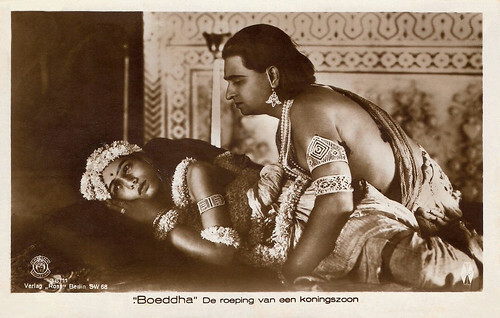
German postcard with Dutch imprint by Ross Verlag, Berlin, no. 36/11. Photo: Emelka Konzern. Still from Prem Sanyas/Die Leuchte Asiens/The Light of Asia (Franz Osten, Himansu Rai, 1925).
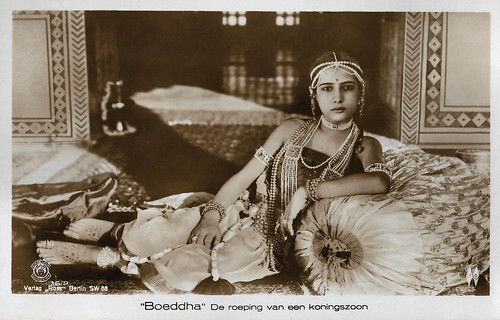
German postcard with Dutch imprint by Ross Verlag, Berlin, no. 36/9. Photo: Emelka Konzern. Seeta Devi in Prem Sanyas or Die Leuchte Asiens/The Light of Asia (Franz Osten, Himansu Rai, 1925). The Dutch title is 'Boeddha - de roeping van een koningszoon'.
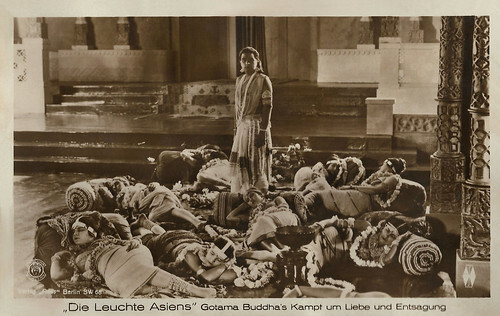
German postcard by Ross Verlag, Berlin. Photo: Emelka Konzern. Himansu Rai in Prem Sanyas or Die Leuchte Asiens/The Light of Asia (Franz Osten, Himansu Rai, 1925). Caption: Gotoma leaves his palace to become a beggar from the king's son. One of the many dramatic scenes from the new film of the Münchener Lichtspielkunst, The Light of Asia, which Franz Osten created as the first German large-scale film with the participation and support of the indigenous princes of the historical cities of India in several months of joint work by Indians and Europeans. An overwhelming picture of oriental splendour and exotic beauty.
Seeta Devi
The translation of the text on the back of the Dutch postcard above (no. 36/11) reads:
Seeta Devis (sic) plays in the new Indian film by Emelka: ‘Boeddha, De roeping van een koningszoon’, the role of Princess Gopa. Like all the other actors in the film, she is not a professional but was especially for this part discovered by director Franz Osten. When Osten heard that she would be the perfect type he was looking for, he travelled for 56 hours by train through burning hot India. And he made this beautiful, only 16-year-old Indian girl a film star.
In fact, the birthname of Seeta Devi (1912-1983) was Renee Smith and she was only 13 at the time. This film, which was officially called Prem Sanyas or Die Leuchte Asiens/The Light of Asia (1925), was her camera debut. Seeta Devi would act in ten more films.
Prem Sanyas was an Indo-German co-production, which was co-directed by Franz Osten and by the other actor on the postcard, Himansu Rai, with German technicians and Indian actors. The film managed to steer clear of the usual exotic depiction of Indian culture favoured by Western filmmakers up until then.
Prem Sanyas was the first Indian co-production and was made with the cooperation of the Maharajah of Jaipur. The film contained a cast of thousands. The shooting took place in Lahore, in what is now Pakistan, where the set decoration was created by Devika Rani, the wife of actor/director Himansu Rai and a noted actress herself.
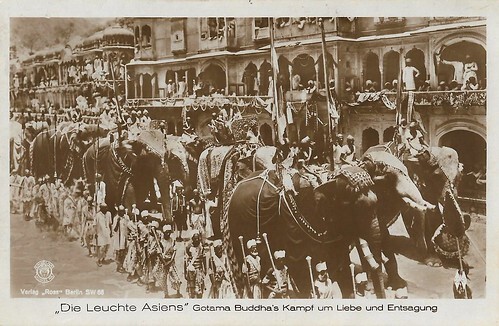
Vintage German postcard by Ross Verlag, Berlin. Photo: Emelka Konzern. Himansu Rai in Prem Sanyas or Die Leuchte Asiens/The Light of Asia (Franz Osten, Himansu Rai, 1925). Bayern Films. Caption: The Light of Asia. Gautama's fight for love and renunciation. Yet, the back of the card has another caption, relating to the scene on this card: "The Parade of Gotama and Gopa's Wedding. For the shooting of this scene, the Indian Rajah's command brought together thousands of people and animals. An endless cavalcade of camel riders opened the cortege as the vanguard, after which hundreds of festively decorated elephants followed. Just to give an example of India's richness, which was displayed at this occasion, it should be mentioned that just the hangings on these state elephants already represent some 300.000 Rupees, equal to 400.000 Gold Marks."
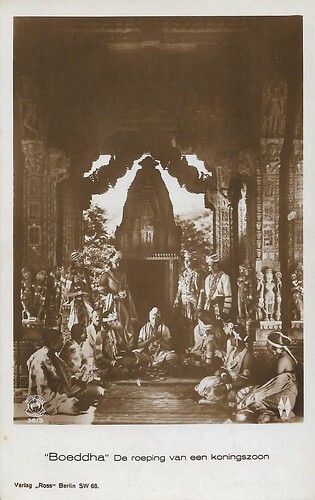
Dutch version of German postcard by Ross Verlag, Berlin, no. 36/3. Photo: Emelka Konzern. Dutch film title: Boeddha. De roeping van een koningszoon (Buddha. The Calling of a Royal Prince). Himansu Rai and Seeta Devi in Prem Sanyas or Die Leuchte Asiens/The Light of Asia (Franz Osten, Himansu Rai, 1925). This card was made for the release of the film at the Amsterdam Tuschinski Theater, where the film was shown from Friday 26 March 1926. Caption on the back: "Gotama and Gop's Mariage. One of the many picturesque scenes from the Indian film by Emelka, "Buddha. The Calling of a Royal Prince". which Franz Osten shot at the historical locations in India, with the collaboration of the Indian aristocracy. An overwhelming image of the opulence and exotic beauty."
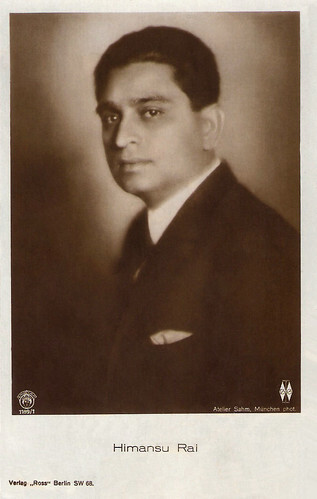
German postcard by Ross Verlag, Berlin, no. 1189/1, 1927-1928. Photo: Atelier Sahm, München (Munich) / Emelka. Himansu Rai .
Bombay talkies
Actor/director Himansu Rai (1895-1940) was born into a wealthy Bengali family. While training as a lawyer in London in the early 1920s, he began to act in plays. In London, he met his later wife Devika Rani who designed film sets and would continue to work with him.
In 1933, he joined forces with the IBP of England and wholly produced Karma/Fate (J.L. Freer-Hunt, 1933), a bilingual film in English and Hindi. But the Nazi seizure of power in Germany caused Rai to abandon international co-productions and so he decided to concentrate on the domestic film market in India.
In 1934, he formed Bombay Talkies Ltd. and built a studio. Under his painstaking supervision, it purchased the most modern equipment from Germany. Franz Osten and a handful of technicians came down from England and Germany to work with him.
By 1935, a stream of Hindi productions had begun to emerge from the studio. The advent of World War II meant that the studio's German technicians as well as director Osten were interned by the British, which crippled the studio.
Overwork and mental strain eventually took their toll on Rai, who suffered a nervous breakdown which he never recovered from. Himansu Rai died in 1940.
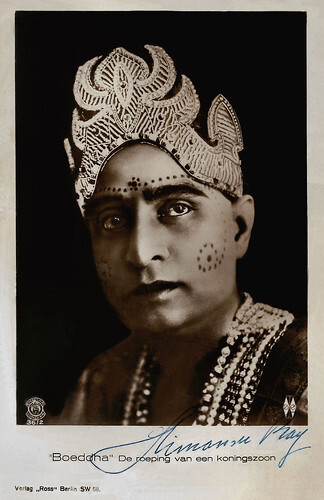
German postcard by Ross Verlag, Berlin, no. 36/2. Photo: Emelka Konzern. Himansu Rai in Prem Sanyas or Die Leuchte Asiens/The Light of Asia (Franz Osten, Himansu Rai, 1925). Collection: Didier Hanson.
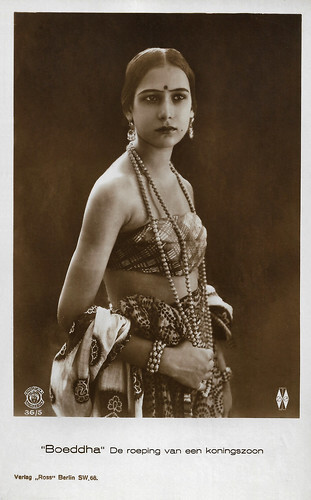
German postcard with Dutch imprint by Ross Verlag, Berlin, no. 36/5. Photo: Emelka Konzern. Seeta Devi in Prem Sanyas or Die Leuchte Asiens/The Light of Asia (Franz Osten, Himansu Rai, 1925). The Dutch title is 'Boeddha - de roeping van een koningszoon'.
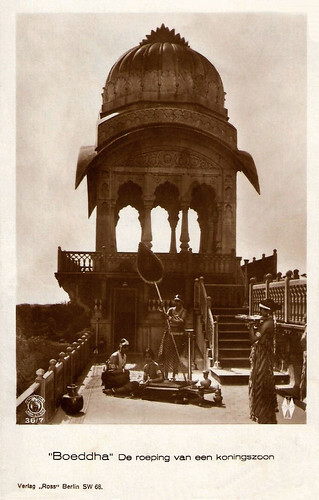
German postcard with Dutch imprint by Ross Verlag, Berlin, no. 36/7. Photo: Emelka Konzern. Still from Prem Sanyas or Die Leuchte Asiens/The Light of Asia (Franz Osten, Himansu Rai, 1925).
Unforgettable architectural beauty
The translation of the Dutch text on the back of the Dutch postcard above (no. 36/7) reads Gotama’s Palace in the Garden of Wonders. One of the scenes, playing in the old historic India gives the Emelka film ‘Boeddha, de roeping van een koningszoon' such a special charm. Thanks to the cooperation of the Indian royalty it was possible for Franz Osten to film all the scenes on historic locations. He used all the buildings with their unforgettable architectural beauty, and their wealth of sculptures and reliefs, splendidly. That’s how a film was produced that will be unsurpassable. ‘Boeddha’ will be shown from Friday 26 March in Theater Tuschinski.
Nowadays, Theater Tuschinski in Amsterdam is still the main movie palace in The Netherlands. These special postcards for the release of Prem Sanyas indicate that this German-Indian film must have been a big, commercial production at the time. Prem Sanyas or Die Leuchte Asiens was an adaptation of an Orientalist epic 'The Light of Asia' (1879) in verse, by British author Edwin Arnold. It was based on the life of Prince Siddhartha Gautama, who founded Buddhism in the sixth century BCE by becoming the Buddha or the 'Enlightened one'.
The film opens with documentary shots of tourists in Bombay watching street performers. Then a white-bearded old man sitting under the bodhi tree tells the tourists the story of Gautama ( Himansu Rai ), son of King Suddodhana (Sarada Ukil) and Queen Maya. In fear of a prophecy that he would renounce all worldly things, his father surrounded him with riches and beautiful women. But Gautama’s favour belonged solely to the princess Gopa ( Seeta Devi ). His rival for her affections is his cousin Devadatta (Profulla Chandra), but Gautama wins her as his wife and the couple lives in seclusion on an idyllic island.
However, when he leaves the island and is confronted with ageing, illness, and death, he faces a choice between wealth and inner greatness …. The religious epic, with its idealised figures, takes up the narrative in flashback and ends with Gopa kneeling before Gautama asking to become his disciple. The film exhibits a strange but fascinating hybrid between exoticism and authenticity.
Filmportal.de : "This magnificent, monumental film is a combination of oriental fairytale and religious Passion Play, an early form of the Hindu cinema that would later become Bollywood. Embedded in a documentary travelogue, cinema makes an appearance alongside older, magical practices. People no longer hope for enlightenment under the bodhi tree, but rather from a film projector." In 2001, the film was restored by Arte.
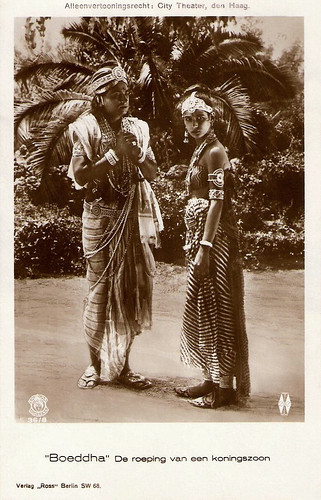
German postcard with Dutch imprint by Ross Verlag, Berlin, no. 36/8. Photo: Emelka Konzern. Still from Prem Sanyas or Die Leuchte Asiens/The Light of Asia (Franz Osten, Himansu Rai, 1925).
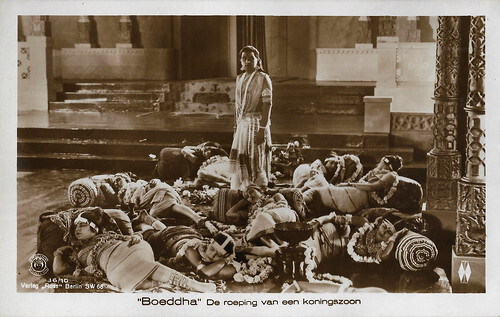
German postcard with Dutch imprint by Ross Verlag, Berlin, no. 36/10. Photo: Emelka Konzern. Himansu Rai in Prem Sanyas or Die Leuchte Asiens/The Light of Asia (Franz Osten, Himansu Rai, 1925).
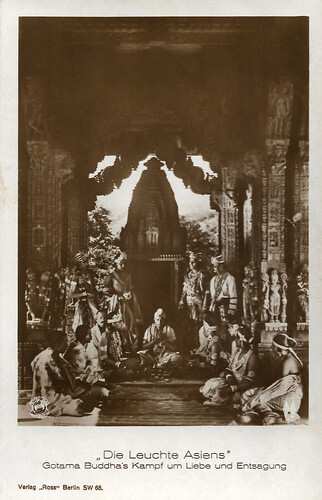
German postcard by Ross Verlag, Berlin. Photo: Emelka Konzern. Himansu Rai and Seeta Devi in Prem Sanyas or Die Leuchte Asiens/The Light of Asia (Franz Osten, Himansu Rai, 1925). Caption: Gotama and Gopa's wedding ceremony.
10,000 extras, 1,000 horses, and 50 elephants
The climax of German film pioneer Franz Osten's cinematic sojourn in India was Prapancha Pash/Schicksalswürfel/A Throw of Dice (Franz Osten, 1929) which he made again with a mixed Indian and European cast and crew.
In this 'fairy tale for adults' inspired by the ancient Sanskrit epic poem 'The Mahabharata', royal cousins and rulers of adjoining kingdoms King Sohat (producer/star Himansu Rai ) and King Rajit (Charu Roy) share a reckless passion for gambling and the perilous jungle tiger hunt.
Sohan plots to kill Ranjit and make his kingdom his own. Sohan's plot fails though and Ranjit is only wounded during his hunting 'accident' and is saved by a local healer.
While staying in this village, Ranjit meets the beautiful Sunita ( Seeta Devi ) and decides to make her his wife. Her father refuses due to Ranjit's famed gambling habit but when Sohan gets wind of the lovers' planned elopement, he comes up with another evil plot.
The result is a lavish silent super-production comprising 10,000 extras, 1,000 horses, and 50 elephants provided by the royal houses of Jaipur, Udaipur, and Mysore.
Prem Sanyas or Die Leuchte Asiens (Franz Osten, Himansu Rai, 1925). Source: Medulla Productions (YouTube).
Prapancha Pash/A Throw of Dice (Franz Osten, 1929). Source: Infotainment archive (YouTube).
Sources: Filmportal.de, Wikipedia, IMDb, and the postcards in this post.

German postcard with Dutch imprint by Ross Verlag, Berlin, no. 36/11. Photo: Emelka Konzern. Still from Prem Sanyas/Die Leuchte Asiens/The Light of Asia (Franz Osten, Himansu Rai, 1925).

German postcard with Dutch imprint by Ross Verlag, Berlin, no. 36/9. Photo: Emelka Konzern. Seeta Devi in Prem Sanyas or Die Leuchte Asiens/The Light of Asia (Franz Osten, Himansu Rai, 1925). The Dutch title is 'Boeddha - de roeping van een koningszoon'.

German postcard by Ross Verlag, Berlin. Photo: Emelka Konzern. Himansu Rai in Prem Sanyas or Die Leuchte Asiens/The Light of Asia (Franz Osten, Himansu Rai, 1925). Caption: Gotoma leaves his palace to become a beggar from the king's son. One of the many dramatic scenes from the new film of the Münchener Lichtspielkunst, The Light of Asia, which Franz Osten created as the first German large-scale film with the participation and support of the indigenous princes of the historical cities of India in several months of joint work by Indians and Europeans. An overwhelming picture of oriental splendour and exotic beauty.
Seeta Devi
The translation of the text on the back of the Dutch postcard above (no. 36/11) reads:
Seeta Devis (sic) plays in the new Indian film by Emelka: ‘Boeddha, De roeping van een koningszoon’, the role of Princess Gopa. Like all the other actors in the film, she is not a professional but was especially for this part discovered by director Franz Osten. When Osten heard that she would be the perfect type he was looking for, he travelled for 56 hours by train through burning hot India. And he made this beautiful, only 16-year-old Indian girl a film star.
In fact, the birthname of Seeta Devi (1912-1983) was Renee Smith and she was only 13 at the time. This film, which was officially called Prem Sanyas or Die Leuchte Asiens/The Light of Asia (1925), was her camera debut. Seeta Devi would act in ten more films.
Prem Sanyas was an Indo-German co-production, which was co-directed by Franz Osten and by the other actor on the postcard, Himansu Rai, with German technicians and Indian actors. The film managed to steer clear of the usual exotic depiction of Indian culture favoured by Western filmmakers up until then.
Prem Sanyas was the first Indian co-production and was made with the cooperation of the Maharajah of Jaipur. The film contained a cast of thousands. The shooting took place in Lahore, in what is now Pakistan, where the set decoration was created by Devika Rani, the wife of actor/director Himansu Rai and a noted actress herself.

Vintage German postcard by Ross Verlag, Berlin. Photo: Emelka Konzern. Himansu Rai in Prem Sanyas or Die Leuchte Asiens/The Light of Asia (Franz Osten, Himansu Rai, 1925). Bayern Films. Caption: The Light of Asia. Gautama's fight for love and renunciation. Yet, the back of the card has another caption, relating to the scene on this card: "The Parade of Gotama and Gopa's Wedding. For the shooting of this scene, the Indian Rajah's command brought together thousands of people and animals. An endless cavalcade of camel riders opened the cortege as the vanguard, after which hundreds of festively decorated elephants followed. Just to give an example of India's richness, which was displayed at this occasion, it should be mentioned that just the hangings on these state elephants already represent some 300.000 Rupees, equal to 400.000 Gold Marks."

Dutch version of German postcard by Ross Verlag, Berlin, no. 36/3. Photo: Emelka Konzern. Dutch film title: Boeddha. De roeping van een koningszoon (Buddha. The Calling of a Royal Prince). Himansu Rai and Seeta Devi in Prem Sanyas or Die Leuchte Asiens/The Light of Asia (Franz Osten, Himansu Rai, 1925). This card was made for the release of the film at the Amsterdam Tuschinski Theater, where the film was shown from Friday 26 March 1926. Caption on the back: "Gotama and Gop's Mariage. One of the many picturesque scenes from the Indian film by Emelka, "Buddha. The Calling of a Royal Prince". which Franz Osten shot at the historical locations in India, with the collaboration of the Indian aristocracy. An overwhelming image of the opulence and exotic beauty."

German postcard by Ross Verlag, Berlin, no. 1189/1, 1927-1928. Photo: Atelier Sahm, München (Munich) / Emelka. Himansu Rai .
Bombay talkies
Actor/director Himansu Rai (1895-1940) was born into a wealthy Bengali family. While training as a lawyer in London in the early 1920s, he began to act in plays. In London, he met his later wife Devika Rani who designed film sets and would continue to work with him.
In 1933, he joined forces with the IBP of England and wholly produced Karma/Fate (J.L. Freer-Hunt, 1933), a bilingual film in English and Hindi. But the Nazi seizure of power in Germany caused Rai to abandon international co-productions and so he decided to concentrate on the domestic film market in India.
In 1934, he formed Bombay Talkies Ltd. and built a studio. Under his painstaking supervision, it purchased the most modern equipment from Germany. Franz Osten and a handful of technicians came down from England and Germany to work with him.
By 1935, a stream of Hindi productions had begun to emerge from the studio. The advent of World War II meant that the studio's German technicians as well as director Osten were interned by the British, which crippled the studio.
Overwork and mental strain eventually took their toll on Rai, who suffered a nervous breakdown which he never recovered from. Himansu Rai died in 1940.

German postcard by Ross Verlag, Berlin, no. 36/2. Photo: Emelka Konzern. Himansu Rai in Prem Sanyas or Die Leuchte Asiens/The Light of Asia (Franz Osten, Himansu Rai, 1925). Collection: Didier Hanson.

German postcard with Dutch imprint by Ross Verlag, Berlin, no. 36/5. Photo: Emelka Konzern. Seeta Devi in Prem Sanyas or Die Leuchte Asiens/The Light of Asia (Franz Osten, Himansu Rai, 1925). The Dutch title is 'Boeddha - de roeping van een koningszoon'.

German postcard with Dutch imprint by Ross Verlag, Berlin, no. 36/7. Photo: Emelka Konzern. Still from Prem Sanyas or Die Leuchte Asiens/The Light of Asia (Franz Osten, Himansu Rai, 1925).
Unforgettable architectural beauty
The translation of the Dutch text on the back of the Dutch postcard above (no. 36/7) reads Gotama’s Palace in the Garden of Wonders. One of the scenes, playing in the old historic India gives the Emelka film ‘Boeddha, de roeping van een koningszoon' such a special charm. Thanks to the cooperation of the Indian royalty it was possible for Franz Osten to film all the scenes on historic locations. He used all the buildings with their unforgettable architectural beauty, and their wealth of sculptures and reliefs, splendidly. That’s how a film was produced that will be unsurpassable. ‘Boeddha’ will be shown from Friday 26 March in Theater Tuschinski.
Nowadays, Theater Tuschinski in Amsterdam is still the main movie palace in The Netherlands. These special postcards for the release of Prem Sanyas indicate that this German-Indian film must have been a big, commercial production at the time. Prem Sanyas or Die Leuchte Asiens was an adaptation of an Orientalist epic 'The Light of Asia' (1879) in verse, by British author Edwin Arnold. It was based on the life of Prince Siddhartha Gautama, who founded Buddhism in the sixth century BCE by becoming the Buddha or the 'Enlightened one'.
The film opens with documentary shots of tourists in Bombay watching street performers. Then a white-bearded old man sitting under the bodhi tree tells the tourists the story of Gautama ( Himansu Rai ), son of King Suddodhana (Sarada Ukil) and Queen Maya. In fear of a prophecy that he would renounce all worldly things, his father surrounded him with riches and beautiful women. But Gautama’s favour belonged solely to the princess Gopa ( Seeta Devi ). His rival for her affections is his cousin Devadatta (Profulla Chandra), but Gautama wins her as his wife and the couple lives in seclusion on an idyllic island.
However, when he leaves the island and is confronted with ageing, illness, and death, he faces a choice between wealth and inner greatness …. The religious epic, with its idealised figures, takes up the narrative in flashback and ends with Gopa kneeling before Gautama asking to become his disciple. The film exhibits a strange but fascinating hybrid between exoticism and authenticity.
Filmportal.de : "This magnificent, monumental film is a combination of oriental fairytale and religious Passion Play, an early form of the Hindu cinema that would later become Bollywood. Embedded in a documentary travelogue, cinema makes an appearance alongside older, magical practices. People no longer hope for enlightenment under the bodhi tree, but rather from a film projector." In 2001, the film was restored by Arte.

German postcard with Dutch imprint by Ross Verlag, Berlin, no. 36/8. Photo: Emelka Konzern. Still from Prem Sanyas or Die Leuchte Asiens/The Light of Asia (Franz Osten, Himansu Rai, 1925).

German postcard with Dutch imprint by Ross Verlag, Berlin, no. 36/10. Photo: Emelka Konzern. Himansu Rai in Prem Sanyas or Die Leuchte Asiens/The Light of Asia (Franz Osten, Himansu Rai, 1925).

German postcard by Ross Verlag, Berlin. Photo: Emelka Konzern. Himansu Rai and Seeta Devi in Prem Sanyas or Die Leuchte Asiens/The Light of Asia (Franz Osten, Himansu Rai, 1925). Caption: Gotama and Gopa's wedding ceremony.
10,000 extras, 1,000 horses, and 50 elephants
The climax of German film pioneer Franz Osten's cinematic sojourn in India was Prapancha Pash/Schicksalswürfel/A Throw of Dice (Franz Osten, 1929) which he made again with a mixed Indian and European cast and crew.
In this 'fairy tale for adults' inspired by the ancient Sanskrit epic poem 'The Mahabharata', royal cousins and rulers of adjoining kingdoms King Sohat (producer/star Himansu Rai ) and King Rajit (Charu Roy) share a reckless passion for gambling and the perilous jungle tiger hunt.
Sohan plots to kill Ranjit and make his kingdom his own. Sohan's plot fails though and Ranjit is only wounded during his hunting 'accident' and is saved by a local healer.
While staying in this village, Ranjit meets the beautiful Sunita ( Seeta Devi ) and decides to make her his wife. Her father refuses due to Ranjit's famed gambling habit but when Sohan gets wind of the lovers' planned elopement, he comes up with another evil plot.
The result is a lavish silent super-production comprising 10,000 extras, 1,000 horses, and 50 elephants provided by the royal houses of Jaipur, Udaipur, and Mysore.
Prem Sanyas or Die Leuchte Asiens (Franz Osten, Himansu Rai, 1925). Source: Medulla Productions (YouTube).
Prapancha Pash/A Throw of Dice (Franz Osten, 1929). Source: Infotainment archive (YouTube).
Sources: Filmportal.de, Wikipedia, IMDb, and the postcards in this post.
Published on January 16, 2024 22:00
January 15, 2024
Ruth Roland
Ruth Roland (1892–1937) was an American stage and film actress and film producer. She was called the 'Queen of the early Thriller Serials'. In the late 1910s and early 1920s, she appeared in 11 serials, each cementing her popularity. Between 1908 and 1935, she had acted in over 200 films.
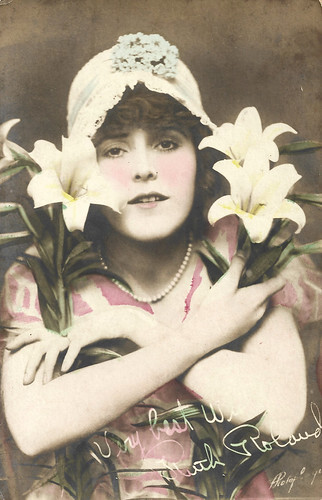
American (or British) postcard. Photo: Photoplayer, L.A.
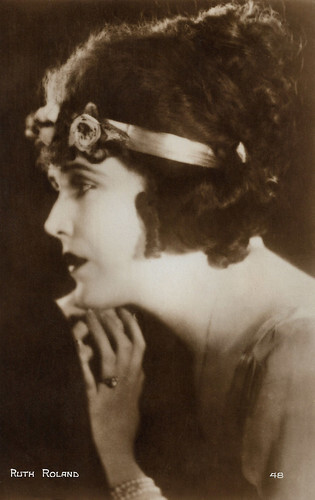
French postcard by Editions Cinémagazine, no. 48.
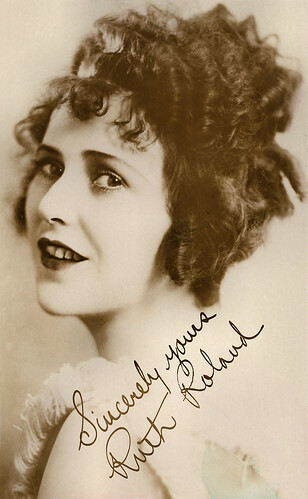
American fan card by Pathé to promote the serial Ruth of the Rockies (George Marshall, 1920).
The leading actress of Kalem
Ruth Roland was born in 1892 in San Francisco, California, USA. She came from a show-business family. Her father, Jack Roland, was a San Francisco theatre manager and her mother, Elizabeth Lillian Hauser, was a professional singer.
Ruth made her acting debut at age three and a half and soon became a professional actress and singer. As a child star in stock and Vaudeville, she toured for five years under the name "Baby Ruth". After her parents' early divorce, she grew up with her mother until she died in 1900 when Ruth Roland was only eight years old.
An aunt then took in Los Angeles over her care. At age 12, she was the youngest student at Hollywood High School. Her Vaudeville act was spotted by Sidney Olcott and his Kalem Company during one of her performances in New York City. He recognised the potential of the then 16-year-old Roland and signed her up for his short film The Scarlet Letter, produced in 1908.
Along with Gene Gauntier, she was soon billed as a "Kalem Girl". Roland was courted by the producers of the time, including Mack Sennett , and her weekly salary was raised from an initial 25 dollars to 100 dollars. Roland was eventually sent to Kalem's West Coast studio in Santa Monica where she was the lead actress and overseer of Kalem House where all the actors lived. Between 1909 and 1914 she was the leading actress of Kalem and was especially good in Westerns and comedies.
From 1914 to 1917 she acted at Balboa Films, in popular serials such as the 14-episode adventure film serial The Red Circle (Sherwood MacDonald, 1915), distributed by Pathé Exchange, with Frank Mayo as her leading man. It was Roland's first serial. Sadly, only a trailer of the serial survives.
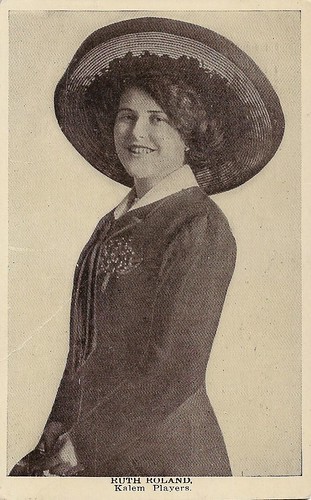
American postcard by The Ess and Ess Photo Co., New York. Photo: Kalem.
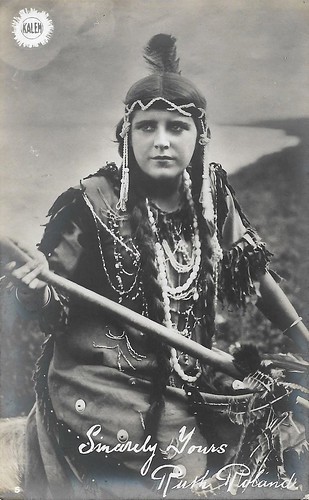
British postcard. Photo: Kalem. Ruth Roland as the Indian Wife in Her Indian Mother (Sidney Olcott, 1910).
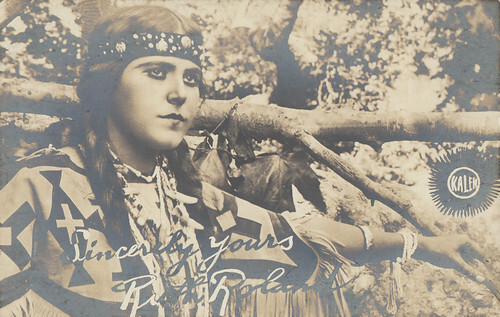
British postcard, no. 70. Photo: Kalem. Ruth Roland as the Indian Wife in Her Indian Mother (Sidney Olcott, 1910). Collection: Marlene Pilaete.
A nitrate collection found in her backyard
A clever businesswoman, Ruth Roland established her own production company, Ruth Roland Serials. She appeared in an early colour feature film Cupid Angling (Louis W. Chauder, 1918). It was the only feature film made in the Natural Color process invented by Leon F. Douglass.
Roland signed a distribution deal with Pathé to make seven new multi-episode serials that proved very successful, e.g. the crime serial The Adventures of Ruth (George Marshall, 1919) and the Western serial Ruth of the Rockies (George Marshall, 1920).
By 1927, Ruth Roland had appeared in 211 silent films, four of which she produced herself between 1919 and 1922 with her own company, Ruth Roland Serials. She decided she had had enough and didn't renew her contract. She didn't need the money, as she had amassed a fortune. She returned to Vaudeville, and spent the next few years on the stage, with a film or two along the way.
When sound came to motion pictures in 1929 she decided to try that medium. The film she made, Reno (George Crone, 1930) with Montagu Love, was not successful, and she retired from the screen after one more film, the mystery From Nine to Nine (Edgar G. Ulmer, 1935).
Ruth Roland was married to Lionel T. Kent from 1917 to 1919 and to actor Ben Bard, from 1929 to her death. Both marriages remained childless. Reclusive and largely forgotten by the public, Ruth Roland died of cancer in September 1937, aged just 45. In 1979 a concrete box with Roland's private nitrate film collection was found in her backyard and donated to the UCLA Film Archive, including the complete 12-part serial Who Pays? (Harry Harvey, H.M. Horkheimer, Henry King, 1915) with Roland herself in the lead opposite Henry King who also co-directed.
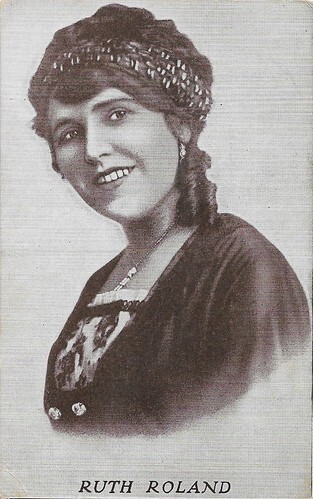
American postcard. It refers to the release of the serial Hands Up (Louis J. Gasnier, James W. Horne, 1918).
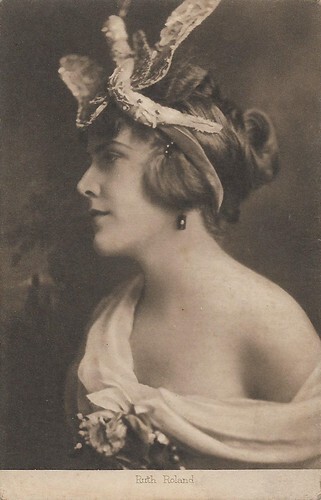
British postcard. Photo: Pathé Frères Cinema Ltd.
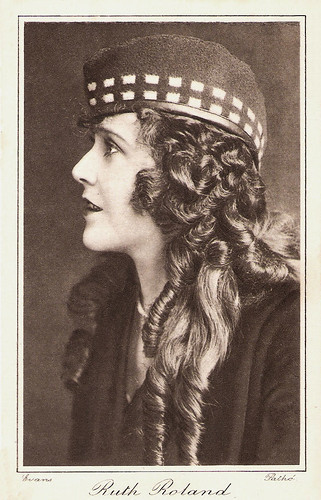
British postcard by Cinema Chat. Photo: Evans / Pathé.
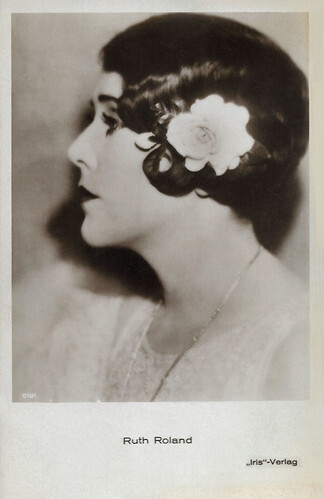
Austrian postcard by Iris Verlag, no. 5191.
Sources: Wikipedia (English, German and Dutch) and .

American (or British) postcard. Photo: Photoplayer, L.A.

French postcard by Editions Cinémagazine, no. 48.

American fan card by Pathé to promote the serial Ruth of the Rockies (George Marshall, 1920).
The leading actress of Kalem
Ruth Roland was born in 1892 in San Francisco, California, USA. She came from a show-business family. Her father, Jack Roland, was a San Francisco theatre manager and her mother, Elizabeth Lillian Hauser, was a professional singer.
Ruth made her acting debut at age three and a half and soon became a professional actress and singer. As a child star in stock and Vaudeville, she toured for five years under the name "Baby Ruth". After her parents' early divorce, she grew up with her mother until she died in 1900 when Ruth Roland was only eight years old.
An aunt then took in Los Angeles over her care. At age 12, she was the youngest student at Hollywood High School. Her Vaudeville act was spotted by Sidney Olcott and his Kalem Company during one of her performances in New York City. He recognised the potential of the then 16-year-old Roland and signed her up for his short film The Scarlet Letter, produced in 1908.
Along with Gene Gauntier, she was soon billed as a "Kalem Girl". Roland was courted by the producers of the time, including Mack Sennett , and her weekly salary was raised from an initial 25 dollars to 100 dollars. Roland was eventually sent to Kalem's West Coast studio in Santa Monica where she was the lead actress and overseer of Kalem House where all the actors lived. Between 1909 and 1914 she was the leading actress of Kalem and was especially good in Westerns and comedies.
From 1914 to 1917 she acted at Balboa Films, in popular serials such as the 14-episode adventure film serial The Red Circle (Sherwood MacDonald, 1915), distributed by Pathé Exchange, with Frank Mayo as her leading man. It was Roland's first serial. Sadly, only a trailer of the serial survives.

American postcard by The Ess and Ess Photo Co., New York. Photo: Kalem.

British postcard. Photo: Kalem. Ruth Roland as the Indian Wife in Her Indian Mother (Sidney Olcott, 1910).

British postcard, no. 70. Photo: Kalem. Ruth Roland as the Indian Wife in Her Indian Mother (Sidney Olcott, 1910). Collection: Marlene Pilaete.
A nitrate collection found in her backyard
A clever businesswoman, Ruth Roland established her own production company, Ruth Roland Serials. She appeared in an early colour feature film Cupid Angling (Louis W. Chauder, 1918). It was the only feature film made in the Natural Color process invented by Leon F. Douglass.
Roland signed a distribution deal with Pathé to make seven new multi-episode serials that proved very successful, e.g. the crime serial The Adventures of Ruth (George Marshall, 1919) and the Western serial Ruth of the Rockies (George Marshall, 1920).
By 1927, Ruth Roland had appeared in 211 silent films, four of which she produced herself between 1919 and 1922 with her own company, Ruth Roland Serials. She decided she had had enough and didn't renew her contract. She didn't need the money, as she had amassed a fortune. She returned to Vaudeville, and spent the next few years on the stage, with a film or two along the way.
When sound came to motion pictures in 1929 she decided to try that medium. The film she made, Reno (George Crone, 1930) with Montagu Love, was not successful, and she retired from the screen after one more film, the mystery From Nine to Nine (Edgar G. Ulmer, 1935).
Ruth Roland was married to Lionel T. Kent from 1917 to 1919 and to actor Ben Bard, from 1929 to her death. Both marriages remained childless. Reclusive and largely forgotten by the public, Ruth Roland died of cancer in September 1937, aged just 45. In 1979 a concrete box with Roland's private nitrate film collection was found in her backyard and donated to the UCLA Film Archive, including the complete 12-part serial Who Pays? (Harry Harvey, H.M. Horkheimer, Henry King, 1915) with Roland herself in the lead opposite Henry King who also co-directed.

American postcard. It refers to the release of the serial Hands Up (Louis J. Gasnier, James W. Horne, 1918).

British postcard. Photo: Pathé Frères Cinema Ltd.

British postcard by Cinema Chat. Photo: Evans / Pathé.

Austrian postcard by Iris Verlag, no. 5191.
Sources: Wikipedia (English, German and Dutch) and .
Published on January 15, 2024 22:00
January 14, 2024
Will Rogers
Will Rogers (1879-1935) was an American entertainer, radio personality, film actor, and writer who was famous for his pithy and homespun humour and social commentary. He made 71 films (50 silent and 21 sound films) and wrote more than 4,000 newspaper columns. By the mid-1930s, Rogers was hugely popular in the United States for his leading political wit and was the highest-paid of Hollywood film stars. He died in 1935 with aviator Wiley Post when their small aeroplane crashed in northern Alaska.
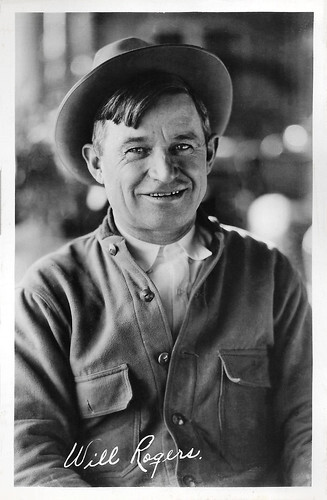
American postcard by Los Angeles Photo Post Card Co.
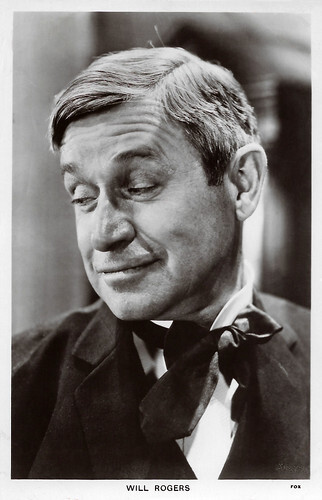
British postcard in the Picturegoer Series, London, no. W. 698. Photo: Fox.
Oklahoma's Favorite Son
William Penn Adair Rogers was born in 1879 on his parents' Dog Iron Ranch in Oologah in the Cherokee Nation of Indian Territory, near present-day Claremore, Oklahoma. Rogers is known as "Oklahoma's Favorite Son". His parents, Clement V. (Clem) Rogers and Mary America Schrimsher, were both mixed-race with Cherokee ancestry and considered themselves Cherokee. Clement, was an attorney and Cherokee judge and a leader in the Cherokee Nation.
Rogers learned how to ride a horse and do rope tricks while growing up on a ranch in what would eventually become Oklahoma. In 1899, Rogers appeared at the St. Louis Fair as part of the Mulhall Rodeo. Near the end of 1901, when he was 22 years old, he and a friend left home hoping to work as gauchos in Argentina. They spent five months trying to make it as ranch owners in the Pampas but lost all their money.
Rogers sailed for South Africa and there, he began his show business career as a trick roper with horse and lasso in 'Texas Jack's Wild West Circus'. When he quit the circus, he went to Australia. Texas Jack gave him a reference letter for the Wirth Brothers Circus there, and Rogers continued to perform as a rider and trick roper and worked on his pony act.
He returned to the United States in 1904, appeared at the Saint Louis World's Fair, and began to try his roping skills on the vaudeville circuits. In 1905 he performed in a show at Madison Square Garden. The good reviews prompted his decision to stay in New York City and work in vaudeville.
When a wild steer broke out of the arena and began to climb into the viewing stands. Rogers roped the steer to the delight of the crowd. The feat got front-page attention from the newspapers, giving him valuable publicity and an audience eager to see more. Willie Hammerstein saw his vaudeville act and signed Rogers to appear on the Victoria Roof — which was literally on a rooftop — with his pony.
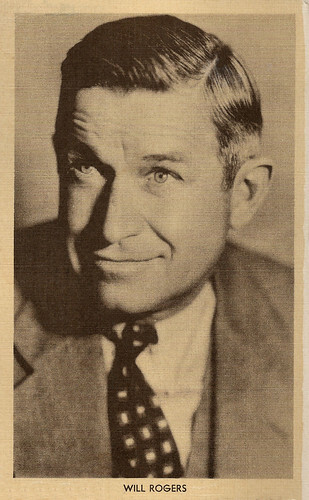
American postcard by Mid West Map Co., Aurora, Montana, for The Mason Hotel / The Radium Bathhouse, Claremont, Oklahoma. Sent by mail in 1943.
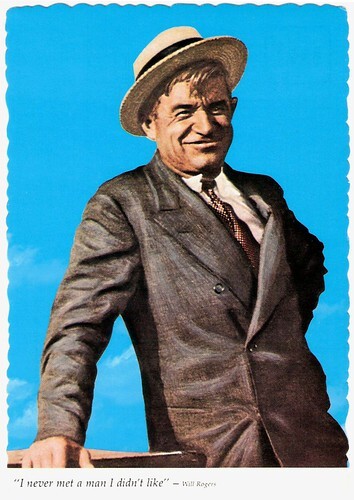
American postcard by Storer S Cards, Tulsa, Oklahoma, no. S-616. Caption: Will Rogers - America's beloved cowboy humorist - columnist - ambassador at large.
I never met a man I didn't like
In 1912, Will Rogers appeared in his first Broadway show, 'The Wall Street Girl' and demonstrated his roping skills between acts. He did the same in a few less successful shows in 1915, but he impressed producer Flo Ziegfeld enough to be hired later that year for the cast of 'Ziegfeld’s Midnight Frolic'. Upon discovering that audiences loved his Western drawl, he began to ad-lib patter in his previously silent act.
To keep his act fresh, Rogers poked fun at prominent audience members and commented on the events of the day, especially political news. At one performance, with President Woodrow Wilson in the audience, Rogers improvised a "roast" of presidential policies that had Wilson, and the entire audience, in stitches.
Gently kidding Democrats and Republicans alike, Rogers became a master of the political one-liner, such as “Every time Congress makes a joke it’s law, and every time they make a law it’s a joke.” From 'Midnight Frolic', Rogers moved to the prestigious 'Ziegfeld Follies', on Broadway in 1916, a yearly production to which he frequently returned until 1925.
In 1922 his weekly articles for the New York Times became so popular that they appeared in more than 500 U.S. newspapers daily. An editorial in The New York Times said that "Will Rogers in the Follies is carrying on the tradition of Aristophanes, and not unworthily." His column and his radio appearances increased his visibility and popularity.
Rogers's earthy anecdotes and folksy style allowed him to poke fun at gangsters, prohibition, politicians, government programs, and a host of other controversial topics in a way that found general acclaim from a national audience with no one offended. His aphorisms, couched in humorous terms, were widely quoted, for example, "I am not a member of an organized political party. I am a Democrat." One of Rogers's most famous sayings was "I never met a man I didn't like".
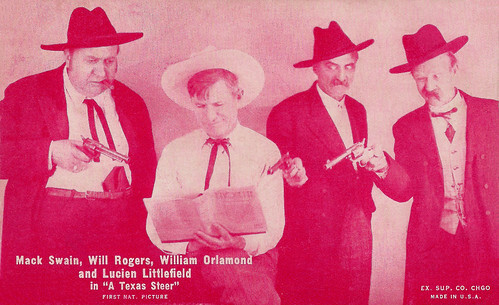
American Arcade card by Ex. Sup. Co, Chicago. Photo: First National Pictures. Will Rogers, Mack Swain, William Orlamond and Lucien Littlefield in A Texas Steer (Richard Wallace, 1927).
Honorary mayor of Beverly Hills
In 1918 Will Rogers starred in his first film, Laughing Bill Hyde (Hobart Henley, 1918). A three-year contract with producer Samuel Goldwyn, at triple the Broadway salary, moved Rogers west. He bought a ranch in Pacific Palisades and set up his own production company. Though Rogers would never admit to being anything but an amateur actor, critics appreciated his natural charm and appealingly plain face.
For the next few years, he appeared in silent features for Goldwyn, as well as several comedies he produced himself and a series of Hal Roach two-reelers that made light of Hollywood and Washington. Among the films he made for Roach in 1924 were three directed by Rob Wagner: Two Wagons Both Covered, Going to Congress, and Our Congressman. He wrote many of the title cards appearing in his films.
Rogers also wrote books, articles, and a syndicated newspaper column; he frequently performed on radio and was a popular after-dinner speaker. In 1929 with the arrival of sound film, Rogers signed a movie contract with the Fox Film Corporation and made his first talking picture, the comedy They Had to See Paris (Frank Borzage, 1929) with Irene Rich . He played a wealthy American oil tycoon who travels to Paris with his family at his wife's request, despite the fact he hates the French.
Sound films suited the talkative Rogers, and his popular films made him a bigger star than ever before. A success was A Connecticut Yankee (David Butler, 1931), based on Mark Twain’s humorous novel. His favourite director was John Ford, who directed him three times. He played a homespun farmer in State Fair (Henry King, 1933) with Janet Gaynor , an old-fashioned doctor in Dr. Bull (John Ford, 1933), a small-town banker in David Harum (James Cruze, 1934), and a rustic politician in Judge Priest (John Ford, 1934). He also acted in The County Chairman (John G. Blystone, 1935), Steamboat Round the Bend (John Ford, 1935), and In Old Kentucky (George Marshall, 1935).
In politics, Rogers preferred to remain an observer, but he spent a few weeks in 1926 as honorary mayor of Beverly Hills until California legislation declared his position illegal (“I ain’t the first mayor that’s been kicked out,” he mused), and he was a supporter of Franklin Delano Roosevelt’s presidential candidacy. In 1935, at the height of his popularity, Rogers died in a plane crash near Point Barrow, Alaska. His last two films, Steamboat ’Round the Bend and In Old Kentucky, were released posthumously the same year. In 1935, Will Rogers died in the Arctic crash of a plane piloted by the world-renowned, one-eyed pioneer aviator, Wiley Post, near Point Barrow, Alaska. Post died as well. Will Rogers was buried in Claremore, Oklahoma, at the Will Rogers Memorial, now a popular tourist attraction. Since 1908 Rogers was married to Betty Blake Rogers and they had four children, Fred, Mary, Will Rogers Jr. and Jimmy Rogers. Will Rogers was portrayed by his son, Will Rogers Jr., in the film, The Story of Will Rogers (Michael Curtiz, 1952) with Jane Wyman as Betty.
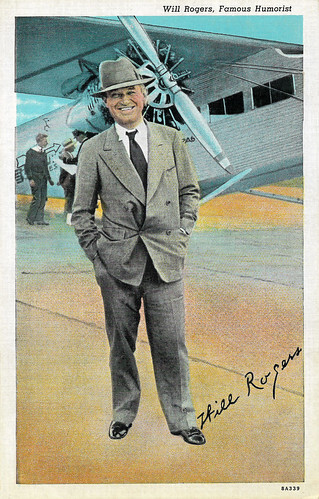
American postcard in the "C.T. American Art" series by Curteich, Chicago / Mid-Continet News Co. Oklahoma City, Okl., no. 8A339. Sent by mail in 1940.
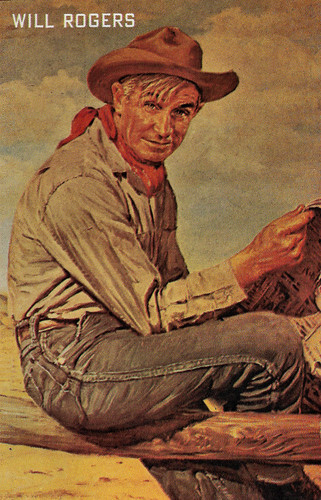
American 'Mirro-Krome' postcard by H.S. Crocker Co. Inc., Oklahoma City, Oklahoma, no. SCC-303. Photo: Donald Cantrell. Caption: Photo of a portrait of Will Rogers world citizen and Oklahoma's favorite son.
Sources: Britannica, Wikipedia and .

American postcard by Los Angeles Photo Post Card Co.

British postcard in the Picturegoer Series, London, no. W. 698. Photo: Fox.
Oklahoma's Favorite Son
William Penn Adair Rogers was born in 1879 on his parents' Dog Iron Ranch in Oologah in the Cherokee Nation of Indian Territory, near present-day Claremore, Oklahoma. Rogers is known as "Oklahoma's Favorite Son". His parents, Clement V. (Clem) Rogers and Mary America Schrimsher, were both mixed-race with Cherokee ancestry and considered themselves Cherokee. Clement, was an attorney and Cherokee judge and a leader in the Cherokee Nation.
Rogers learned how to ride a horse and do rope tricks while growing up on a ranch in what would eventually become Oklahoma. In 1899, Rogers appeared at the St. Louis Fair as part of the Mulhall Rodeo. Near the end of 1901, when he was 22 years old, he and a friend left home hoping to work as gauchos in Argentina. They spent five months trying to make it as ranch owners in the Pampas but lost all their money.
Rogers sailed for South Africa and there, he began his show business career as a trick roper with horse and lasso in 'Texas Jack's Wild West Circus'. When he quit the circus, he went to Australia. Texas Jack gave him a reference letter for the Wirth Brothers Circus there, and Rogers continued to perform as a rider and trick roper and worked on his pony act.
He returned to the United States in 1904, appeared at the Saint Louis World's Fair, and began to try his roping skills on the vaudeville circuits. In 1905 he performed in a show at Madison Square Garden. The good reviews prompted his decision to stay in New York City and work in vaudeville.
When a wild steer broke out of the arena and began to climb into the viewing stands. Rogers roped the steer to the delight of the crowd. The feat got front-page attention from the newspapers, giving him valuable publicity and an audience eager to see more. Willie Hammerstein saw his vaudeville act and signed Rogers to appear on the Victoria Roof — which was literally on a rooftop — with his pony.

American postcard by Mid West Map Co., Aurora, Montana, for The Mason Hotel / The Radium Bathhouse, Claremont, Oklahoma. Sent by mail in 1943.

American postcard by Storer S Cards, Tulsa, Oklahoma, no. S-616. Caption: Will Rogers - America's beloved cowboy humorist - columnist - ambassador at large.
I never met a man I didn't like
In 1912, Will Rogers appeared in his first Broadway show, 'The Wall Street Girl' and demonstrated his roping skills between acts. He did the same in a few less successful shows in 1915, but he impressed producer Flo Ziegfeld enough to be hired later that year for the cast of 'Ziegfeld’s Midnight Frolic'. Upon discovering that audiences loved his Western drawl, he began to ad-lib patter in his previously silent act.
To keep his act fresh, Rogers poked fun at prominent audience members and commented on the events of the day, especially political news. At one performance, with President Woodrow Wilson in the audience, Rogers improvised a "roast" of presidential policies that had Wilson, and the entire audience, in stitches.
Gently kidding Democrats and Republicans alike, Rogers became a master of the political one-liner, such as “Every time Congress makes a joke it’s law, and every time they make a law it’s a joke.” From 'Midnight Frolic', Rogers moved to the prestigious 'Ziegfeld Follies', on Broadway in 1916, a yearly production to which he frequently returned until 1925.
In 1922 his weekly articles for the New York Times became so popular that they appeared in more than 500 U.S. newspapers daily. An editorial in The New York Times said that "Will Rogers in the Follies is carrying on the tradition of Aristophanes, and not unworthily." His column and his radio appearances increased his visibility and popularity.
Rogers's earthy anecdotes and folksy style allowed him to poke fun at gangsters, prohibition, politicians, government programs, and a host of other controversial topics in a way that found general acclaim from a national audience with no one offended. His aphorisms, couched in humorous terms, were widely quoted, for example, "I am not a member of an organized political party. I am a Democrat." One of Rogers's most famous sayings was "I never met a man I didn't like".

American Arcade card by Ex. Sup. Co, Chicago. Photo: First National Pictures. Will Rogers, Mack Swain, William Orlamond and Lucien Littlefield in A Texas Steer (Richard Wallace, 1927).
Honorary mayor of Beverly Hills
In 1918 Will Rogers starred in his first film, Laughing Bill Hyde (Hobart Henley, 1918). A three-year contract with producer Samuel Goldwyn, at triple the Broadway salary, moved Rogers west. He bought a ranch in Pacific Palisades and set up his own production company. Though Rogers would never admit to being anything but an amateur actor, critics appreciated his natural charm and appealingly plain face.
For the next few years, he appeared in silent features for Goldwyn, as well as several comedies he produced himself and a series of Hal Roach two-reelers that made light of Hollywood and Washington. Among the films he made for Roach in 1924 were three directed by Rob Wagner: Two Wagons Both Covered, Going to Congress, and Our Congressman. He wrote many of the title cards appearing in his films.
Rogers also wrote books, articles, and a syndicated newspaper column; he frequently performed on radio and was a popular after-dinner speaker. In 1929 with the arrival of sound film, Rogers signed a movie contract with the Fox Film Corporation and made his first talking picture, the comedy They Had to See Paris (Frank Borzage, 1929) with Irene Rich . He played a wealthy American oil tycoon who travels to Paris with his family at his wife's request, despite the fact he hates the French.
Sound films suited the talkative Rogers, and his popular films made him a bigger star than ever before. A success was A Connecticut Yankee (David Butler, 1931), based on Mark Twain’s humorous novel. His favourite director was John Ford, who directed him three times. He played a homespun farmer in State Fair (Henry King, 1933) with Janet Gaynor , an old-fashioned doctor in Dr. Bull (John Ford, 1933), a small-town banker in David Harum (James Cruze, 1934), and a rustic politician in Judge Priest (John Ford, 1934). He also acted in The County Chairman (John G. Blystone, 1935), Steamboat Round the Bend (John Ford, 1935), and In Old Kentucky (George Marshall, 1935).
In politics, Rogers preferred to remain an observer, but he spent a few weeks in 1926 as honorary mayor of Beverly Hills until California legislation declared his position illegal (“I ain’t the first mayor that’s been kicked out,” he mused), and he was a supporter of Franklin Delano Roosevelt’s presidential candidacy. In 1935, at the height of his popularity, Rogers died in a plane crash near Point Barrow, Alaska. His last two films, Steamboat ’Round the Bend and In Old Kentucky, were released posthumously the same year. In 1935, Will Rogers died in the Arctic crash of a plane piloted by the world-renowned, one-eyed pioneer aviator, Wiley Post, near Point Barrow, Alaska. Post died as well. Will Rogers was buried in Claremore, Oklahoma, at the Will Rogers Memorial, now a popular tourist attraction. Since 1908 Rogers was married to Betty Blake Rogers and they had four children, Fred, Mary, Will Rogers Jr. and Jimmy Rogers. Will Rogers was portrayed by his son, Will Rogers Jr., in the film, The Story of Will Rogers (Michael Curtiz, 1952) with Jane Wyman as Betty.

American postcard in the "C.T. American Art" series by Curteich, Chicago / Mid-Continet News Co. Oklahoma City, Okl., no. 8A339. Sent by mail in 1940.

American 'Mirro-Krome' postcard by H.S. Crocker Co. Inc., Oklahoma City, Oklahoma, no. SCC-303. Photo: Donald Cantrell. Caption: Photo of a portrait of Will Rogers world citizen and Oklahoma's favorite son.
Sources: Britannica, Wikipedia and .
Published on January 14, 2024 22:00
January 13, 2024
Photo by Baumann
Ernst Baumann (1906-1985) was a German photographer and publisher of picture postcards. He became famous for his dramatic photos of mountain landscapes, and his glamorous portrait photos of German and Italian film stars for the Ufa. But his pictures of Eva Braun, Hitler's mistress, nearly got him killed. For this post, we selected 31 of Baumann's glamour portraits of the divas of the Nazi cinema. Note the use of accessories, hats, bandanas and veils.
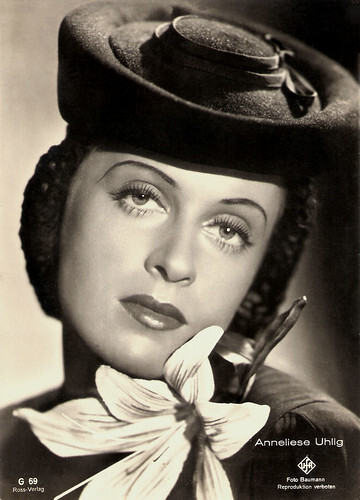
German postcard by Ross Verlag, no. G 69. Photo: Ufa / Baumann.
Anneliese Uhlig (1918-2017) was an elegant and enchanting femme fatale of Ufa crime films of the 1940s. The classic beauty unwillingly bewitched Joseph Goebbels. After the war, she worked internationally as a journalist, theatre producer and university teacher. She became an American citizen and died in Santa Cruz, California.
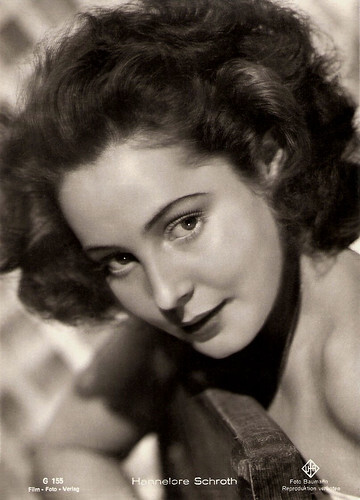
German postcard by Film-Foto-Verlag, no. G 155, 1941-1944. Photo: Baumann / Ufa.
German actress Hannelore Schroth (1922-1987) made her film debut at nine and had a long and successful career in theatre and cinema. She starred in Unter den Brücken/Under the Bridge (Helmut Käutner, 1945), one of the most beautiful love stories of German cinema – without any trace of propaganda.
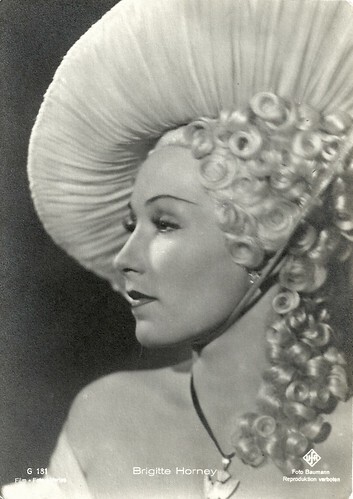
German postcard by Film-Foto-Verlag, no. G 181. Photo: Baumann / Ufa. Brigitte Horney in Münchhausen/The Adventures of Baron Munchausen (Josef von Báky, 1943).
Charismatic German theatre and film actress Brigitte Horney (1911-1988) worked in German and English films. Her earthy charm, prominent cheekbones and deep, sultry voice made her stand out from her colleagues. She is best remembered as Empress Katherine the Great in the lavish Ufa spectacle Münchhausen (1943). After the war, she moved to the US and became an American citizen.
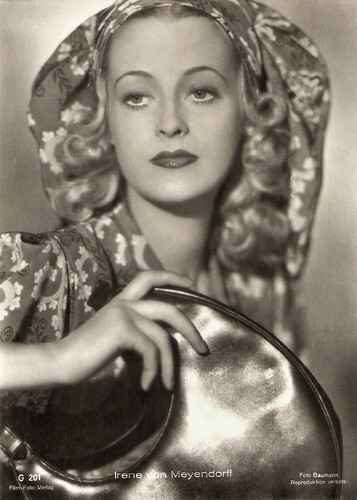
German postcard by Film-Foto-Verlag, no. G 201, 1941-1944. Photo: Foto Baumann.
Baroness Irene von Meyendorff (1916-2001) never planned to become a film star, but she appeared in more than 40 films. Unexpectedly, the breathtaking beautiful, ice-cold blonde became a star of the Ufa in the 1940s. Her beauty attracted Josef Goebbels, who got a harsh rebuff from her. After the war, she played several parts in interesting German films and led a full, remarkable life.
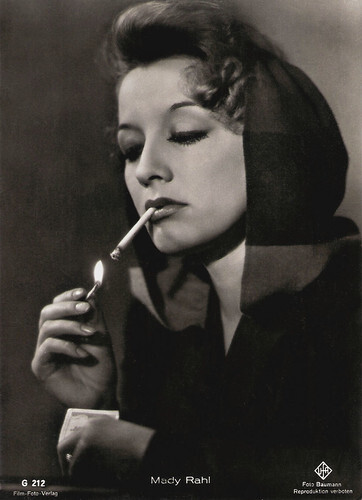
German postcard by Film-Foto-Verlag, no. G 212, 1941-1944. Photo: Baumann / Ufa.
German actress Mady Rahl (1915-2009) was the last of the female Ufa stars. She played in about 90 films, for the Ufa, and also in four decades after the war. On TV she was the German voice of Lucille Ball.
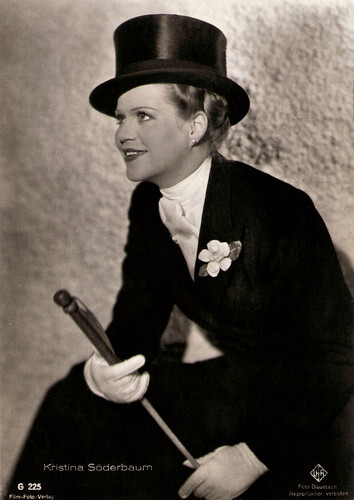
German postcard by Film-Foto-Verlag, no. G 225, 1941-1944. Photo: Baumann / Ufa. From Tatiana.
Swedish-born, German film actress Kristina Söderbaum (1912-2001) was considered the prototype of an Aryan woman during the Third Reich. The blonde, blue-eyed star played the lead in several Nazi propaganda films directed by her husband Veit Harlan. After the war, this would damage her career.
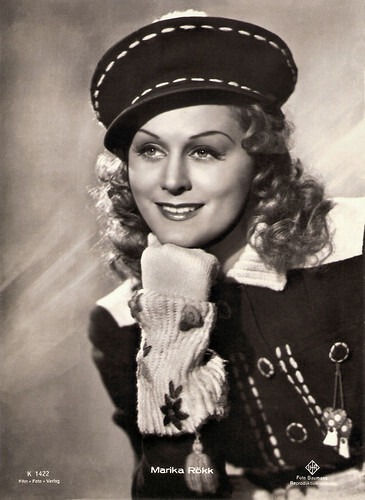
German postcard by Film-Foto-Verlag, no. K 1422. Photo: Baumann / Ufa.
Egyptian-born singer, dancer and actress of Hungarian descent Marika Rökk (1913-2004) was the last film diva of the Ufa. She was an immensely talented musical performer who could tap with the rhythm and vitality of her Hollywood counterpart Eleanor Powell, and switch to balletic movements with the conviction of Cyd Charisse. Her trade mark was her Hungarian accent.
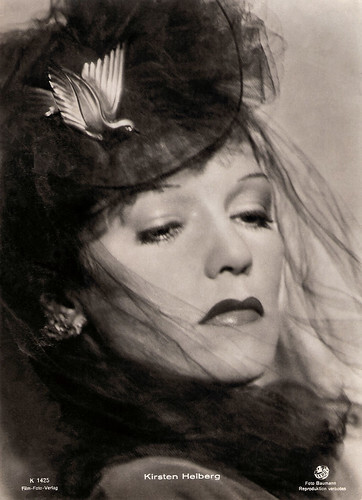
German postcard by Film-Foto-Verlag, no. K 1425. Photo: Baumann / Terra.
Beautiful Norwegian actress and singer Kirsten Heiberg (1907-1976) was the femme fatale of the German cinema of the Third Reich. The Ufa considered her a replacement for Marlene Dietrich after the latter left for Hollywood. ‘Die Heiberg’ was one of the most interesting and talented Ufa-stars, but unfortunately, she stayed somewhat in the shade of Zarah Leander.
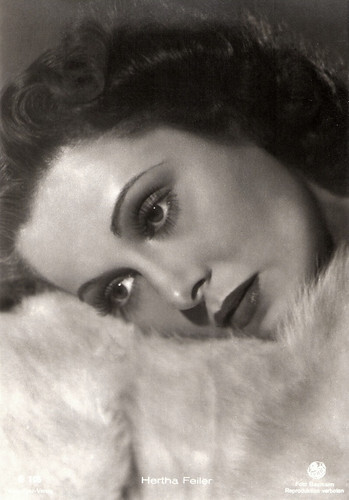
German postcard by Foto-Film-Verlag, no. S 185, 1941-1944. Photo: Baumann / Terra.
Beautiful Austrian actress Hertha Feiler (1916-1970) was the elegant and charming wife of Heinz Rühmann, off-screen and on-screen in many popular films of the 1940s and 1950s.
Who was Baumann?
Ernst Baumann was born in 1906 in Bad Reichenhall, Bavaria, Germany. After school, he attended the Fachschule für Korbflechterei (technical college for basket weaving) in Lichtenfels. In 1924, he was given a camera and from then on, he dedicated himself to photography. As early as 1926, he registered as a photographer. Baumann was a keen mountaineer and skier, and his photo series appeared in numerous alpine magazines. He published two books on mountain photography, 'Meine Berge, meine Kamera' (My Mountains, My Camera, 1935) and 'Fotografieren in den Bergen' (1936). From 1932 to 1939, he also worked as a still photographer for Luis Trenker 's mountain films, including the historical drama Der Rebell/The Rebel (Kurt Bernhardt, Edwin H. Knopf, Luis Trenker, 1932), the drama Der verlorene Sohn/The Prodigal Son (Luis Trenker, 1934) and the Italian historical drama Condottieri (Luis Trenker, 1937).
In addition to his work in the Alps, he was a portrait photographer for the Ufa and a photo reporter for the Berliner Illustrirte Zeitung. He did also industrial reports for the automotive industry and travel reports in the Mediterranean and on the Atlantic islands. His glamour portraits for the Ufa were used for many postcards by Ross Verlag and Film-Foto-Verlag. He also made publicity stills for such Ufa productions as the romantic comedy Frau am Steuer/Woman at the Wheel (Paul Martin, 1939) starring Lilian Harvey , the historical drama Es war eine rauschende Ballnacht/The Life and Loves of Tschaikovsky (Carl Froelich, 1939) starring Zarah Leander and Marika Rökk , and Liebesgeschichten (Viktor Tourjansky, 1941-1942) with Willy Fritsch and Hannelore Schroth .
During the Second World War, Baumann was a war correspondent and cameraman for the Waffen-SS. As his reputation grew, he was transferred to the Berghof to serve as Eva Braun's official photographer. Guido Knopp in his book 'Hitler's Women': "Eva enjoyed making home movies and taking photos, and particularly liked being photographed herself. The pictures taken by a photographer named Ernst Baumann were among her favourites. His son-in-law tells us: 'She wished to have more pictures taken of herself. The shots that my father-in-law took of her were a purely private commission.'
However, the photographer got dangerously close to Hitler's mistress. Some of his shots found their way into gift albums - but many did not. Those too have been discovered in Baumann's archive. They show Eva in the late summer of 1941, relaxing in the sun, doing gymnastics, or bathing in the Koenigssee. The collection includes photos of her sister Gretl. 'The photos were never intended for anyone else to see,' says his son-in-law. But somehow they were seen by Martin Bormann, Hitler's secretary and chief factotum on the Obersalzberg. 'Towards the end of '41 [note: this was actually the fall of 1942], my father-in-law was suddenly posted to the front, without a word of warning. After the war, he found out from a former superior officer [note: Fritz Darges, former aide-de-camp at the Obersalzberg] that he should have actually been sent on a mission from which he was not meant to come back alive.' But the photographer survived - and so did his pictures."
After the war, Ernst Baumann returned to Bad Reichenhall from American captivity in 1947. There he rebuilt his photography business with an attached postcard publishing house. He kept making film star portraits. Baumann passed away in 1985 in Bad Reichenhall in Bavaria. He was 78. On 14 May 2006, a permanent exhibition of his work from his early creative period from 1925 to 1950 was opened in the mountain hotel on the Predigtstuhl near Bad Reichenhall to mark Ernst Baumann's 100th birthday.
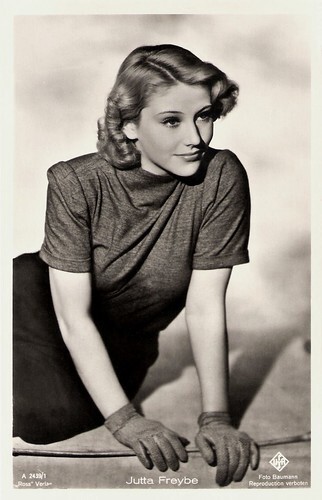
German postcard by Ross Verlag, no. A 2439/1, 1939-1940. Photo: Baumann / Ufa.
German stage and film actress Jutta Freybe (1917–1971) was the attractive blond leading lady in ten films during the Nazi era.
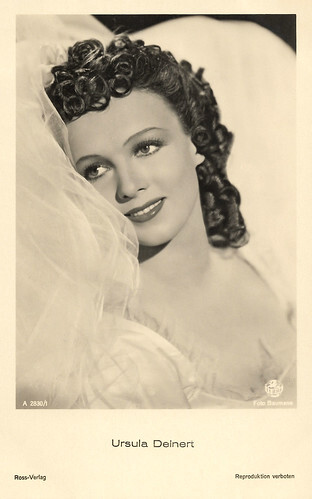
German postcard by Ross Verlag, no. A 2830/1, 1939-1940. Photo: Baumann / Terra.
Dancer, singer, and actress Ursula Deinert (1910-1988) was one of the dancing queens of the German light entertainment films of the late 1930s and the early 1940s.
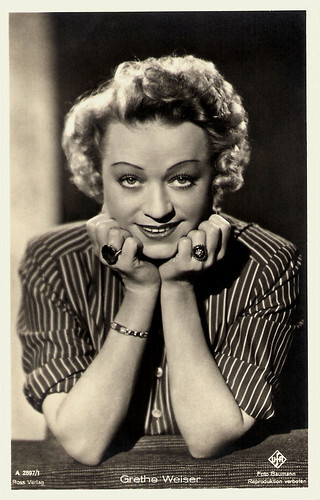
German postcard by Ross Verlag, no. A 2897/1, 1939-1940. Photo: Ufa / Baumann.
Grethe Weiser (1903–1970) was a German singer, comedian, film and stage actress. She made more than 140 films.
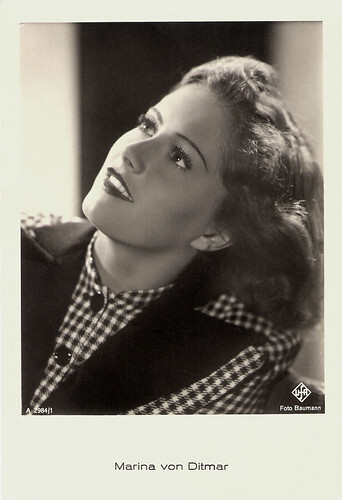
German postcard by Film-Foto-Verlag, no. A 2984/1, 1939-1940. Photo: Baumann / Ufa.
German Baltic theatre and film actress Marina von Ditmar (1914) was a popular film star of the Third Reich.
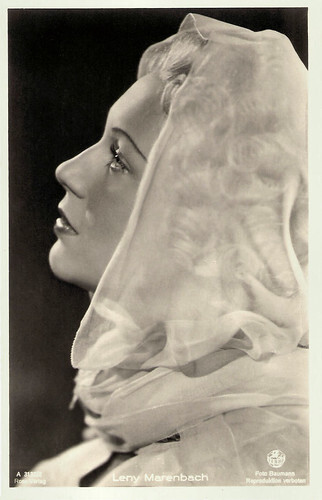
German postcard by Film-Foto-Verlag, no. A 3132/2, 1941-1944. Photo: Baumann / Terra.
Lady-like Leny Marenbach (1907–1984) was one of the leading Ufa stars in the Nazi era. The German actress appeared in several popular comedies with Heinz Rühmann, like the hit Der Mustergatte/The Model Husband (1937). After the Second World War, she only played in a few films for the Defa.
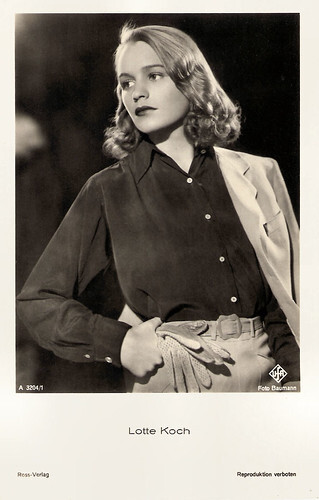
German postcard by Ross-Verlag, no. A 3204/1, 1941-1944. Photo: Baumann / Ufa.
German-Belgian actress Lotte Koch (1913-2013) appeared in Nazi propaganda films, but she also starred in Morituri (1948), the first German film about concentration camps and the Holocaust.
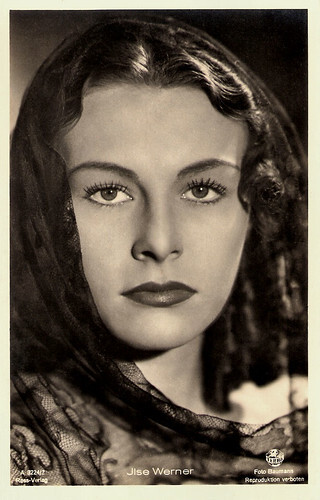
German postcard by Ross-Verlag, no. A 3224/2, 1941-1944. Photo: Baumann / Terra.
Dutch-born actress and singer Ilse Werner (1921-2005) was one of the most popular stars of the German screen during the Nazi years. After the war, she became a successful Schlager singer. Her nickname, 'Ein Frau mit Pfiff', translates as 'A Woman of Distinction', but also refers to her trademark, whistling.
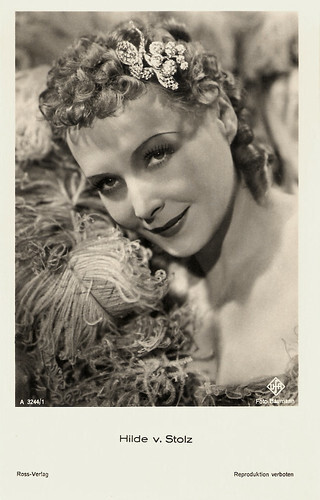
German postcard by Ross Verlag, no. A 3244/1, 1941-1944. Photo: Baumann / Ufa.
Hilde von Stolz (1903-1973) was a blonde Austrian leading lady and supporting actress in Ufa films of the 1930s and 1940s.
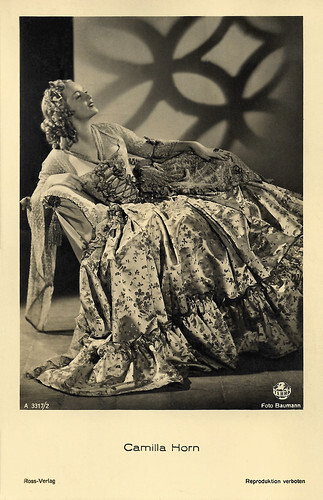
German postcard by Ross Verlag, no. A 3317/2, 1941-1944. Photo: Baumann / Terra. Camilla Horn in Friedemann Bach (Traugott Müller, Gustaf Gründgens, 1941).
Ethereally blonde Camilla Horn (1903-1996) was a German dancer and film star. Her breakthrough role was Gretchen in the silent film classic Faust (Friedrich Wilhelm Murnau, 1926). She also starred in some Hollywood films of the late 1920s and a few British and Italian productions.
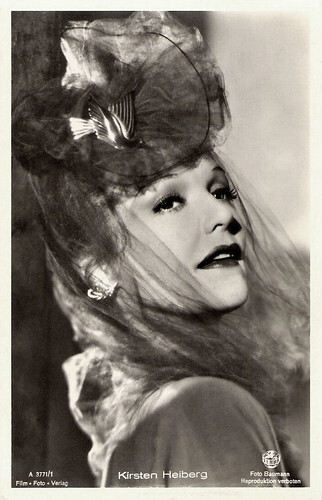
German Postcard by Film-Foto-Verlag, no. A 3371/1, 1941-1944. Photo: Baumann / Terra. Kirsten Heiberg in Liebespremiere/Love premiere (Arthur Maria Rabenalt, 1943).
Beautiful Norwegian actress and singer Kirsten Heiberg (1907-1976) was the femme fatale of the German cinema of the Third Reich. The Ufa considered her a replacement for Marlene Dietrich after the latter left for Hollywood. ‘Die Heiberg’ was one of the most interesting and talented Ufa-stars, but unfortunately, she stayed somewhat in the shade of Zarah Leander.
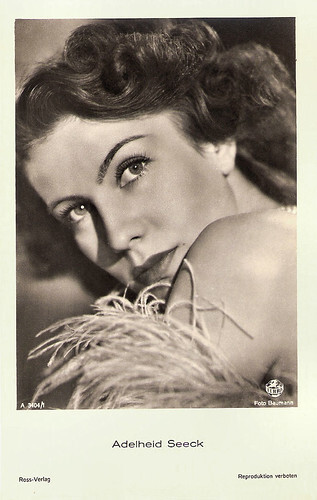
German postcard by Ross-Verlag, no. 3404/1, 1941-1944. Photo: Baumann / Terra.
Dark-haired and elegant German film actress Adelheid Seeck (1912-1973) appeared in 27 films between 1941 and 1972. Her West German films of the 1950s had class and were often selected for the Berlin International Film Festival.
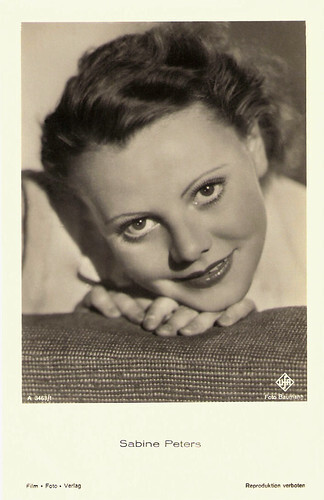
German postcard by Film-Foto-Verlag, no. A 3463/1, 1941-1944. Photo: Baumann / Ufa.
Sabine Peters (1913-1982) was a fresh-faced German theatre and film actress. During the 1930s, she played supporting and occasional leading roles in several mainstream romances and comedies for the Ufa. For Carl Froelich, she played a young student in two films but had her breakthrough as the selfish and jealous daughter of Lil Dagover in Das Mädchen Irene/The Girl Irene (1936).
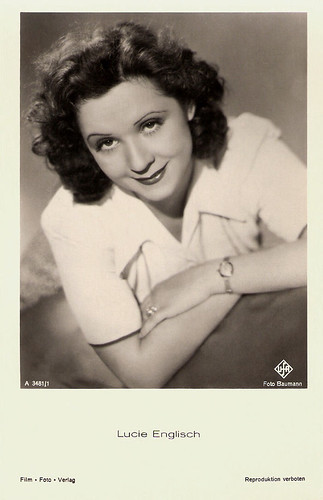
German postcard by Film-Foto-Verlag, no. A 3481/1, 1939-1940. Photo: Baumann / Ufa.
Popular Austrian folk actress Lucie Englisch (1902-1965) played leading and supporting roles on stage, in films, and on television. As the native girl with a loose tongue, she was seen in countless comedies, in both leading and supporting parts.
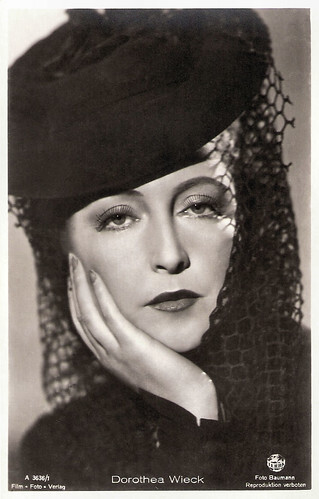
German postcard by Film-Foto-Verlag, Berlin, no. A 3628/1, 1941-1944. Photo: Baumann / Terra.
Swiss actress Dorothea Wieck (1908-1986) became a major star and a lesbian idol with her role as the adored teacher Fräulein von Bernburg in the German classic Mädchen in Uniform (Leontine Sagan, 1931). She made more than fifty films, but she was also a prominent stage actress of the Deutsche Theater, the Schiller Theater and other main theatres in Berlin.
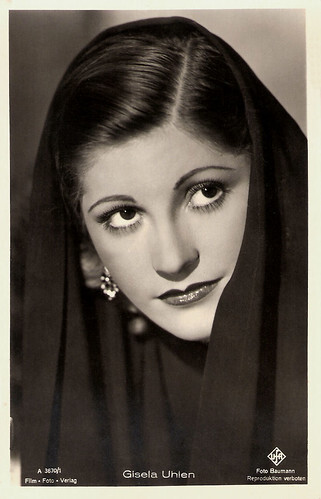
German postcard by Film-Foto-Verlag, no. A 3670/1, 1941-1944. Photo: Baumann / Ufa.
Charming German film actress Gisela Uhlen (1919-2007) appeared in over 60 films, 80 TV productions and more than 100 stage plays. She was a Ufa diva during the Third Reich, moved to East Germany during the Cold War, and finally became one of the grande dames of the German stage and television.
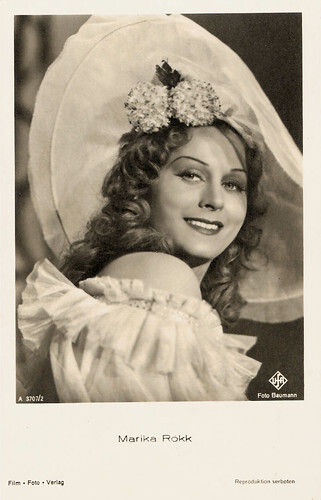
German postcard by Film-Foto-Verlag, no. A 3707/2, 1941-1944. Photo: Baumann / Ufa.
Egyptian-born singer, dancer and actress of Hungarian descent Marika Rökk (1913-2004) was the last film diva of the Ufa. She was an immensely talented musical performer who could tap with the rhythm and vitality of her Hollywood counterpart Eleanor Powell, and switch to balletic movements with the conviction of Cyd Charisse. Her trade mark was her Hungarian accent.
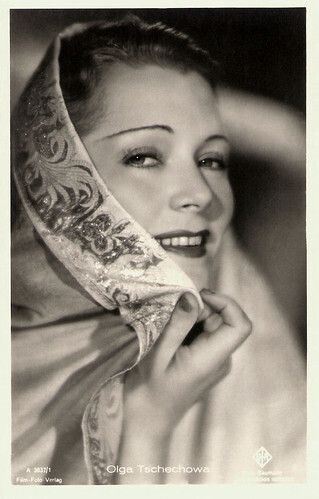
German postcard by Film-Foto-Verlag, no. A 3837/1, 1941-1944. Photo: Baumann / Ufa.
Dignified German-Russian actress Olga Tschechowa (1897-1980) was one of the most popular stars of the silent film era. She remained a mysterious person throughout her life and was reportedly a Russian agent in Nazi Germany.
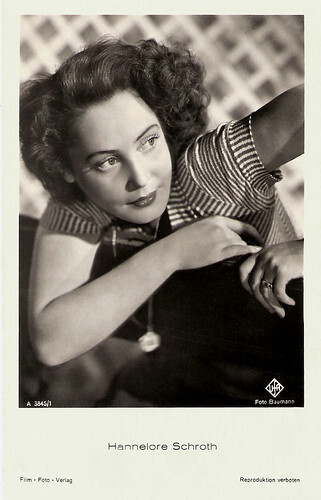
German postcard by Film-Foto-Verlag, no. A 3845/1, 1941-1944. Photo: Baumann / Ufa.
German actress Hannelore Schroth (1922-1987) made her film debut at nine and had a long and successful career in theatre and cinema. She starred in Unter den Brücken/Under the Bridge (Helmut Käutner, 1945), one of the most beautiful love stories of German cinema – without any trace of propaganda.
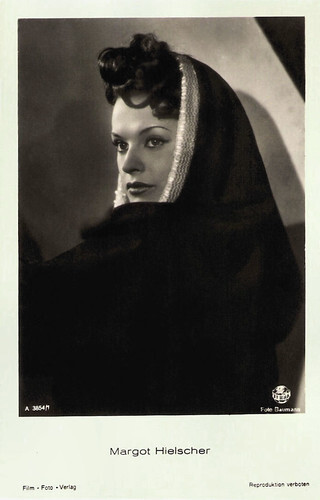
German postcard by Film-Foto-Verlag, no. A 3854/1, 1941-1944. Photo: Baumann / Terra.
German singer, film actress and costume designer Margot Hielscher (1919-2017) appeared in 60 films and 200 TV productions. She represented Germany twice at the Eurovision Song Contest, in 1957 and 1958.
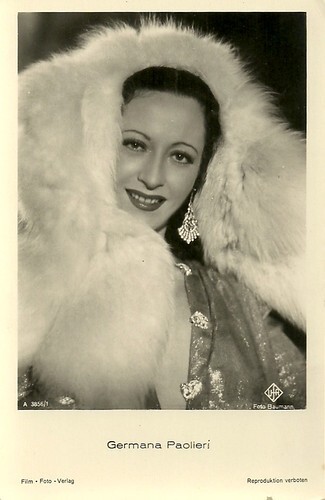
German postcard by Film-Foto-Verlag, no. A. 3856/1. Photo: Baumann / Ufa.
Germana Paolieri (1906-1998) was an Italian stage and screen actress. After the war, she also worked for radio and television. As an actress, she flourished between the early 1930s and 1981, while as a film actress, she peaked in the 1930s and early 1940s, but also the mid-1950s.
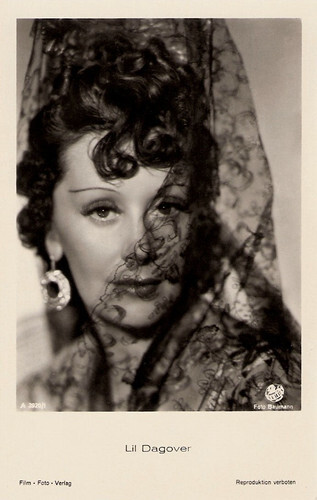
German postcard by Film-Foto-Verlag, no. A 3920/1, 1941-1944. Photo: Baumann / Terra. Lil Dagover in Musik in Salzburg/Music in Salzburg (Herbert Maisch, 1944).
German, but Dutch-born film actress Lil Dagover (1887-1980) was an exotic, dark beauty, who featured prominently during the golden age of the German silent cinema. She had her breakthrough as the prey of Dr. Caligari's monster in the classic expressionist film Das Cabinet des Dr. Caligari (1920) but gradually her fine and evanescent beauty changed and she turned into a 'Salondame', a lady of the screen. Her career would span nearly six decades.
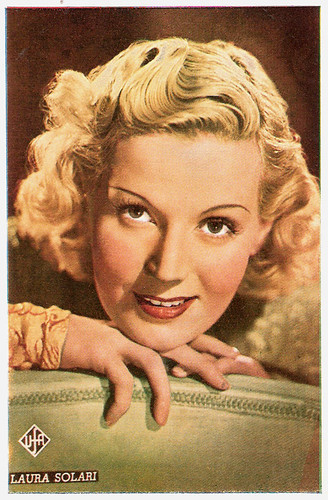
Croatian postcard by Dopisnica. Photo: Baumann / Ufa.
Laura Solari (1913–1984) was an Italian film actress. She appeared in 30 films between 1936 and 1969.
Sources: Ernst Baumann Foto Archiv 1942-1944 (Facebook), Wikipedia (German) and .

German postcard by Ross Verlag, no. G 69. Photo: Ufa / Baumann.
Anneliese Uhlig (1918-2017) was an elegant and enchanting femme fatale of Ufa crime films of the 1940s. The classic beauty unwillingly bewitched Joseph Goebbels. After the war, she worked internationally as a journalist, theatre producer and university teacher. She became an American citizen and died in Santa Cruz, California.

German postcard by Film-Foto-Verlag, no. G 155, 1941-1944. Photo: Baumann / Ufa.
German actress Hannelore Schroth (1922-1987) made her film debut at nine and had a long and successful career in theatre and cinema. She starred in Unter den Brücken/Under the Bridge (Helmut Käutner, 1945), one of the most beautiful love stories of German cinema – without any trace of propaganda.

German postcard by Film-Foto-Verlag, no. G 181. Photo: Baumann / Ufa. Brigitte Horney in Münchhausen/The Adventures of Baron Munchausen (Josef von Báky, 1943).
Charismatic German theatre and film actress Brigitte Horney (1911-1988) worked in German and English films. Her earthy charm, prominent cheekbones and deep, sultry voice made her stand out from her colleagues. She is best remembered as Empress Katherine the Great in the lavish Ufa spectacle Münchhausen (1943). After the war, she moved to the US and became an American citizen.

German postcard by Film-Foto-Verlag, no. G 201, 1941-1944. Photo: Foto Baumann.
Baroness Irene von Meyendorff (1916-2001) never planned to become a film star, but she appeared in more than 40 films. Unexpectedly, the breathtaking beautiful, ice-cold blonde became a star of the Ufa in the 1940s. Her beauty attracted Josef Goebbels, who got a harsh rebuff from her. After the war, she played several parts in interesting German films and led a full, remarkable life.

German postcard by Film-Foto-Verlag, no. G 212, 1941-1944. Photo: Baumann / Ufa.
German actress Mady Rahl (1915-2009) was the last of the female Ufa stars. She played in about 90 films, for the Ufa, and also in four decades after the war. On TV she was the German voice of Lucille Ball.

German postcard by Film-Foto-Verlag, no. G 225, 1941-1944. Photo: Baumann / Ufa. From Tatiana.
Swedish-born, German film actress Kristina Söderbaum (1912-2001) was considered the prototype of an Aryan woman during the Third Reich. The blonde, blue-eyed star played the lead in several Nazi propaganda films directed by her husband Veit Harlan. After the war, this would damage her career.

German postcard by Film-Foto-Verlag, no. K 1422. Photo: Baumann / Ufa.
Egyptian-born singer, dancer and actress of Hungarian descent Marika Rökk (1913-2004) was the last film diva of the Ufa. She was an immensely talented musical performer who could tap with the rhythm and vitality of her Hollywood counterpart Eleanor Powell, and switch to balletic movements with the conviction of Cyd Charisse. Her trade mark was her Hungarian accent.

German postcard by Film-Foto-Verlag, no. K 1425. Photo: Baumann / Terra.
Beautiful Norwegian actress and singer Kirsten Heiberg (1907-1976) was the femme fatale of the German cinema of the Third Reich. The Ufa considered her a replacement for Marlene Dietrich after the latter left for Hollywood. ‘Die Heiberg’ was one of the most interesting and talented Ufa-stars, but unfortunately, she stayed somewhat in the shade of Zarah Leander.

German postcard by Foto-Film-Verlag, no. S 185, 1941-1944. Photo: Baumann / Terra.
Beautiful Austrian actress Hertha Feiler (1916-1970) was the elegant and charming wife of Heinz Rühmann, off-screen and on-screen in many popular films of the 1940s and 1950s.
Who was Baumann?
Ernst Baumann was born in 1906 in Bad Reichenhall, Bavaria, Germany. After school, he attended the Fachschule für Korbflechterei (technical college for basket weaving) in Lichtenfels. In 1924, he was given a camera and from then on, he dedicated himself to photography. As early as 1926, he registered as a photographer. Baumann was a keen mountaineer and skier, and his photo series appeared in numerous alpine magazines. He published two books on mountain photography, 'Meine Berge, meine Kamera' (My Mountains, My Camera, 1935) and 'Fotografieren in den Bergen' (1936). From 1932 to 1939, he also worked as a still photographer for Luis Trenker 's mountain films, including the historical drama Der Rebell/The Rebel (Kurt Bernhardt, Edwin H. Knopf, Luis Trenker, 1932), the drama Der verlorene Sohn/The Prodigal Son (Luis Trenker, 1934) and the Italian historical drama Condottieri (Luis Trenker, 1937).
In addition to his work in the Alps, he was a portrait photographer for the Ufa and a photo reporter for the Berliner Illustrirte Zeitung. He did also industrial reports for the automotive industry and travel reports in the Mediterranean and on the Atlantic islands. His glamour portraits for the Ufa were used for many postcards by Ross Verlag and Film-Foto-Verlag. He also made publicity stills for such Ufa productions as the romantic comedy Frau am Steuer/Woman at the Wheel (Paul Martin, 1939) starring Lilian Harvey , the historical drama Es war eine rauschende Ballnacht/The Life and Loves of Tschaikovsky (Carl Froelich, 1939) starring Zarah Leander and Marika Rökk , and Liebesgeschichten (Viktor Tourjansky, 1941-1942) with Willy Fritsch and Hannelore Schroth .
During the Second World War, Baumann was a war correspondent and cameraman for the Waffen-SS. As his reputation grew, he was transferred to the Berghof to serve as Eva Braun's official photographer. Guido Knopp in his book 'Hitler's Women': "Eva enjoyed making home movies and taking photos, and particularly liked being photographed herself. The pictures taken by a photographer named Ernst Baumann were among her favourites. His son-in-law tells us: 'She wished to have more pictures taken of herself. The shots that my father-in-law took of her were a purely private commission.'
However, the photographer got dangerously close to Hitler's mistress. Some of his shots found their way into gift albums - but many did not. Those too have been discovered in Baumann's archive. They show Eva in the late summer of 1941, relaxing in the sun, doing gymnastics, or bathing in the Koenigssee. The collection includes photos of her sister Gretl. 'The photos were never intended for anyone else to see,' says his son-in-law. But somehow they were seen by Martin Bormann, Hitler's secretary and chief factotum on the Obersalzberg. 'Towards the end of '41 [note: this was actually the fall of 1942], my father-in-law was suddenly posted to the front, without a word of warning. After the war, he found out from a former superior officer [note: Fritz Darges, former aide-de-camp at the Obersalzberg] that he should have actually been sent on a mission from which he was not meant to come back alive.' But the photographer survived - and so did his pictures."
After the war, Ernst Baumann returned to Bad Reichenhall from American captivity in 1947. There he rebuilt his photography business with an attached postcard publishing house. He kept making film star portraits. Baumann passed away in 1985 in Bad Reichenhall in Bavaria. He was 78. On 14 May 2006, a permanent exhibition of his work from his early creative period from 1925 to 1950 was opened in the mountain hotel on the Predigtstuhl near Bad Reichenhall to mark Ernst Baumann's 100th birthday.

German postcard by Ross Verlag, no. A 2439/1, 1939-1940. Photo: Baumann / Ufa.
German stage and film actress Jutta Freybe (1917–1971) was the attractive blond leading lady in ten films during the Nazi era.

German postcard by Ross Verlag, no. A 2830/1, 1939-1940. Photo: Baumann / Terra.
Dancer, singer, and actress Ursula Deinert (1910-1988) was one of the dancing queens of the German light entertainment films of the late 1930s and the early 1940s.

German postcard by Ross Verlag, no. A 2897/1, 1939-1940. Photo: Ufa / Baumann.
Grethe Weiser (1903–1970) was a German singer, comedian, film and stage actress. She made more than 140 films.

German postcard by Film-Foto-Verlag, no. A 2984/1, 1939-1940. Photo: Baumann / Ufa.
German Baltic theatre and film actress Marina von Ditmar (1914) was a popular film star of the Third Reich.

German postcard by Film-Foto-Verlag, no. A 3132/2, 1941-1944. Photo: Baumann / Terra.
Lady-like Leny Marenbach (1907–1984) was one of the leading Ufa stars in the Nazi era. The German actress appeared in several popular comedies with Heinz Rühmann, like the hit Der Mustergatte/The Model Husband (1937). After the Second World War, she only played in a few films for the Defa.

German postcard by Ross-Verlag, no. A 3204/1, 1941-1944. Photo: Baumann / Ufa.
German-Belgian actress Lotte Koch (1913-2013) appeared in Nazi propaganda films, but she also starred in Morituri (1948), the first German film about concentration camps and the Holocaust.

German postcard by Ross-Verlag, no. A 3224/2, 1941-1944. Photo: Baumann / Terra.
Dutch-born actress and singer Ilse Werner (1921-2005) was one of the most popular stars of the German screen during the Nazi years. After the war, she became a successful Schlager singer. Her nickname, 'Ein Frau mit Pfiff', translates as 'A Woman of Distinction', but also refers to her trademark, whistling.

German postcard by Ross Verlag, no. A 3244/1, 1941-1944. Photo: Baumann / Ufa.
Hilde von Stolz (1903-1973) was a blonde Austrian leading lady and supporting actress in Ufa films of the 1930s and 1940s.

German postcard by Ross Verlag, no. A 3317/2, 1941-1944. Photo: Baumann / Terra. Camilla Horn in Friedemann Bach (Traugott Müller, Gustaf Gründgens, 1941).
Ethereally blonde Camilla Horn (1903-1996) was a German dancer and film star. Her breakthrough role was Gretchen in the silent film classic Faust (Friedrich Wilhelm Murnau, 1926). She also starred in some Hollywood films of the late 1920s and a few British and Italian productions.

German Postcard by Film-Foto-Verlag, no. A 3371/1, 1941-1944. Photo: Baumann / Terra. Kirsten Heiberg in Liebespremiere/Love premiere (Arthur Maria Rabenalt, 1943).
Beautiful Norwegian actress and singer Kirsten Heiberg (1907-1976) was the femme fatale of the German cinema of the Third Reich. The Ufa considered her a replacement for Marlene Dietrich after the latter left for Hollywood. ‘Die Heiberg’ was one of the most interesting and talented Ufa-stars, but unfortunately, she stayed somewhat in the shade of Zarah Leander.

German postcard by Ross-Verlag, no. 3404/1, 1941-1944. Photo: Baumann / Terra.
Dark-haired and elegant German film actress Adelheid Seeck (1912-1973) appeared in 27 films between 1941 and 1972. Her West German films of the 1950s had class and were often selected for the Berlin International Film Festival.

German postcard by Film-Foto-Verlag, no. A 3463/1, 1941-1944. Photo: Baumann / Ufa.
Sabine Peters (1913-1982) was a fresh-faced German theatre and film actress. During the 1930s, she played supporting and occasional leading roles in several mainstream romances and comedies for the Ufa. For Carl Froelich, she played a young student in two films but had her breakthrough as the selfish and jealous daughter of Lil Dagover in Das Mädchen Irene/The Girl Irene (1936).

German postcard by Film-Foto-Verlag, no. A 3481/1, 1939-1940. Photo: Baumann / Ufa.
Popular Austrian folk actress Lucie Englisch (1902-1965) played leading and supporting roles on stage, in films, and on television. As the native girl with a loose tongue, she was seen in countless comedies, in both leading and supporting parts.

German postcard by Film-Foto-Verlag, Berlin, no. A 3628/1, 1941-1944. Photo: Baumann / Terra.
Swiss actress Dorothea Wieck (1908-1986) became a major star and a lesbian idol with her role as the adored teacher Fräulein von Bernburg in the German classic Mädchen in Uniform (Leontine Sagan, 1931). She made more than fifty films, but she was also a prominent stage actress of the Deutsche Theater, the Schiller Theater and other main theatres in Berlin.

German postcard by Film-Foto-Verlag, no. A 3670/1, 1941-1944. Photo: Baumann / Ufa.
Charming German film actress Gisela Uhlen (1919-2007) appeared in over 60 films, 80 TV productions and more than 100 stage plays. She was a Ufa diva during the Third Reich, moved to East Germany during the Cold War, and finally became one of the grande dames of the German stage and television.

German postcard by Film-Foto-Verlag, no. A 3707/2, 1941-1944. Photo: Baumann / Ufa.
Egyptian-born singer, dancer and actress of Hungarian descent Marika Rökk (1913-2004) was the last film diva of the Ufa. She was an immensely talented musical performer who could tap with the rhythm and vitality of her Hollywood counterpart Eleanor Powell, and switch to balletic movements with the conviction of Cyd Charisse. Her trade mark was her Hungarian accent.

German postcard by Film-Foto-Verlag, no. A 3837/1, 1941-1944. Photo: Baumann / Ufa.
Dignified German-Russian actress Olga Tschechowa (1897-1980) was one of the most popular stars of the silent film era. She remained a mysterious person throughout her life and was reportedly a Russian agent in Nazi Germany.

German postcard by Film-Foto-Verlag, no. A 3845/1, 1941-1944. Photo: Baumann / Ufa.
German actress Hannelore Schroth (1922-1987) made her film debut at nine and had a long and successful career in theatre and cinema. She starred in Unter den Brücken/Under the Bridge (Helmut Käutner, 1945), one of the most beautiful love stories of German cinema – without any trace of propaganda.

German postcard by Film-Foto-Verlag, no. A 3854/1, 1941-1944. Photo: Baumann / Terra.
German singer, film actress and costume designer Margot Hielscher (1919-2017) appeared in 60 films and 200 TV productions. She represented Germany twice at the Eurovision Song Contest, in 1957 and 1958.

German postcard by Film-Foto-Verlag, no. A. 3856/1. Photo: Baumann / Ufa.
Germana Paolieri (1906-1998) was an Italian stage and screen actress. After the war, she also worked for radio and television. As an actress, she flourished between the early 1930s and 1981, while as a film actress, she peaked in the 1930s and early 1940s, but also the mid-1950s.

German postcard by Film-Foto-Verlag, no. A 3920/1, 1941-1944. Photo: Baumann / Terra. Lil Dagover in Musik in Salzburg/Music in Salzburg (Herbert Maisch, 1944).
German, but Dutch-born film actress Lil Dagover (1887-1980) was an exotic, dark beauty, who featured prominently during the golden age of the German silent cinema. She had her breakthrough as the prey of Dr. Caligari's monster in the classic expressionist film Das Cabinet des Dr. Caligari (1920) but gradually her fine and evanescent beauty changed and she turned into a 'Salondame', a lady of the screen. Her career would span nearly six decades.

Croatian postcard by Dopisnica. Photo: Baumann / Ufa.
Laura Solari (1913–1984) was an Italian film actress. She appeared in 30 films between 1936 and 1969.
Sources: Ernst Baumann Foto Archiv 1942-1944 (Facebook), Wikipedia (German) and .
Published on January 13, 2024 22:00
January 12, 2024
Wilhelm Diegelmann
Rotund Wilhelm Diegelmann (1861-1934) was a prolific German stage and screen actor, who played hundreds, mostly supporting, of parts in German silent cinema. Diegelmann began in classical roles on stage in 1881 and turned to films in 1913, mentored by Max Reinhardt. He specialised in amiably paternal roles or as kindly burgomasters, elderly physicians or farmers.
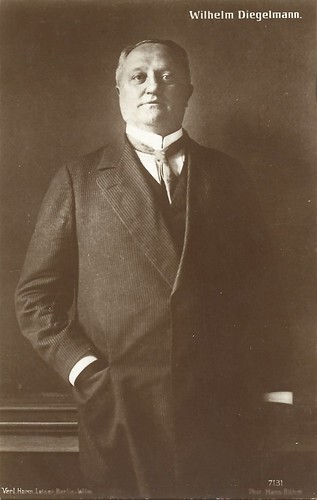
German postcard by Verlag Hermann Leiser, Berlin-Wilm., no. 7131. Photo: Hans Böhm.
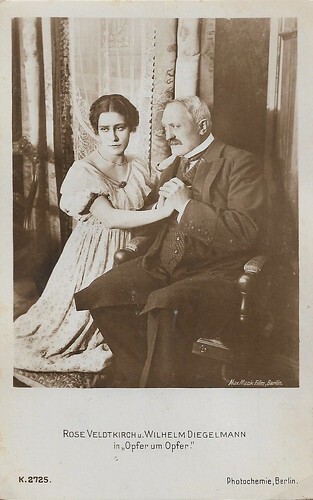
German postcard by Photochemie, no. K.2725. Photo: Max Mack-Film. Rosa Veldtkirch and Wilhelm Diegelmann in Opfer um Opfer (Max Mack, 1918), starring Karl Beckersachs. The film is lost.
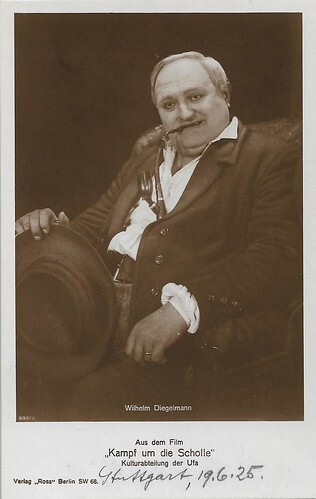
German postcard by Ross Verlag, no. 989/3. This postcard is dated: Stuttgart, 19 June 1925. Photo: Ufa. Wilhelm Diegelman as Uncle Uhl in Kampf um die Scholle/Struggle for the Soil (Erich Waschneck, 1925).
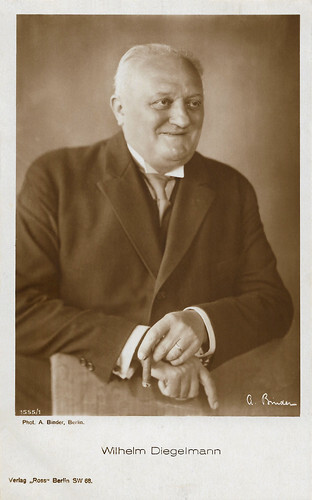
German postcard by Ross Verlag, Berlin-Wilm., no. 1555/1, 1927-1928. Photo: A. Binder, Berlin.
Father figure, bishop or innkeeper
Wilhelm Diegelmann was born in 1861 in Ellers, Neuhof, Electorate of Hesse, now Neuhof, Hesse, Germany.
Diegelmann's first stage appearance was in 1878 in the chorus for the Frankfurt Opera. In 1881 he debuted at the Frankfurt City Theater, playing Wallenstein, Nathan the Wise, King Lear, William Tell, and other title characters.
In 1907, Diegelmann relocated to Berlin. Here, he appeared at the Deutsches Theater, but later also at the Berliner Theater, the Großes Schauspielhaus, and the Deutsches Künstlertheater. After decades of stage acting, he appeared in Max Reinhardt 's film Die Insel der Seligen/The Islands of Bliss (1913) starring Ernst Hoffmann and Ernst Matráy .
Diegelmann started a parallel, second career as a silent film actor in 1913. In the following years, the likeable actor played in countless films, often in artistic demanding and successful works like Ernst Lubitsch's comedy Prinz Sami (1917) and the cinematic highlights Carmen (Ernst Lubitsch, 1918) and the groundbreaking gay-themed film Anders als die Anderen/Different from the Others (Richard Oswald, 1919).
In German silent cinema, he became a prolific actor in supporting roles, often as a father figure, guard, bishop or innkeeper, both in dramas and comedies. Between 1913 and his death in 1934 he played in 247 films, including also some ten German early sound films. At Cyranos , Thomas Staedeli writes: "The actor Wilhelm Diegelmann belongs to the primary rock of the German silent movie."
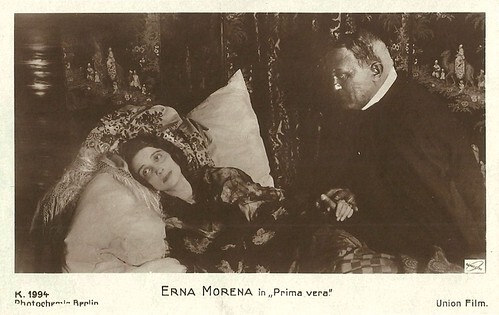
German postcard by Photochemie, Berlin, no. K. 1994. Photo: Union Film. Erna Morena and Wilhelm Diegelmann in Prima Vera (Paul Leni, 1917), based on Alexandre Dumas fils's novel and play 'La dame aux camélias'.
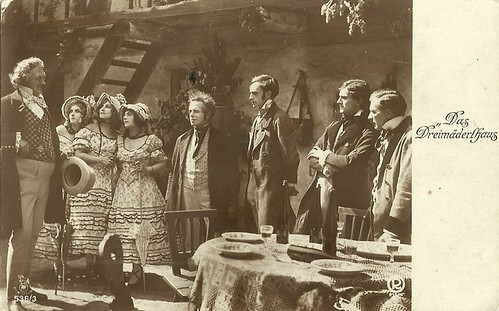
German postcard in the Film Sterne series by Rotophot, no. 563/3. Photo: Richard-Oswald-Film. Postcard for the German silent film Das Dreimäderlhaus/The House of Three Girls (Richard Oswald, 1918), considered a lost film. It tells about the life of composer Franz Schubert (Julius Spielmann, the man with spectacles in the middle here). Right of Spielmann stands Conrad Veidt , who plays Baron Schober, while the tall, sturdy man on the left may be Wilhelm Diegelmann (Tschöll). The three daughters are played by Sybile Binder, Käthe Oswald, and Ruth Werner.
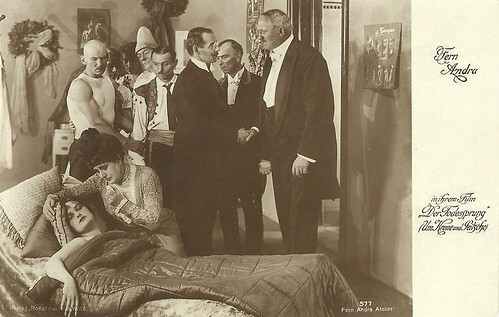
German postcard by Ross Verlag, no. 577. Photo: Fern-Andra-Atelier. Fern Andra , probably Olga Engl and Wilhelm Diegelmann in Der Todessprung/Um Krone und Peitsche/Crown and Whip (Georg Bluen, Fern Andra, 1919).
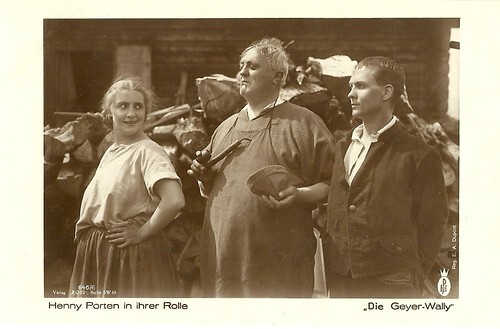
German postcard by Ross Verlag, no. 646/6. Photo: HPF [Henny Porten Film]. Henny Porten in Die Geyer-Wally/Die Geier-Wally (E.A. Dupont, 1921). Although drama and romance dominate, the film has some witty scenes, such as the one in which Wally rejects the marriage proposal by farmer Rosenbauer senior (Wilhelm Diegelmann) and his son (Gerd Fricke).
Lubitsch, Lang, Murnau and Von Sternberg
Wilhelm Diegelmann became the epitome of Weimar cinema. He played in famous titles such as the comedy Robert und Bertram, die lustigen Vagabunden/Robert and Bertram (Max Mack, 1915), the historical film Veritas Vincit (Joe May, 1919), the adventure fantasy Das indische Grabmal/The Indian Tomb (Joe May, 1921), Der müde Tod/Destiny (Fritz Lang, 1921), the farcical comedy Die Bergkatze/The Wild Cat (Ernst Lubitsch, 1921) starring Pola Negri , Phantom (F.W. Murnau, 1922) with Alfred Abel and Kampf um die Scholle (Erich Waschneck, 1925) as well as in lesser-known films.
He worked with reputed directors such as Max Mack , Paul Wegener , Joe May , Ernst Lubitsch , Paul Leni, E.A. Dupont, Fritz Lang and F.W. Murnau and acted opposite all the famous actresses of the German silent cinema: Mia May , Erna Morena , Pola Negri , Fern Andra , Asta Nielsen , etc.
In particular, he often costarred with Henny Porten in films like Die Wellen schweigen/The waves are silent (Rudolf Biebrach, 1915), Feeënhande/Fairy hands (Rudolf Biebrach, 1917), Monika Vogelsang (Rudolf Biebrach, 1920), Anna Boleyn (Ernst Lubitsch, 1920), Die Geierwally/The Vulture Wally (Ewald André Dupont, 1921), Mutter und Kind/Mother and Child (Carl Froelich, 1924), and Violantha (Carl Froelich, 1927). He was paired with comedians such as Anna Müller-Lincke , Senta Söneland , Ernst Lubitsch , Mady Christians , Lya Mara , and Reinhold Schünzel , but also with crime fighters like Carl Auen , Ernst Reicher and Max Landa .
In the sound era, he performed in the classic Der Blaue Engel/The Blue Angel (Josef von Sternberg, 1930), where he played a ship captain who flirts with the singer Lola Lola ( Marlene Dietrich ) and promptly feels the jealousy of her new husband ( Emil Jannings ). He also appeared in Harry Piel's Der Geheimagent/Secret Agent (Harry Piel, 1932) and the Nazi propagandafilm Hans Westmar (Franz Wenzler, 1932).
His final film was the Theodor Storm adaptation Der Schimmelreiter/The Rider on the White Horse (Hans Deppe, Curt Oertel, 1934) starring Mathias Wieman . After this, Diegelmann continued to make stage appearances, with his last role being in 'Rembrandt vor Gericht' (Rembrandt in Court) by Hans Kyser. He died not long after this in 1934 in Berlin, at 72. He was interred at the Südwestkirchhof Stahnsdorf near Berlin, though the grave no longer exists.
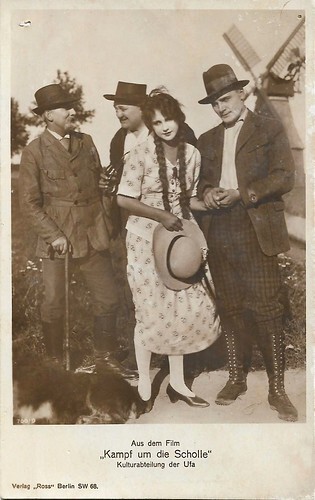
German postcard by Ross Verlag, no. 700/9. Photo: Ufa. Publicity still for Kampf um die Scholle/Struggle for the Soil (Erich Waschneck, 1925) with Oskar Marion as Franz, the younger brother of estate owner Axel, who has an affair with Luise ( Mary Parker ), daughter of the estate manager Karl Marten (left; Otto Kronburger). The man behind Parker is Wilhelm Diegelmann, who plays Uncle Uhl. The man left of him is Otto Kronburger, who plays Luise's father, Karl Marten.
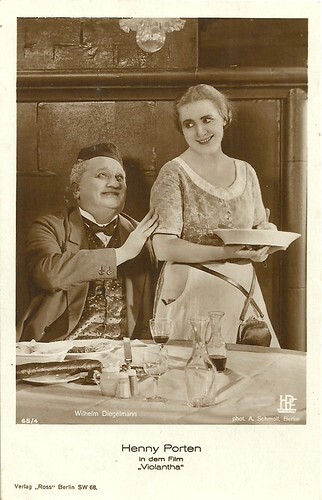
German postcard by Ross Verlag, no. 68/4. Photo: A. Schmoll, Berlin / Henny Porten-Film. Henny Porten and Wilhelm Diegelmann in the German silent drama Violantha (Carl Froehlich, 1927).
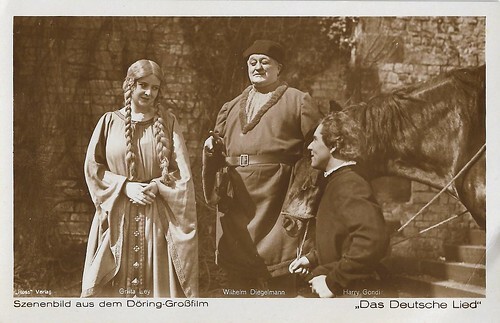
German postcard by Ross Verlag, unnumbered. Publicity still for the German silent film Das Deutsche Lied (Karl Pindl, 1928), produced by the Döring film company, Hannover, under the guidance [Protektorat] of the Deutsche Sängerbund (DSB). Premiered in Vienna, Austria, at the 10th German Sängerbundesfest 19.-23.July 1928. Here Gritta Ley as Irmgard, Harry Gondi as Walther von der Vogelweide, and Wilhelm Diegelmann as Burgvogt, in the historical part of the film.
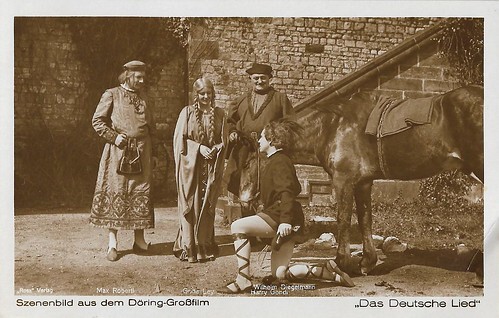
German postcard by Ross Verlag, unnumbered. Max Roberti as Graf Kuno von Eisack, Gritta Ley as his daughter Irmgard, Harry Gondi as Walther von der Vogelweide, and Wilhelm Diegelmann as Burgvogt in Das Deutsche Lied (Karl Pindl, 1928), produced by the Döring film company, Hannover, under guidance [Protektorat] of the Deutsche Sängerbund (DSB). Premiered in Vienna, Austria, at the 10th German Sängerbundesfest 19.-23.July 1928.
Sources: Thomas Staedeli (Cyranos), Wikipedia (English and German) and .

German postcard by Verlag Hermann Leiser, Berlin-Wilm., no. 7131. Photo: Hans Böhm.

German postcard by Photochemie, no. K.2725. Photo: Max Mack-Film. Rosa Veldtkirch and Wilhelm Diegelmann in Opfer um Opfer (Max Mack, 1918), starring Karl Beckersachs. The film is lost.

German postcard by Ross Verlag, no. 989/3. This postcard is dated: Stuttgart, 19 June 1925. Photo: Ufa. Wilhelm Diegelman as Uncle Uhl in Kampf um die Scholle/Struggle for the Soil (Erich Waschneck, 1925).

German postcard by Ross Verlag, Berlin-Wilm., no. 1555/1, 1927-1928. Photo: A. Binder, Berlin.
Father figure, bishop or innkeeper
Wilhelm Diegelmann was born in 1861 in Ellers, Neuhof, Electorate of Hesse, now Neuhof, Hesse, Germany.
Diegelmann's first stage appearance was in 1878 in the chorus for the Frankfurt Opera. In 1881 he debuted at the Frankfurt City Theater, playing Wallenstein, Nathan the Wise, King Lear, William Tell, and other title characters.
In 1907, Diegelmann relocated to Berlin. Here, he appeared at the Deutsches Theater, but later also at the Berliner Theater, the Großes Schauspielhaus, and the Deutsches Künstlertheater. After decades of stage acting, he appeared in Max Reinhardt 's film Die Insel der Seligen/The Islands of Bliss (1913) starring Ernst Hoffmann and Ernst Matráy .
Diegelmann started a parallel, second career as a silent film actor in 1913. In the following years, the likeable actor played in countless films, often in artistic demanding and successful works like Ernst Lubitsch's comedy Prinz Sami (1917) and the cinematic highlights Carmen (Ernst Lubitsch, 1918) and the groundbreaking gay-themed film Anders als die Anderen/Different from the Others (Richard Oswald, 1919).
In German silent cinema, he became a prolific actor in supporting roles, often as a father figure, guard, bishop or innkeeper, both in dramas and comedies. Between 1913 and his death in 1934 he played in 247 films, including also some ten German early sound films. At Cyranos , Thomas Staedeli writes: "The actor Wilhelm Diegelmann belongs to the primary rock of the German silent movie."

German postcard by Photochemie, Berlin, no. K. 1994. Photo: Union Film. Erna Morena and Wilhelm Diegelmann in Prima Vera (Paul Leni, 1917), based on Alexandre Dumas fils's novel and play 'La dame aux camélias'.

German postcard in the Film Sterne series by Rotophot, no. 563/3. Photo: Richard-Oswald-Film. Postcard for the German silent film Das Dreimäderlhaus/The House of Three Girls (Richard Oswald, 1918), considered a lost film. It tells about the life of composer Franz Schubert (Julius Spielmann, the man with spectacles in the middle here). Right of Spielmann stands Conrad Veidt , who plays Baron Schober, while the tall, sturdy man on the left may be Wilhelm Diegelmann (Tschöll). The three daughters are played by Sybile Binder, Käthe Oswald, and Ruth Werner.

German postcard by Ross Verlag, no. 577. Photo: Fern-Andra-Atelier. Fern Andra , probably Olga Engl and Wilhelm Diegelmann in Der Todessprung/Um Krone und Peitsche/Crown and Whip (Georg Bluen, Fern Andra, 1919).

German postcard by Ross Verlag, no. 646/6. Photo: HPF [Henny Porten Film]. Henny Porten in Die Geyer-Wally/Die Geier-Wally (E.A. Dupont, 1921). Although drama and romance dominate, the film has some witty scenes, such as the one in which Wally rejects the marriage proposal by farmer Rosenbauer senior (Wilhelm Diegelmann) and his son (Gerd Fricke).
Lubitsch, Lang, Murnau and Von Sternberg
Wilhelm Diegelmann became the epitome of Weimar cinema. He played in famous titles such as the comedy Robert und Bertram, die lustigen Vagabunden/Robert and Bertram (Max Mack, 1915), the historical film Veritas Vincit (Joe May, 1919), the adventure fantasy Das indische Grabmal/The Indian Tomb (Joe May, 1921), Der müde Tod/Destiny (Fritz Lang, 1921), the farcical comedy Die Bergkatze/The Wild Cat (Ernst Lubitsch, 1921) starring Pola Negri , Phantom (F.W. Murnau, 1922) with Alfred Abel and Kampf um die Scholle (Erich Waschneck, 1925) as well as in lesser-known films.
He worked with reputed directors such as Max Mack , Paul Wegener , Joe May , Ernst Lubitsch , Paul Leni, E.A. Dupont, Fritz Lang and F.W. Murnau and acted opposite all the famous actresses of the German silent cinema: Mia May , Erna Morena , Pola Negri , Fern Andra , Asta Nielsen , etc.
In particular, he often costarred with Henny Porten in films like Die Wellen schweigen/The waves are silent (Rudolf Biebrach, 1915), Feeënhande/Fairy hands (Rudolf Biebrach, 1917), Monika Vogelsang (Rudolf Biebrach, 1920), Anna Boleyn (Ernst Lubitsch, 1920), Die Geierwally/The Vulture Wally (Ewald André Dupont, 1921), Mutter und Kind/Mother and Child (Carl Froelich, 1924), and Violantha (Carl Froelich, 1927). He was paired with comedians such as Anna Müller-Lincke , Senta Söneland , Ernst Lubitsch , Mady Christians , Lya Mara , and Reinhold Schünzel , but also with crime fighters like Carl Auen , Ernst Reicher and Max Landa .
In the sound era, he performed in the classic Der Blaue Engel/The Blue Angel (Josef von Sternberg, 1930), where he played a ship captain who flirts with the singer Lola Lola ( Marlene Dietrich ) and promptly feels the jealousy of her new husband ( Emil Jannings ). He also appeared in Harry Piel's Der Geheimagent/Secret Agent (Harry Piel, 1932) and the Nazi propagandafilm Hans Westmar (Franz Wenzler, 1932).
His final film was the Theodor Storm adaptation Der Schimmelreiter/The Rider on the White Horse (Hans Deppe, Curt Oertel, 1934) starring Mathias Wieman . After this, Diegelmann continued to make stage appearances, with his last role being in 'Rembrandt vor Gericht' (Rembrandt in Court) by Hans Kyser. He died not long after this in 1934 in Berlin, at 72. He was interred at the Südwestkirchhof Stahnsdorf near Berlin, though the grave no longer exists.

German postcard by Ross Verlag, no. 700/9. Photo: Ufa. Publicity still for Kampf um die Scholle/Struggle for the Soil (Erich Waschneck, 1925) with Oskar Marion as Franz, the younger brother of estate owner Axel, who has an affair with Luise ( Mary Parker ), daughter of the estate manager Karl Marten (left; Otto Kronburger). The man behind Parker is Wilhelm Diegelmann, who plays Uncle Uhl. The man left of him is Otto Kronburger, who plays Luise's father, Karl Marten.

German postcard by Ross Verlag, no. 68/4. Photo: A. Schmoll, Berlin / Henny Porten-Film. Henny Porten and Wilhelm Diegelmann in the German silent drama Violantha (Carl Froehlich, 1927).

German postcard by Ross Verlag, unnumbered. Publicity still for the German silent film Das Deutsche Lied (Karl Pindl, 1928), produced by the Döring film company, Hannover, under the guidance [Protektorat] of the Deutsche Sängerbund (DSB). Premiered in Vienna, Austria, at the 10th German Sängerbundesfest 19.-23.July 1928. Here Gritta Ley as Irmgard, Harry Gondi as Walther von der Vogelweide, and Wilhelm Diegelmann as Burgvogt, in the historical part of the film.

German postcard by Ross Verlag, unnumbered. Max Roberti as Graf Kuno von Eisack, Gritta Ley as his daughter Irmgard, Harry Gondi as Walther von der Vogelweide, and Wilhelm Diegelmann as Burgvogt in Das Deutsche Lied (Karl Pindl, 1928), produced by the Döring film company, Hannover, under guidance [Protektorat] of the Deutsche Sängerbund (DSB). Premiered in Vienna, Austria, at the 10th German Sängerbundesfest 19.-23.July 1928.
Sources: Thomas Staedeli (Cyranos), Wikipedia (English and German) and .
Published on January 12, 2024 22:00
January 11, 2024
Hollywood's star pin-ups from the 1940s, 1950s and 1960s
Va-va-voom... Last week, we did a post with 21 vintage European star pin-ups of the 1950s and 1960s. It's time for Hollywood.
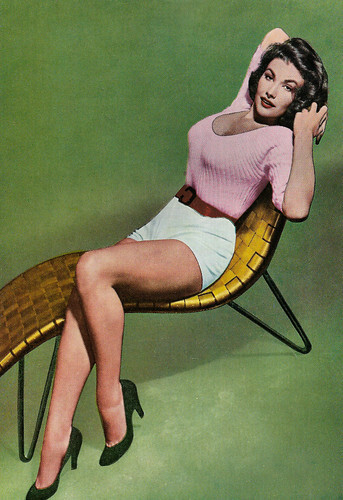
German postcard by Terra-Color, no. PU 8. Photo: Warner Bros. Pictures, Inc.
American actress Mara Corday (1930) was also a popular showgirl, model and Playboy Playmate of the 1950s.
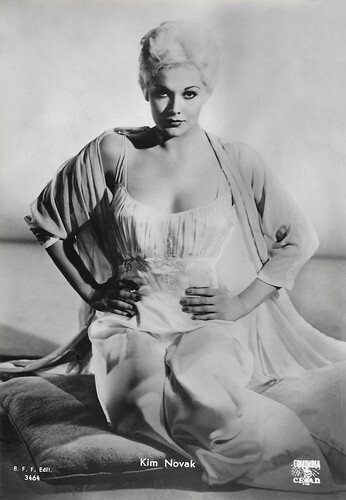
Italian postcard by B.F.F. Edit, no. 3464. Photo: Columbia / CEIAD.
American film and television actress Kim Novak (1933) starred in such popular successes as Picnic (1955), The Man with the Golden Arm (1955) and Pal Joey (1957). However, she is perhaps best known today for her ‘dual role’ as both Judy Barton and Madeleine Elster in Alfred Hitchcock's classic thriller Vertigo (1958). She withdrew from acting in 1966 and has only sporadically returned since.
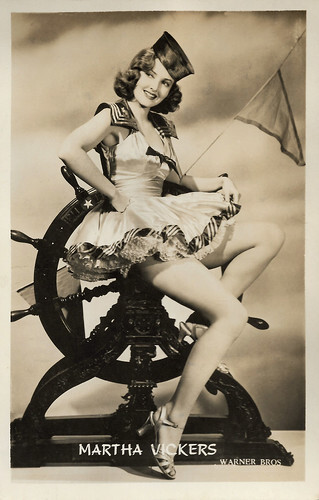
Vintage card. Photo: Warner Bros.
Lovely, auburn-haired American actress Martha Vickers (1925-1971) began her career as a model and cover girl. She is best known as Lauren Bacall's wild, thumb-sucking sister in the classic Film Noir The Big Sleep (1946).
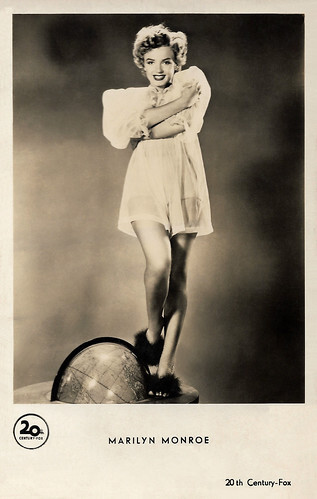
West German postcard by Kunst und Bild, Berlin, no. A 1083. Photo: 20th Century Fox.
By 1953, Marilyn Monroe (1926-1962) was one of the most marketable Hollywood stars, with leading roles in three films: the noir Niagara, which focused on her sex appeal, and the comedies Gentlemen Prefer Blondes and How to Marry a Millionaire, which established her star image as a "dumb blonde". Although she played a significant role in the creation and management of her public image throughout her career, she was disappointed at being typecast and underpaid by the studio. She was briefly suspended in early 1954 for refusing a film project, but returned to star in one of the biggest box office successes of her career, The Seven Year Itch (1955).
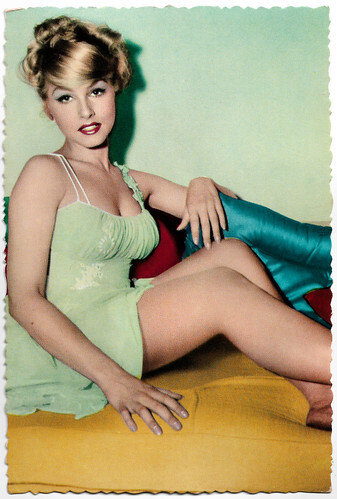
Spanish postcard by Archivo Bermejo, no. C 2. Photo: Warner Bros.
Voluptuous American actress Julie Newmar (1933) with her seductive deep voice is our all-time favourite Catwoman. She was very busy on television and the stage in the 1960s and 1970s but also appeared in several films.
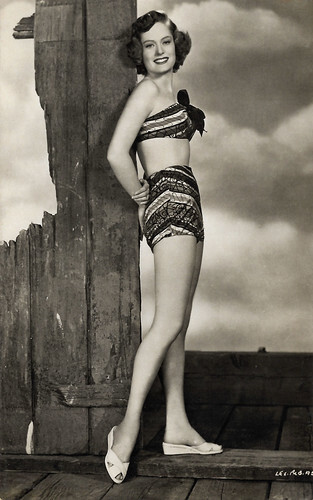
Vintage postcard. Photo: Warner Bros.
Statuesque, smart Canadian-born Alexis Smith (1921-1993), with her blue/green eyes and a seductively husky voice, lent a touch of class to her leading ladies of the 1940s and 1950s. She was paired with the top male stars in Hollywood, including Clark Gable, Humphrey Bogart, William Holden and Bing Crosby. She was stylishly attired by costume designers like Milo Anderson and Helen Rose in the most glamorous gowns but also proved to be a capable and spirited actress. She reserved her best acting for the stage and in 1972, she won a Tony award for her starring role in Stephen Sondheim's musical 'Follies'.
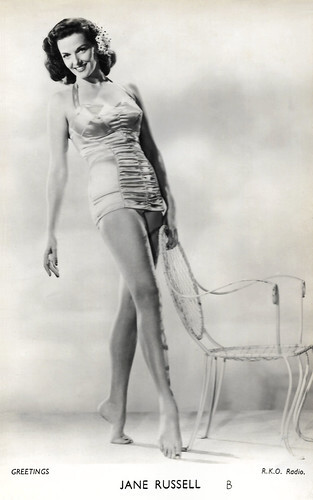
British postcard in the Greetings series, no. B. Photo: R.K.O. Radio.
American film actress Jane Russell (1921-2011) was one of Hollywood's leading sex symbols in the 1940s and 1950s. In 1943, she had her first film role in Howard Hughes' The Outlaw. In 1947, Russell delved into music. Her film career revived when she was cast as Calamity Jane opposite Bob Hope in The Paleface (1948). After starring in several films in the 1950s, including Gentlemen Prefer Blondes (1953), Russell again returned to music while completing several other films in the 1960s. She starred in more than 20 films throughout her career.
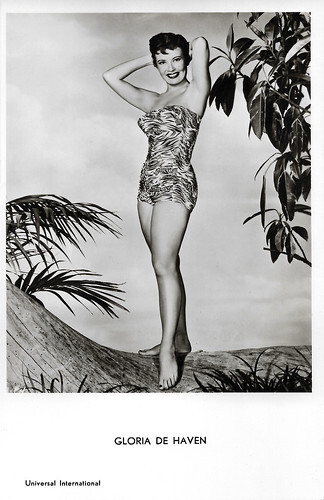
Belgian postcard, no. 317. Photo: Universal International.
American actress and singer Gloria DeHaven (1925-2016) was a contract star for Metro-Goldwyn-Mayer and often played the second lead in cheerful light musicals.
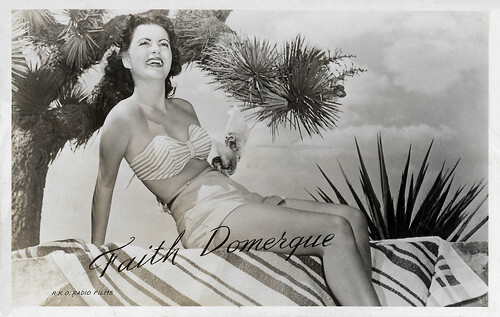
Dutch postcard by Takken / 't Sticht, no. AX 213. Photo: Foto archief Film en Toneel.
Faith Domergue was one of the many actresses who have crossed the path of eccentric Howard Hughes. She never became as successful as Jane Russell, another Hughes’ protégée, but she still made her mark in the movies and notably starred in the Science-Fiction classic This Island Earth (1955).
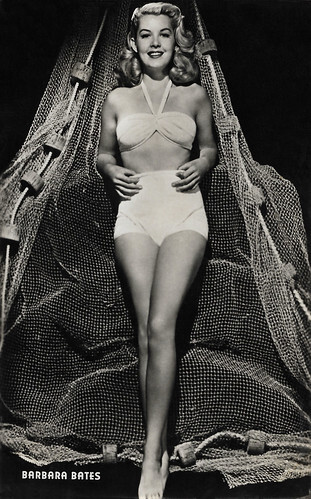
Vintage card.
American actress and singer Barbara Bates (1925-1969) was best known for her role as Phoebe, the slyly manipulative fan of stage actress Anne Baxter in the closing scene of All About Eve (1950). She also played Clifron Webb and Myrna Loy's daughter Ernestine in the popular Fox-family comedy Cheaper by the Dozen (1950), and its sequel, Belles on Their Toes (1952). Bates committed suicide at the age of 43.
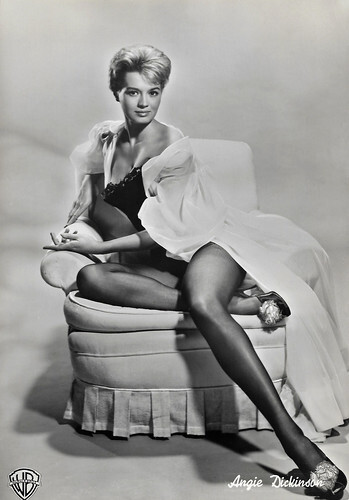
Italian postcard by Bromofoto, Milano, no. 1748. Photo: Warner Bros. Angie Dickinson in Ocean's Eleven (Lewis Milestone, 1960).
American actress Angie Dickinson (1931) has appeared in more than 50 films and starred on television as Sergeant Leann 'Pepper' Anderson in the successful 1970s crime series Police Woman. Her trademarks are her honey-blonde hair (on the postcard she still has her original brunette hair colour), her large brown eyes, her voluptuous figure and her deep sultry voice.
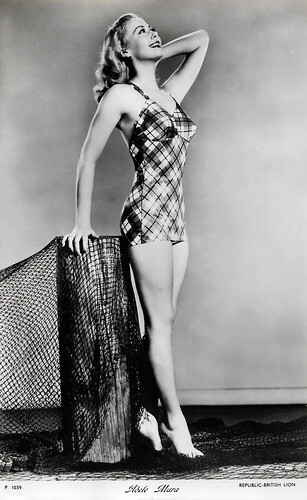
British postcard in the The People series by Show Parade Picture Service, London, no. P. 1039. Photo: Republic - British Lion.
Adele Mara (1923-2010) was an American actress, singer, and dancer, who appeared in films during the 1940s and 1950s and on television in the 1950s and 1960s. During the 1940s, the blonde actress was also a popular pin-up girl.
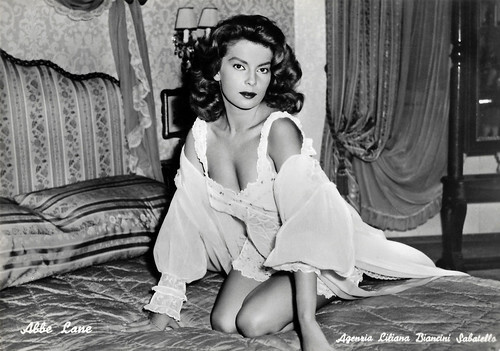
Italian postcard by Bromofoto, Milano, no. 1457. Photo: Agenzia Liliana Biancini Sabatello.
Va-va-voom singer Abbe Lane (1932) achieved her greatest success as the vocalist for Xavier Cugat's orchestra, but she also appeared in several American and Italian films. The beautiful, curvaceous Lane was nicknamed 'the swingingest sexpot in show business.'
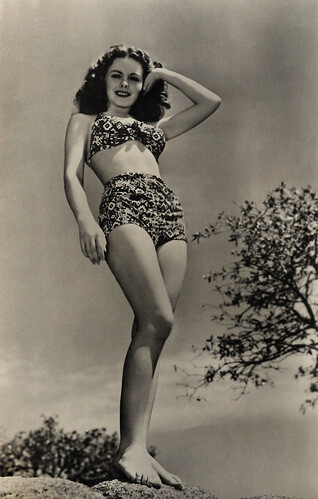
Spanish postcard. no. 3088.
Charming, youthful and pretty American actress Jeanne Crain (1925-2003) was frequently cast in bright and breezy musicals. She received an Oscar nomination for Best Actress in Pinky (1949), in which she played the title role. Her career spanned from 1943 to 1975.
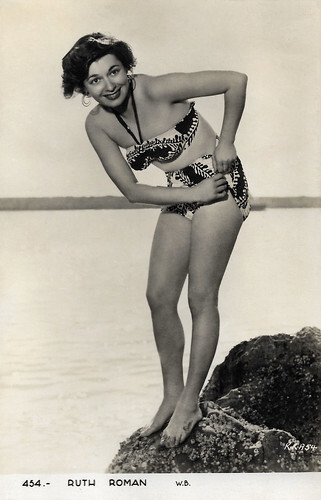
Spanish postcard, no. 454. Photo: Warner Bros.
American actress Ruth Roman (1922–1999) had a memorable role in Alfred Hitchcock's thriller Strangers on a Train (1951).
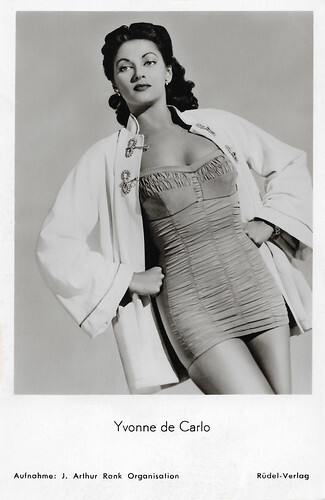
West-German postcard by Rüdel-Verlag, Hamburg-Bergedorf, no. 542. Photo: J. Arthur Rank Organisation. Yvonne De Carlo in Hotel Sahara (Ken Annakin, 1951).
Dark-haired Hollywood beauty Yvonne De Carlo (1922–2007) was a Canadian-American actress, singer, and dancer whose career in film, television, and musical theatre spanned six decades. From the 1950s on, she also starred in British and Italian films. She achieved her greatest popularity as the ghoulish matriarch Lily in the TV sitcom The Munsters (1964-1966).
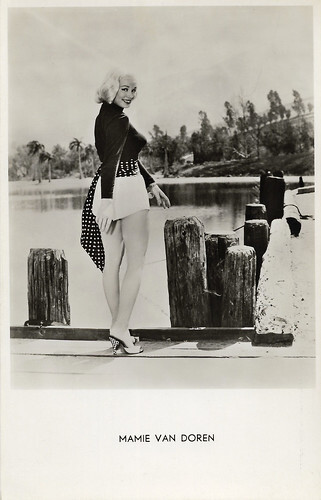
Belgian postcard, no. 96.
Voluptuous American actress Mamie Van Doren (1931) was a sex symbol of the 1950s and 1960s. Van Doren starred in several exploitation films such as Untamed Youth (1957), loaded with rock 'n' roll and juvenile delinquency. Her onscreen wardrobe usually consisted of tight sweaters, low-cut blouses, form-fitting dresses, and daring swimsuits. Mamie and her colleague blonde bombshells Marilyn Monroe and Jayne Mansfield were known as 'The Three M's.'
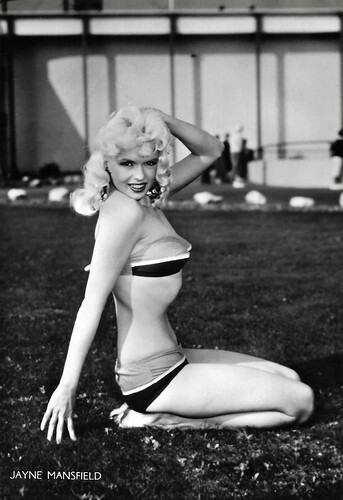
Italian postcard, no. 584.
Some Hollywood stars were much more popular in Europe than at home. A fabulous example is sweet Jayne Mansfield (1933-1967), one of Hollywood's original platinum blonde bombshells. Although most of her American films did not do much at the European box offices, Jayne herself was a sensation whenever she came to Europe to promote her films. During the 1960s when Hollywood had lost its interest in her, Jayne continued to appear cheerfully in several European films.
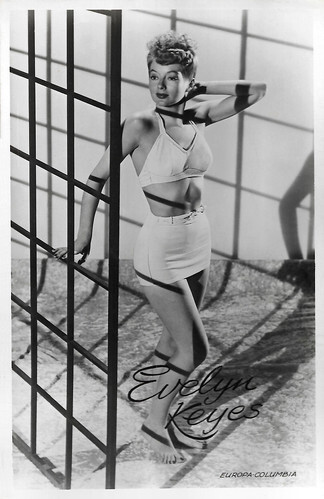
Dutch postcard, no. 3198. Photo: Europa Columbia.
Evelyn Keyes (1916-2008) was an American film actress. She is best known for her role as Suellen O'Hara in Gone with the Wind (1939) and for the female lead in the blockbuster hit The Jolson Story (1946). Her final film was The Seven Year's Itch (1955) starring Marilyn Monroe.
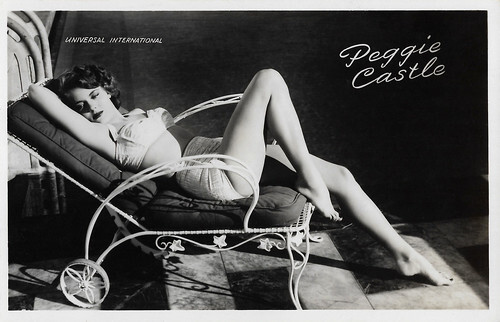
Dutch postcard by Takken, no. 461. Photo: Universal International.
Tall, sultry, green-eyed blonde Peggie Castle (1927-1973) was an American actress who specialised in playing the "other woman" in B-movies. Castle was Miss Cheesecake in 1949.
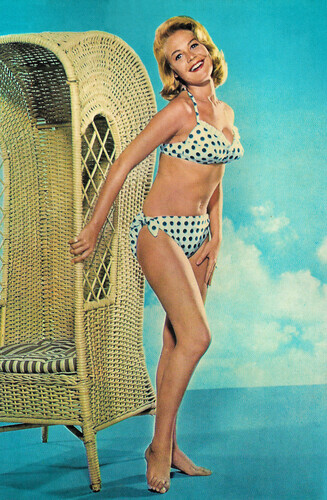
Italian postcard, no. 8. Photo: Universal International.
'All-American-Darling' Sandra Dee (1942/1944-2005) was an American film actress who was often referred to as 'the next Doris Day'. Sandra was the most popular teen star of the late 1950s and early 1960s.

German postcard by Terra-Color, no. PU 8. Photo: Warner Bros. Pictures, Inc.
American actress Mara Corday (1930) was also a popular showgirl, model and Playboy Playmate of the 1950s.

Italian postcard by B.F.F. Edit, no. 3464. Photo: Columbia / CEIAD.
American film and television actress Kim Novak (1933) starred in such popular successes as Picnic (1955), The Man with the Golden Arm (1955) and Pal Joey (1957). However, she is perhaps best known today for her ‘dual role’ as both Judy Barton and Madeleine Elster in Alfred Hitchcock's classic thriller Vertigo (1958). She withdrew from acting in 1966 and has only sporadically returned since.

Vintage card. Photo: Warner Bros.
Lovely, auburn-haired American actress Martha Vickers (1925-1971) began her career as a model and cover girl. She is best known as Lauren Bacall's wild, thumb-sucking sister in the classic Film Noir The Big Sleep (1946).

West German postcard by Kunst und Bild, Berlin, no. A 1083. Photo: 20th Century Fox.
By 1953, Marilyn Monroe (1926-1962) was one of the most marketable Hollywood stars, with leading roles in three films: the noir Niagara, which focused on her sex appeal, and the comedies Gentlemen Prefer Blondes and How to Marry a Millionaire, which established her star image as a "dumb blonde". Although she played a significant role in the creation and management of her public image throughout her career, she was disappointed at being typecast and underpaid by the studio. She was briefly suspended in early 1954 for refusing a film project, but returned to star in one of the biggest box office successes of her career, The Seven Year Itch (1955).

Spanish postcard by Archivo Bermejo, no. C 2. Photo: Warner Bros.
Voluptuous American actress Julie Newmar (1933) with her seductive deep voice is our all-time favourite Catwoman. She was very busy on television and the stage in the 1960s and 1970s but also appeared in several films.

Vintage postcard. Photo: Warner Bros.
Statuesque, smart Canadian-born Alexis Smith (1921-1993), with her blue/green eyes and a seductively husky voice, lent a touch of class to her leading ladies of the 1940s and 1950s. She was paired with the top male stars in Hollywood, including Clark Gable, Humphrey Bogart, William Holden and Bing Crosby. She was stylishly attired by costume designers like Milo Anderson and Helen Rose in the most glamorous gowns but also proved to be a capable and spirited actress. She reserved her best acting for the stage and in 1972, she won a Tony award for her starring role in Stephen Sondheim's musical 'Follies'.

British postcard in the Greetings series, no. B. Photo: R.K.O. Radio.
American film actress Jane Russell (1921-2011) was one of Hollywood's leading sex symbols in the 1940s and 1950s. In 1943, she had her first film role in Howard Hughes' The Outlaw. In 1947, Russell delved into music. Her film career revived when she was cast as Calamity Jane opposite Bob Hope in The Paleface (1948). After starring in several films in the 1950s, including Gentlemen Prefer Blondes (1953), Russell again returned to music while completing several other films in the 1960s. She starred in more than 20 films throughout her career.

Belgian postcard, no. 317. Photo: Universal International.
American actress and singer Gloria DeHaven (1925-2016) was a contract star for Metro-Goldwyn-Mayer and often played the second lead in cheerful light musicals.

Dutch postcard by Takken / 't Sticht, no. AX 213. Photo: Foto archief Film en Toneel.
Faith Domergue was one of the many actresses who have crossed the path of eccentric Howard Hughes. She never became as successful as Jane Russell, another Hughes’ protégée, but she still made her mark in the movies and notably starred in the Science-Fiction classic This Island Earth (1955).

Vintage card.
American actress and singer Barbara Bates (1925-1969) was best known for her role as Phoebe, the slyly manipulative fan of stage actress Anne Baxter in the closing scene of All About Eve (1950). She also played Clifron Webb and Myrna Loy's daughter Ernestine in the popular Fox-family comedy Cheaper by the Dozen (1950), and its sequel, Belles on Their Toes (1952). Bates committed suicide at the age of 43.

Italian postcard by Bromofoto, Milano, no. 1748. Photo: Warner Bros. Angie Dickinson in Ocean's Eleven (Lewis Milestone, 1960).
American actress Angie Dickinson (1931) has appeared in more than 50 films and starred on television as Sergeant Leann 'Pepper' Anderson in the successful 1970s crime series Police Woman. Her trademarks are her honey-blonde hair (on the postcard she still has her original brunette hair colour), her large brown eyes, her voluptuous figure and her deep sultry voice.

British postcard in the The People series by Show Parade Picture Service, London, no. P. 1039. Photo: Republic - British Lion.
Adele Mara (1923-2010) was an American actress, singer, and dancer, who appeared in films during the 1940s and 1950s and on television in the 1950s and 1960s. During the 1940s, the blonde actress was also a popular pin-up girl.

Italian postcard by Bromofoto, Milano, no. 1457. Photo: Agenzia Liliana Biancini Sabatello.
Va-va-voom singer Abbe Lane (1932) achieved her greatest success as the vocalist for Xavier Cugat's orchestra, but she also appeared in several American and Italian films. The beautiful, curvaceous Lane was nicknamed 'the swingingest sexpot in show business.'

Spanish postcard. no. 3088.
Charming, youthful and pretty American actress Jeanne Crain (1925-2003) was frequently cast in bright and breezy musicals. She received an Oscar nomination for Best Actress in Pinky (1949), in which she played the title role. Her career spanned from 1943 to 1975.

Spanish postcard, no. 454. Photo: Warner Bros.
American actress Ruth Roman (1922–1999) had a memorable role in Alfred Hitchcock's thriller Strangers on a Train (1951).

West-German postcard by Rüdel-Verlag, Hamburg-Bergedorf, no. 542. Photo: J. Arthur Rank Organisation. Yvonne De Carlo in Hotel Sahara (Ken Annakin, 1951).
Dark-haired Hollywood beauty Yvonne De Carlo (1922–2007) was a Canadian-American actress, singer, and dancer whose career in film, television, and musical theatre spanned six decades. From the 1950s on, she also starred in British and Italian films. She achieved her greatest popularity as the ghoulish matriarch Lily in the TV sitcom The Munsters (1964-1966).

Belgian postcard, no. 96.
Voluptuous American actress Mamie Van Doren (1931) was a sex symbol of the 1950s and 1960s. Van Doren starred in several exploitation films such as Untamed Youth (1957), loaded with rock 'n' roll and juvenile delinquency. Her onscreen wardrobe usually consisted of tight sweaters, low-cut blouses, form-fitting dresses, and daring swimsuits. Mamie and her colleague blonde bombshells Marilyn Monroe and Jayne Mansfield were known as 'The Three M's.'

Italian postcard, no. 584.
Some Hollywood stars were much more popular in Europe than at home. A fabulous example is sweet Jayne Mansfield (1933-1967), one of Hollywood's original platinum blonde bombshells. Although most of her American films did not do much at the European box offices, Jayne herself was a sensation whenever she came to Europe to promote her films. During the 1960s when Hollywood had lost its interest in her, Jayne continued to appear cheerfully in several European films.

Dutch postcard, no. 3198. Photo: Europa Columbia.
Evelyn Keyes (1916-2008) was an American film actress. She is best known for her role as Suellen O'Hara in Gone with the Wind (1939) and for the female lead in the blockbuster hit The Jolson Story (1946). Her final film was The Seven Year's Itch (1955) starring Marilyn Monroe.

Dutch postcard by Takken, no. 461. Photo: Universal International.
Tall, sultry, green-eyed blonde Peggie Castle (1927-1973) was an American actress who specialised in playing the "other woman" in B-movies. Castle was Miss Cheesecake in 1949.

Italian postcard, no. 8. Photo: Universal International.
'All-American-Darling' Sandra Dee (1942/1944-2005) was an American film actress who was often referred to as 'the next Doris Day'. Sandra was the most popular teen star of the late 1950s and early 1960s.
Published on January 11, 2024 22:00
January 10, 2024
Ernst Lubitsch
Today is the start of the Netherlands Silent Film Festival (11-14 January) in Eindhoven. We're gonna watch the sensual comedy Forbidden Paradise (1924) directed by Ernst Lubitsch (1892-1947). The German-American actor, screenwriter, producer and film director started his career in the silent cinema of the Weimar Republic. During the 1920s, his urbane comedies of manners made him Hollywood's most elegant and sophisticated director. His films were promoted as having 'the Lubitsch touch', due to his wit and style.

German postcard by Ross Verlag, no. 415/1, 1919-1924. Photo: Rembrandt.
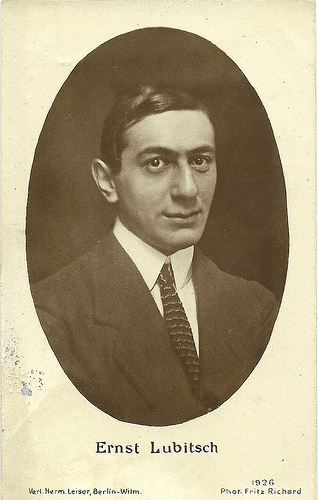
German postcard by Verlag Hermann Leiser, Berlin-Wilm., no. 1926. Photo: Fritz Richard. Collection: Didier Hanson.
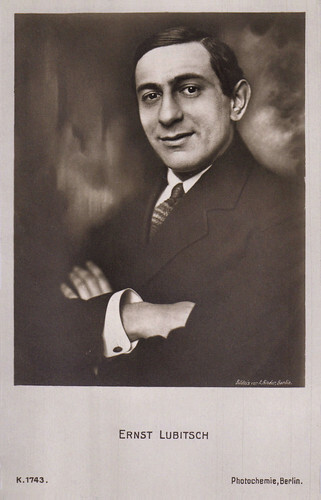
German postcard by Photochemie, no. K. 1743. Photo: Alex Binder, Paris. Collection: Marlene Pilaete.
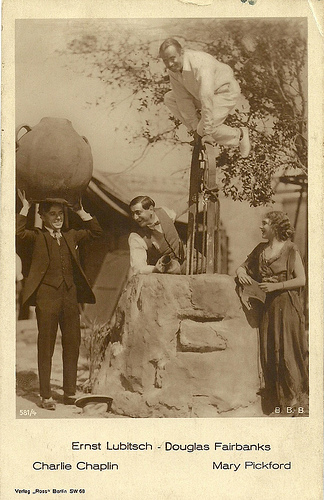
German postcard by Ross Verlag, Berlin, no. 581/4, 1919-1924. Photo: B.B.B. Collection: Didier Hanson. Ernst Lubitsch with Douglas Fairbanks , Charlie Chaplin and Mary Pickford .
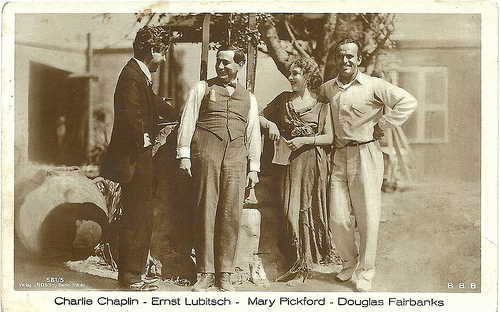
German postcard by Ross Verlag, no. 581/5, 1919-1924. Photo: B.B.B. Collection: Didier Hanson. Ernst Lubitsch with Charlie Chaplin , Mary Pickford and Douglas Fairbanks .
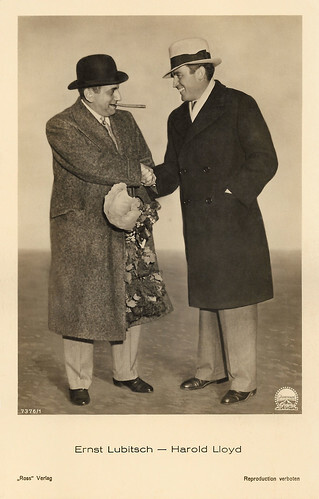
German postcard by Ross Verlag, no. 7376/1, 1932-1933. Photo: Paramount. Ernst Lubitsch with Harold Lloyd .
Ethnic Jewish humour
Ernst Lubitsch was born in Berlin, Germany, in 1892. He was the son of Anna (née Lindenstaedt) and Simon Lubitsch, a prosperous tailor. His family was Ashkenazi Jewish, his father was born in Grodno and his mother came from Wriezen (Oder), outside Berlin. Ernst was drawn to the stage while participating in plays staged by the Sophien Gymnasium, his Berlin high school, which he quit at 16.
To satisfy both his own urge to act and his father's desire that he take over the family business, he began leading a double life, working as a bookkeeper at his father's store by day and appearing in cabarets and music halls by night. By 1911, he was a member of Max Reinhardt 's renowned Deutsches Theater, where he quickly advanced from bit parts to character leads. To supplement his income, Lubitsch took a job in 1912 as an apprentice and general-purpose handyman at Berlin's Bioscope film studios and learned silent film acting.
Lubitsch made his film debut in Die ideale Gattin/The Ideal Wife (Hanns Heinz Ewers, Marc Henry, 1913) with Lyda Salmanova . The comedy Die Firma heiratet/The Firm Weds (Carl Wilhelm, 1913) with Albert Paulig , and its sequel Der Stolz der Firma/The Pride of the Firm (Carl Wilhelm, 1914) turned him into a popular comedian. Till 1920, he acted in approximately thirty films. Lubitsch appeared in a series of very successful film comedies as a character named Meyer in which he emphasised ethnic Jewish humour, including Meyer auf der Alm (?, 1913), and Meyer Als Soldat/Meyer as Soldier (?, 1914).
In 1914 he began to write and direct his own films. His first film as a director was Fräulein Seifenschaum/Miss Soapsuds (1914) and he established his reputation as a director, writer, producer and comedian with the foundation of the Malu-Film company, together with the actor Ernst Matráy .
He made his mark as a serious director with the drama Die Augen der Mumie Ma/The Eyes of the Mummy (Ernst Lubitsch, 1918), starring Pola Negri . He gradually abandoned acting to concentrate on directing and his last film appearance was opposite Pola Negri and Paul Wegener in the drama Sumurun (Ernst Lubitsch, 1920).
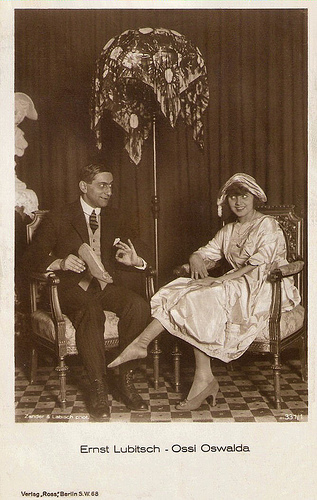
With Ossi Oswalda . German postcard by Ross Verlag, Berlin, no. 337/1, 1919-1924. Photo: Zander & Labisch.
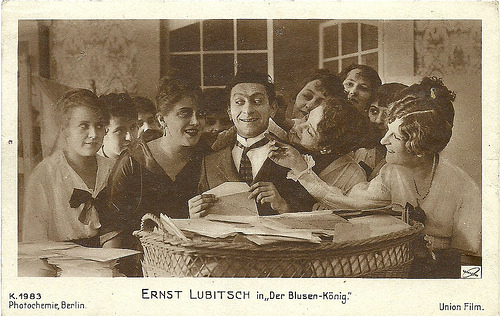
German postcard by Photochemie, no. K. 1983. Photo: Union Film. Publicity still for Der Blusen-König (Ernst Lubitsch, 1917). Collection: Didier Hanson.
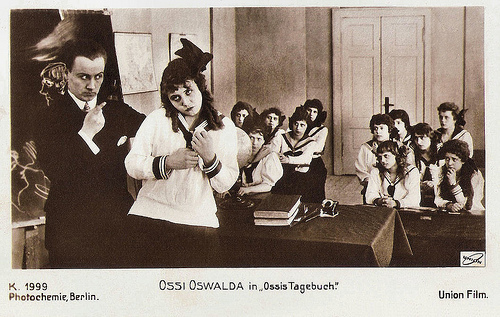
German postcard by Photochemie, Berlin, no. K. 1999. Photo: Union Film. Ossi Oswalda and Hermann Thimig in the Ossi's Tagebuch (Ernst Lubitsch, 1917).
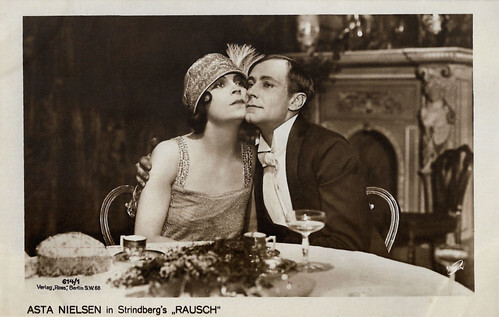
German postcard by Ross Verlag, no. 614/1. Photo: Union. Asta Nielsen and Alfred Abel in Rausch/Intoxication (Ernst Lubitsch, 1919).
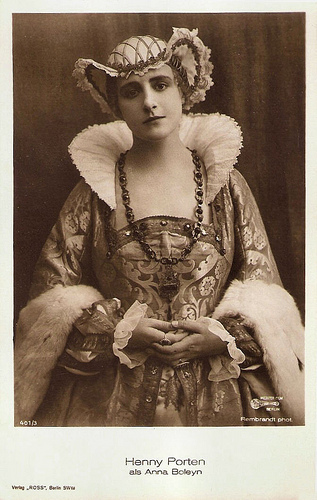
Henny Porten as Anna Boleyn in Anna Boleyn (1920). German postcard by Ross Verlag, Berlin, no. 645/3, 1919-1924. Photo: Union Film.
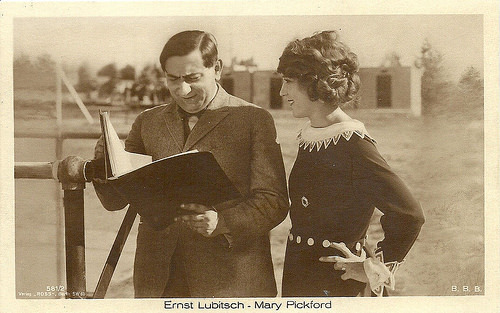
German postcard by Ross Verlag, no. 581/2, 1919-1924. Photo: B.B.B. Collection: Didier Hanson. Ernst Lubitsch with Mary Pickford .
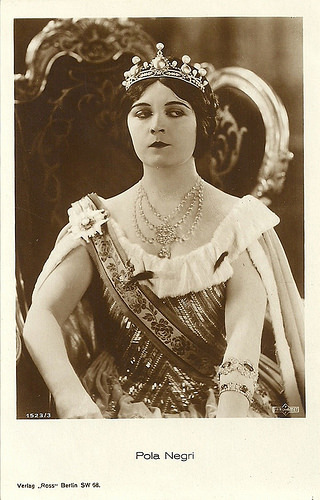
German postcard by Ross Verlag, no. 1523/3, 1927-1928. Photo: Parufamet. Pola Negri in Forbidden Paradise (Ernst Lubitsch, 1924).
Grand Master
As a director, Ernst Lubitsch alternated between escapist comedies and large-scale historical dramas, enjoying great international success with both. A triumph was Die Austernprinzessin/The Oyster Princess (Ernst Lubitsch, 1919), featuring Ossi Oswalda , a sparkling satire caricaturing American manners.
Ephraim Katz in The Film Encyclopedia : "For the first time he demonstrated the subtle humour and the virtuoso visual wit that would in time become known as 'the Lubitsch Touch'. The style was characterised by a parsimonious compression of ideas and situations into single shots or brief scenes that provided an ironic key to the characters and to the meaning of the entire film."
His reputation as a grand master of world cinema reached a new peak after the release of his spectacles Madame DuBarry/Passion (Ernst Lubitsch, 1919) with Pola Negri , and Anna Boleyn/Deception (Ernst Lubitsch, 1920) starring Henny Porten and Emil Jannings .
Both of these films found American distributorship by early 1921. Madame Du Barry and Anna Boleyn, along with his Carmen/Gypsy Blood (Ernst Lubitsch, 1921) were selected by The New York Times on its list of the 15 most important movies of 1921.
With glowing reviews under his belt, and American money flowing his way, Lubitsch formed his own production company and made the high-budget spectacular Das Weib des Pharao/The Loves of Pharaoh (Ernst Lubitsch, 1921). In 1922, he married Helene Kraus. They divorced in 1931.
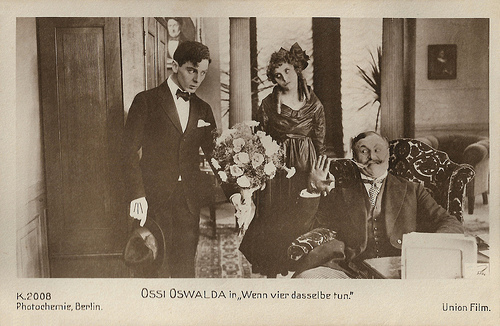
German postcard by Photochemie, Berlin, no. K. 2008. Photo: Union-Film. Publicity still for Wenn vier dasselbe tun/When Four Do the Same (Ernst Lubitsch, 1917), starring Ossi Oswalda as the girl, Fritz Schulz (here on the left) as her lover, and Emil Jannings as her father (here on the right).
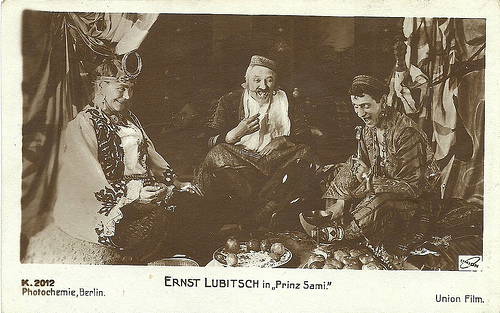
German postcard by Photochemie, Berlin, no. K. 2012. Photo: Union Film. Publicity still for Prinz Sami/Prince Sami (Ernst Lubitsch, 1918). Collection: Didier Hanson.
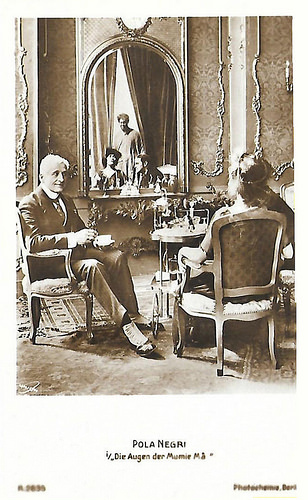
German postcard by Photochemie, Berlin, no. K. 2835. Photo: publicity still for Die Augen der Mumie Ma/The Eyes of the Mummy (Ernst Lubitsch, 1918) with Pola Negri . Collection: Didier Hanson.
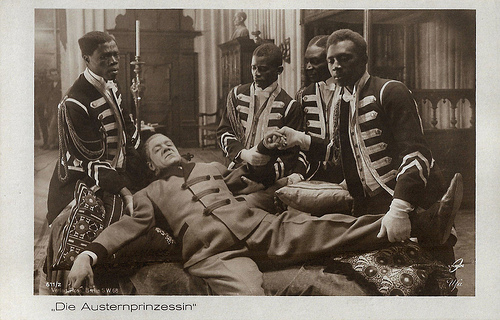
German postcard by Ross Verlag, Berlin, no. 611/2. Photo: Union / Ufa. Publicity still for Die Austernprinzessin/The Oyster Princess (Ernst Lubitsch, 1919) with Victor Janson .
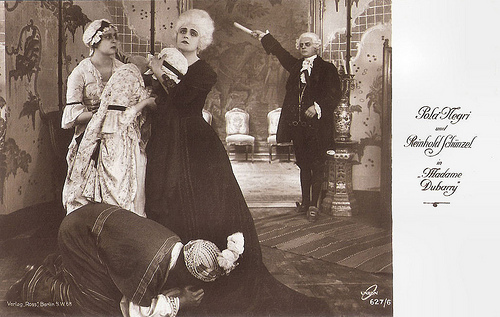
German postcard by Ross Verlag, no. 627/6. Photo: Union Film. Publicity still of Reinhold Schünzel and Pola Negri in Madame DuBarry (Ernst Lubitsch, 1919). After the death of King Louis XV ( Emil Jannings ), his minister Choiseul (Schünzel) chases DuBarry (Negri) from the Royal palace.
Hollywood
Ernst Lubitsch's success in Europe brought him to the shores of America to promote Das Weib des Pharao/The Loves of Pharaoh (1922) and he got acquainted with the thriving US film industry. Lubitsch returned briefly to Germany but soon left for good for Hollywood.
He was contracted by Mary Pickford , who wanted him to direct her in Dorothy Vernon of Haddon Hall. Upon arrival, he rejected the project and instead, he directed her in Rosita (1923). The director and star clashed during its filming. While the result was deemed a failure from her point of view, it was a critical and commercial success. It ended up as the only project that they made together.
A free agent after just one American film, Lubitsch was signed to a remarkable three-year, six-picture contract by Warner Brothers that guaranteed the director his choice of both cast and crew and full editing control over the final cut. Settling in America, Lubitsch established his reputation for sophisticated comedy with such stylish films as The Marriage Circle (1924), Lady Windermere's Fan (1925), and So This Is Paris (1926).
Ephraim Katz: "Lubitsch grasped the American psychology with an amazing accuracy and focused his satire on two main themes - sex and money. With characteristic laconic wit, he depicted sex as a frivolous pastime, a sophisticated game moneyed people play to occupy their hours of leisure. To be safe, he set his plots against foreign backgrounds - Paris, Vienna, Budapest - or some mythical land, but the implication was clearly American and audiences rarely failed to recognize themselves or their friends, their manners, their foibles, their weaknesses."
But his films were only marginally profitable for Warner Brothers, and Lubitsch's contract was eventually dissolved by mutual consent, with MGM-Paramount buying out the remainder. His first film for MGM, The Student Prince in Old Heidelberg (1927) with Ramon Novarro , was well-regarded but also lost money.
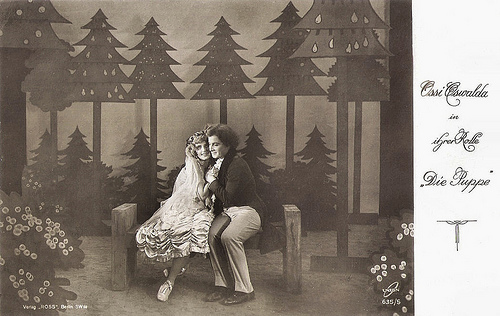
German postcard by Ross Verlag, Berlin, no. 635/5, 1919-1924. Photo: Union. Publicity still for Die Puppe/The Doll (Ernst Lubitsch, 1919) with Ossi Oswalda and Hermann Thimig .
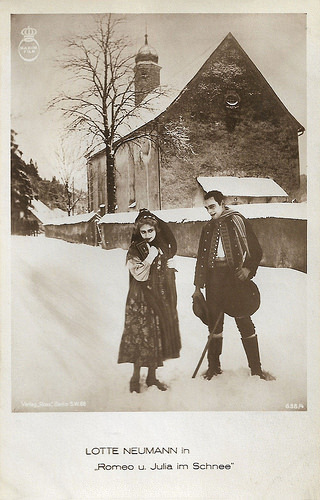
German postcard by Ross Verlag, no. 636/4. Photo: Maxim Film. Publicity still for Romeo und Julia im Schnee/Romeo and Juliet in the Snow (Ernst Lubitsch, 1920), with Lotte Neumann (Julia) and Gustav von Wangenheim (Romeo Montekugerl).
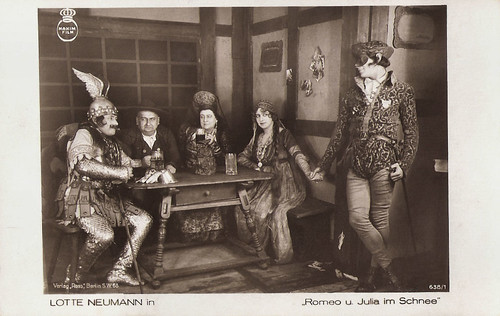
German postcard by Ross Verlag, no. 636/1. Photo: Maxim Film. Lotte Neumann in the comedy Romeo und Julia im Schnee/Romeo and Juliet in the Snow (Ernst Lubitsch, 1920). The man on the left dressed as an antique hero could be Julius Falkenstein as Paris. The others are from left to right Jakob Tiedtke (Herr Capulethofer), Marga Köhler (his wife), Lotte Neumann (Julia) and Gustav von Wangenheim (Romeo Montekugerl).
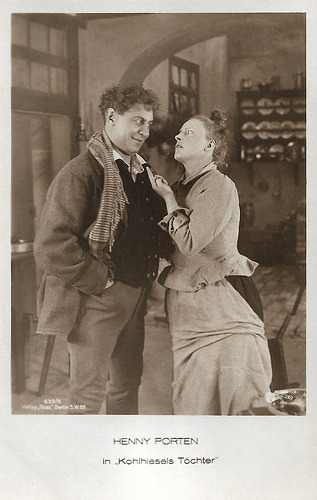
German postcard by Ross Verlag no. 639/5. Photo: Messter-Film. Publicity still for Kohlhiesels Töchter/Kohlhiesel's Daughters (Ernst Lubitsch, 1920) with Emil Jannings and Henny Porten .
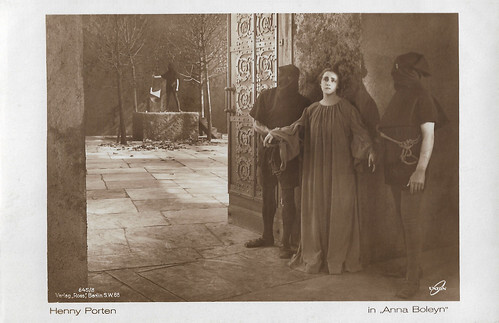
German postcard by Ross Verlag, no. 645/8. Photo: Union Film. Henny Porten in Anna Boleyn/Deception (Ernst Lubitsch, 1920).
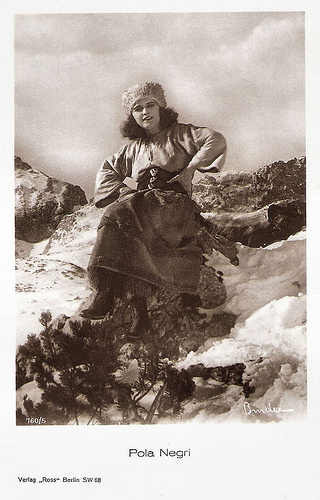
German postcard by Ross Verlag, Berlin, no. 760/5. Photo: Alex Binder. Publicity still for Die Bergkatze/Wildcat (Ernst Lubitsch, 1921) with Pola Negri .
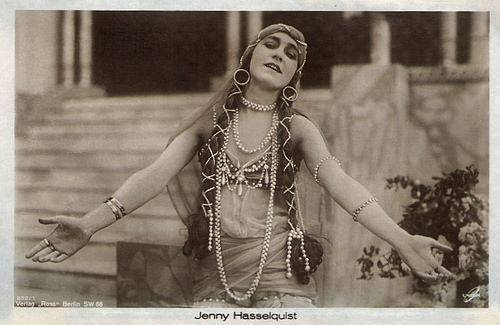
German postcard by Ross Verlag, Berlin, no. 832/1, 1919-1924. Union Film. Publicity still for Sumurun (Ernst Lubitsch, 1920) with Jenny Hasselqvist aka Jenny Hasselquist.
Musicals
Ernst Lubitsch seized upon the advent of talkies to direct musicals. With his first sound film, The Love Parade (1929), starring Maurice Chevalier and Jeanette MacDonald, Lubitsch hit his stride as a maker of worldly musical comedies and earned himself another Oscar nomination.
While most of Lubitsch's silent films had been made for Warner Bros., most of his early sound pictures were for Paramount. The Love Parade (1929), Monte Carlo (1930), and The Smiling Lieutenant (1931) were hailed by critics as masterpieces of the newly emerging musical genre. Lubitsch served on the faculty of the University of Southern California for a time.
His next film was a romantic comedy, written with Samson Raphaelson, Trouble in Paradise (1932). The cynical comedy was popular both with critics and with audiences. But it was a project that could only have been made before the enforcement of the Production Code, and after 1935, Trouble in Paradise was withdrawn from circulation. It was not seen again until 1968.
Ernst Lubitsch continued to specialise in comedy, whether with music, as in MGM's opulent The Merry Widow (1934) and Paramount's One Hour with You (1932), or without, as in Design for Living (1933). He made only one other dramatic film, the anti-war film Broken Lullaby/The Man I Killed (1932).
In 1935, he was appointed Paramount's production manager, thus becoming the only major Hollywood director to run a large studio. But Lubitsch had trouble delegating authority, which was a problem when he was overseeing sixty different films. He was fired after a year on the job and returned to full-time moviemaking.
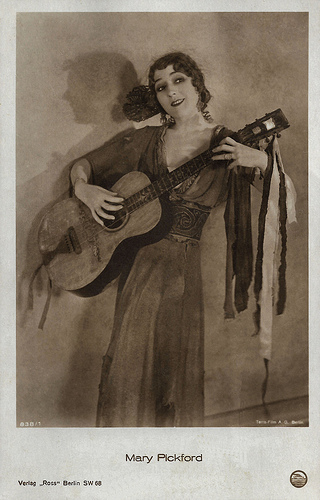
German postcard by Ross Verlag, no. 838/1. Photo: Terra Film A.G., Berlin. Mary Pickford in Rosita (Ernst Lubitsch, 1923).
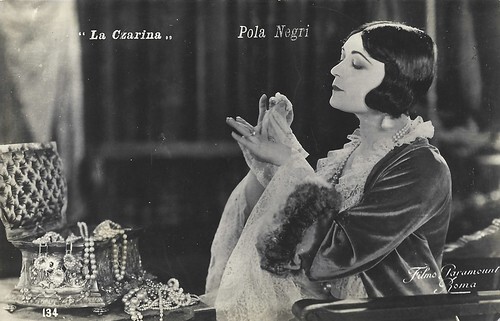
Italian postcard, no. 134. Photo: Films Paramount, Roma. Pola Negri in Forbidden Paradise (Ernst Lubitsch, 1924), launched in Italy as La Czarina.
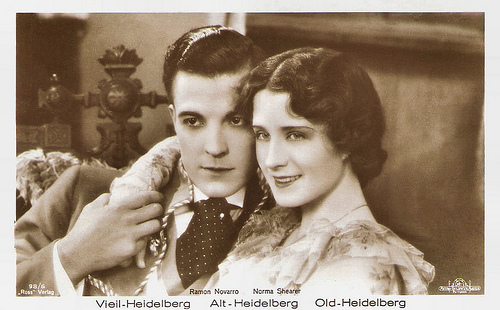
Ramon Novarro and Norma Shearer . German postcard by Ross Verlag, no. 98/6. Photo: Metro-Goldwyn-Mayer. Publicity still for The Student Prince in Old Heidelberg (Ernst Lubitsch, 1927).

German postcard by Ross Verlag, no. 98/9. Photo: Metro-Goldwyn-Mayer. Ramon Novarro in The Student Prince in Old Heidelberg (Ernst Lubitsch, 1927).
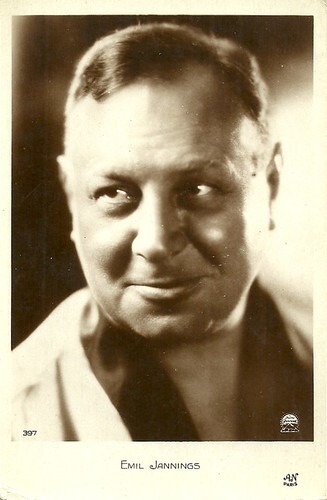
French postcard by A.N. [Noyer], Paris, no. 397. Photo: Paramount. Emil Jannings in The Patriot (Ernst Lubitsch, 1928).
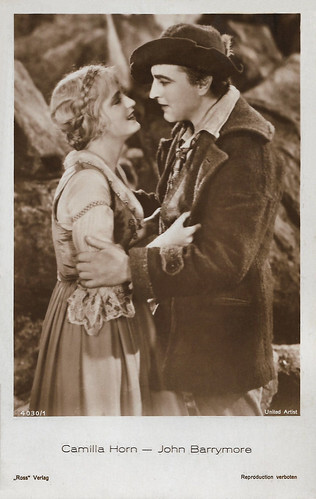
German postcard by Ross Verlag, no. 4030/1, 1929-1930. Photo: United Artists. Camilla Horn and John Barrymore in Eternal Love (Ernst Lubitsch, 1929).
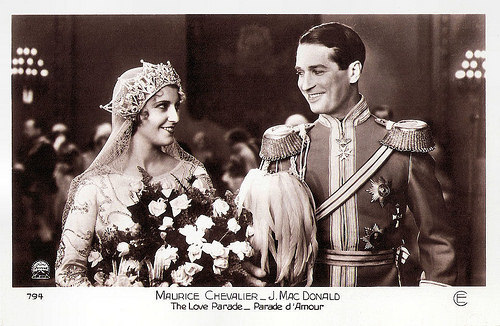
French postcard by Cinémagazine Edition, Paris, no. 794. Photo: Paramount. Publicity still for The Love Parade (Ernst Lubitsch, 1929) with Maurice Chevalier and Jeanette MacDonald.
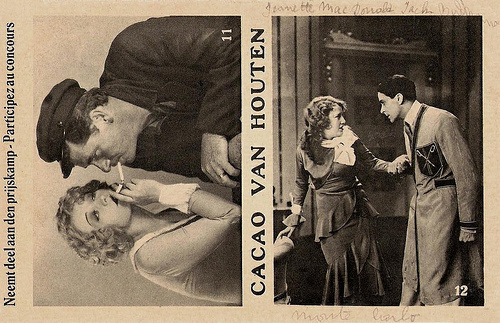
Dutch-Belgian promotion card for Cacao Van Houten, no. 11 and 12. Printed by N.V. Ned Reclamefabriek. This card was part of a series of promo cards for a quiz by Van Houten Chocolate. The public had to go to stores to guess which film star was in the photo in the shop window. There were 24 photos. At the right, we recognised (with the help of a former owner of the card Jack Buchanan and Jeanette MacDonald in Monte Carlo (Ernst Lubitsch, 1930). But who are the actors in the other picture? Name also the title of the film and the production company. In the past you could win a Philips Radio... (*)
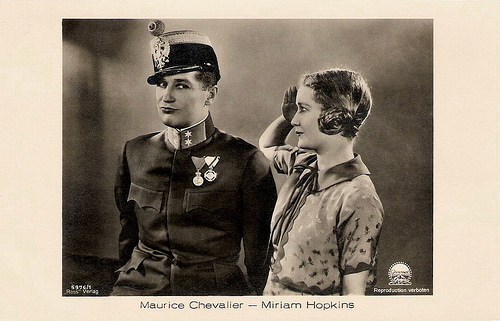
Maurice Chevalier and Miriam Hopkins . German postcard by Ross Verlag, no. 5976/1, 1931-1932. Photo: Paramount. Publicity still for The Smiling Lieutenant (Ernst Lubitsch, 1931).
Garbo laughs!
In 1935 he married his second wife, British actress Vivian Gaye. They had one daughter, Nicola Lubitsch in 1938. In 1936, he became a naturalised US citizen. Lubitsch moved to MGM and directed Greta Garbo in Ninotchka (1939). The famously serious actress' laughing scene in this satirical comedy was heavily promoted by studio publicists with the tagline "Garbo Laughs!"
In 1940, Lubitsch directed The Shop Around the Corner, an artful comedy of cross purposes. The film reunited Lubitsch with his Merry Widow screenwriter Raphaelson and starred James Stewart and Margaret Sullavan as a pair of bickering co-workers in Budapest, each unaware that the other is their secret romantic correspondent.
Lubitsch went independent to direct That Uncertain Feeling (1941, a remake of his 1925 film Kiss Me Again), and the dark anti-Nazi farce To Be or Not to Be (1942). William McPeak at IMDb on To Be or Not to Be (1942): "a biting satire of Nazi tyranny that also poked fun at Lubitsch's own theater roots with the problems and bickering - but also the triumph - of a somewhat raggedy acting troupe in Warsaw during the Nazi occupation. Jack Benny's perfect deadpan humor worked well with the zany vivaciousness of Carole Lombard , and a cast of veteran character actors from both Hollywood and Lubitsch's native Germany provided all the chemistry needed to make this a classic comedy, as well as a fierce statement against the perpetrators of war."
A heart condition curtailed his activity, and he spent much of his time in supervisory capacities. His next film, Heaven Can Wait (1943) was another Raphaelson collaboration. Then, Lubitsch worked with Edwin Justus Mayer on the scripting process of A Royal Scandal (1945), a remake of Lubitsch's silent film A Forbidden Paradise. The script was written and prepared under Lubitsch, and he was the original director of this film and directed the rehearsals. He became ill during the shooting, so he hired Otto Preminger, another disciple of Max Reinhardt 's Viennese theatre work, to do the rest of the shooting.
After A Royal Scandal, Lubitsch regained his health, and directed Cluny Brown (1946), with Charles Boyer and Jennifer Jones . In 1947, he was awarded a Special Academy Award. Ernst Lubitsch died later that year in Hollywood of a heart attack, his sixth. He was 55. His last film, That Lady in Ermine (1948) with Betty Grable , was completed by Otto Preminger and released posthumously.

German postcard by Ross Verlag, no. 6732/1, 1931-1932. Photo: Paramount. Publicity still for One Hour with You (Ernst Lubitsch, 1932) with Roland Young, Genevieve Tobin, Jeanette MacDonald, and Maurice Chevalier .
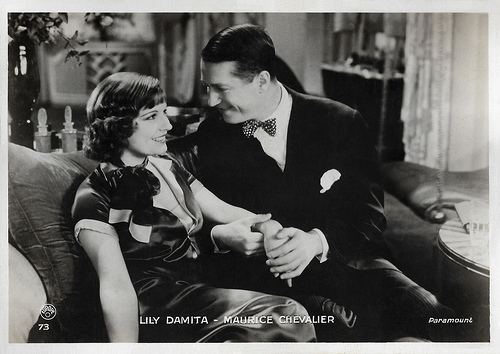
French postcard by Europe, no. 73. Photo: Paramount. Maurice Chevalier and Lily Damita in Une heure près de toi (George Cukor, Ernst Lubitsch, 1932), the French language version of One Hour With You.
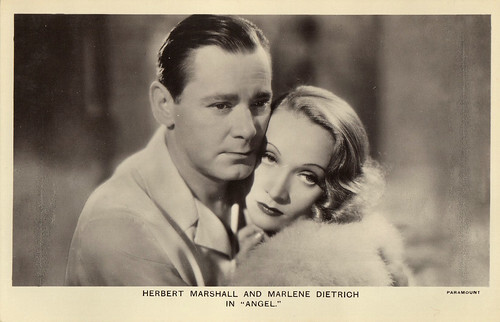
Dutch postcard by M. Bonnist & Zonen, Amsterdam, no. B 480. Photo: Paramount. Herbert Marshall and Marlene Dietrich in Angel (Ernst Lubitsch, 1937). Collection: Marlene Pilaete.
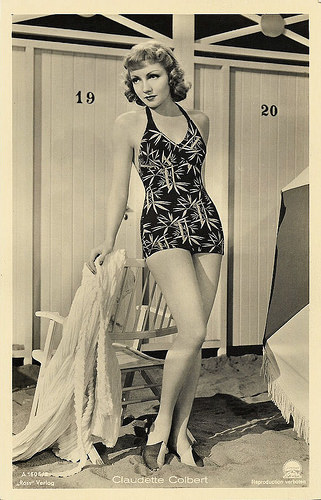
German postcard by Ross Verlag, no. 1606/2, 1937-1938. Photo: Paramount. Publicity still for Bluebeard's Eighth Wife (Ernst Lubitsch, 1938) with Claudette Colbert .
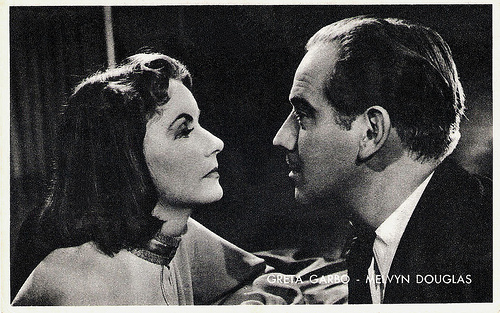
Belgian collector's card by Kwatta, no. C 181. Photo: MGM. Publicity still for Ninotschka (Ernst Lubitsch, 1939) with Greta Garbo and Melvyn Douglas .
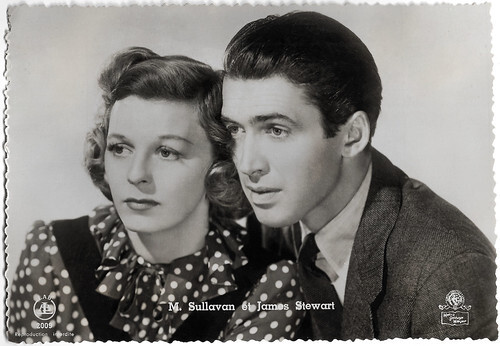
Belgian postcard by Les Editions d'Art L.A.B., Bruxelles, no. 2009. Photo: Metro-Goldwyn-Mayer. Margaret Sullavan and James Stewart in The Shop Around the Corner (Ernst Lubitsch, 1940). The French title was Rendez-vous.
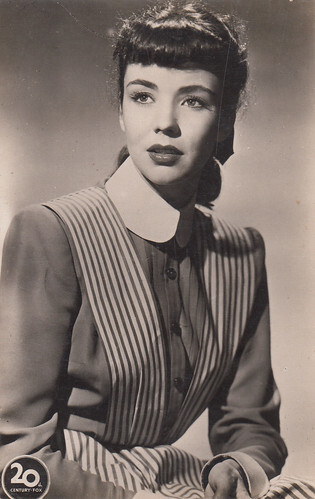
Spanish postcard by C.M.B., no. 59. Photo: 20th Century Fox. Jennifer Jones in Cluny Brown (Ernst Lubitsch, 1946). Collection: Marlene Pilaete.
Meyer aus Berlin/Meyer from Berlin (Ernst Lubitsch, 1919). Source: Bob Toomey (YouTube).
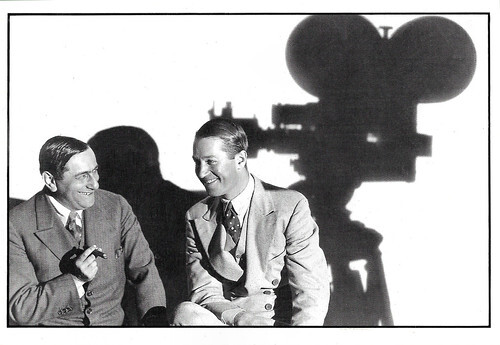
French postcard in the Entr'acte series by Éditions Asphodèle. Mâcon, no. 003/9 Photo: Ernst Lubitschand Maurice Chevalier at the set of The Love Parade (Ernst Lubitsch, 1929). Caption: Director Ernst Lubitsch and Maurice Chevalier in the shadow of the cameras, during the shooting of the first talking operetta on the screen.
Sources: Ephraim Katz (The Film Encyclopedia), (IMDb), Wikipedia and .
(*) Marlene Pilaete solved the puzzle: "The other actors on the card printed by N.V. Ned Reklamefabriek are Betty Compson and George Bancroft in the Paramount movie The Docks of New York. Could you please ask Van Houten to send me the Philips radio?" No problem at all, Marlene.

German postcard by Ross Verlag, no. 415/1, 1919-1924. Photo: Rembrandt.

German postcard by Verlag Hermann Leiser, Berlin-Wilm., no. 1926. Photo: Fritz Richard. Collection: Didier Hanson.

German postcard by Photochemie, no. K. 1743. Photo: Alex Binder, Paris. Collection: Marlene Pilaete.

German postcard by Ross Verlag, Berlin, no. 581/4, 1919-1924. Photo: B.B.B. Collection: Didier Hanson. Ernst Lubitsch with Douglas Fairbanks , Charlie Chaplin and Mary Pickford .

German postcard by Ross Verlag, no. 581/5, 1919-1924. Photo: B.B.B. Collection: Didier Hanson. Ernst Lubitsch with Charlie Chaplin , Mary Pickford and Douglas Fairbanks .

German postcard by Ross Verlag, no. 7376/1, 1932-1933. Photo: Paramount. Ernst Lubitsch with Harold Lloyd .
Ethnic Jewish humour
Ernst Lubitsch was born in Berlin, Germany, in 1892. He was the son of Anna (née Lindenstaedt) and Simon Lubitsch, a prosperous tailor. His family was Ashkenazi Jewish, his father was born in Grodno and his mother came from Wriezen (Oder), outside Berlin. Ernst was drawn to the stage while participating in plays staged by the Sophien Gymnasium, his Berlin high school, which he quit at 16.
To satisfy both his own urge to act and his father's desire that he take over the family business, he began leading a double life, working as a bookkeeper at his father's store by day and appearing in cabarets and music halls by night. By 1911, he was a member of Max Reinhardt 's renowned Deutsches Theater, where he quickly advanced from bit parts to character leads. To supplement his income, Lubitsch took a job in 1912 as an apprentice and general-purpose handyman at Berlin's Bioscope film studios and learned silent film acting.
Lubitsch made his film debut in Die ideale Gattin/The Ideal Wife (Hanns Heinz Ewers, Marc Henry, 1913) with Lyda Salmanova . The comedy Die Firma heiratet/The Firm Weds (Carl Wilhelm, 1913) with Albert Paulig , and its sequel Der Stolz der Firma/The Pride of the Firm (Carl Wilhelm, 1914) turned him into a popular comedian. Till 1920, he acted in approximately thirty films. Lubitsch appeared in a series of very successful film comedies as a character named Meyer in which he emphasised ethnic Jewish humour, including Meyer auf der Alm (?, 1913), and Meyer Als Soldat/Meyer as Soldier (?, 1914).
In 1914 he began to write and direct his own films. His first film as a director was Fräulein Seifenschaum/Miss Soapsuds (1914) and he established his reputation as a director, writer, producer and comedian with the foundation of the Malu-Film company, together with the actor Ernst Matráy .
He made his mark as a serious director with the drama Die Augen der Mumie Ma/The Eyes of the Mummy (Ernst Lubitsch, 1918), starring Pola Negri . He gradually abandoned acting to concentrate on directing and his last film appearance was opposite Pola Negri and Paul Wegener in the drama Sumurun (Ernst Lubitsch, 1920).

With Ossi Oswalda . German postcard by Ross Verlag, Berlin, no. 337/1, 1919-1924. Photo: Zander & Labisch.

German postcard by Photochemie, no. K. 1983. Photo: Union Film. Publicity still for Der Blusen-König (Ernst Lubitsch, 1917). Collection: Didier Hanson.

German postcard by Photochemie, Berlin, no. K. 1999. Photo: Union Film. Ossi Oswalda and Hermann Thimig in the Ossi's Tagebuch (Ernst Lubitsch, 1917).

German postcard by Ross Verlag, no. 614/1. Photo: Union. Asta Nielsen and Alfred Abel in Rausch/Intoxication (Ernst Lubitsch, 1919).

Henny Porten as Anna Boleyn in Anna Boleyn (1920). German postcard by Ross Verlag, Berlin, no. 645/3, 1919-1924. Photo: Union Film.

German postcard by Ross Verlag, no. 581/2, 1919-1924. Photo: B.B.B. Collection: Didier Hanson. Ernst Lubitsch with Mary Pickford .

German postcard by Ross Verlag, no. 1523/3, 1927-1928. Photo: Parufamet. Pola Negri in Forbidden Paradise (Ernst Lubitsch, 1924).
Grand Master
As a director, Ernst Lubitsch alternated between escapist comedies and large-scale historical dramas, enjoying great international success with both. A triumph was Die Austernprinzessin/The Oyster Princess (Ernst Lubitsch, 1919), featuring Ossi Oswalda , a sparkling satire caricaturing American manners.
Ephraim Katz in The Film Encyclopedia : "For the first time he demonstrated the subtle humour and the virtuoso visual wit that would in time become known as 'the Lubitsch Touch'. The style was characterised by a parsimonious compression of ideas and situations into single shots or brief scenes that provided an ironic key to the characters and to the meaning of the entire film."
His reputation as a grand master of world cinema reached a new peak after the release of his spectacles Madame DuBarry/Passion (Ernst Lubitsch, 1919) with Pola Negri , and Anna Boleyn/Deception (Ernst Lubitsch, 1920) starring Henny Porten and Emil Jannings .
Both of these films found American distributorship by early 1921. Madame Du Barry and Anna Boleyn, along with his Carmen/Gypsy Blood (Ernst Lubitsch, 1921) were selected by The New York Times on its list of the 15 most important movies of 1921.
With glowing reviews under his belt, and American money flowing his way, Lubitsch formed his own production company and made the high-budget spectacular Das Weib des Pharao/The Loves of Pharaoh (Ernst Lubitsch, 1921). In 1922, he married Helene Kraus. They divorced in 1931.

German postcard by Photochemie, Berlin, no. K. 2008. Photo: Union-Film. Publicity still for Wenn vier dasselbe tun/When Four Do the Same (Ernst Lubitsch, 1917), starring Ossi Oswalda as the girl, Fritz Schulz (here on the left) as her lover, and Emil Jannings as her father (here on the right).

German postcard by Photochemie, Berlin, no. K. 2012. Photo: Union Film. Publicity still for Prinz Sami/Prince Sami (Ernst Lubitsch, 1918). Collection: Didier Hanson.

German postcard by Photochemie, Berlin, no. K. 2835. Photo: publicity still for Die Augen der Mumie Ma/The Eyes of the Mummy (Ernst Lubitsch, 1918) with Pola Negri . Collection: Didier Hanson.

German postcard by Ross Verlag, Berlin, no. 611/2. Photo: Union / Ufa. Publicity still for Die Austernprinzessin/The Oyster Princess (Ernst Lubitsch, 1919) with Victor Janson .

German postcard by Ross Verlag, no. 627/6. Photo: Union Film. Publicity still of Reinhold Schünzel and Pola Negri in Madame DuBarry (Ernst Lubitsch, 1919). After the death of King Louis XV ( Emil Jannings ), his minister Choiseul (Schünzel) chases DuBarry (Negri) from the Royal palace.
Hollywood
Ernst Lubitsch's success in Europe brought him to the shores of America to promote Das Weib des Pharao/The Loves of Pharaoh (1922) and he got acquainted with the thriving US film industry. Lubitsch returned briefly to Germany but soon left for good for Hollywood.
He was contracted by Mary Pickford , who wanted him to direct her in Dorothy Vernon of Haddon Hall. Upon arrival, he rejected the project and instead, he directed her in Rosita (1923). The director and star clashed during its filming. While the result was deemed a failure from her point of view, it was a critical and commercial success. It ended up as the only project that they made together.
A free agent after just one American film, Lubitsch was signed to a remarkable three-year, six-picture contract by Warner Brothers that guaranteed the director his choice of both cast and crew and full editing control over the final cut. Settling in America, Lubitsch established his reputation for sophisticated comedy with such stylish films as The Marriage Circle (1924), Lady Windermere's Fan (1925), and So This Is Paris (1926).
Ephraim Katz: "Lubitsch grasped the American psychology with an amazing accuracy and focused his satire on two main themes - sex and money. With characteristic laconic wit, he depicted sex as a frivolous pastime, a sophisticated game moneyed people play to occupy their hours of leisure. To be safe, he set his plots against foreign backgrounds - Paris, Vienna, Budapest - or some mythical land, but the implication was clearly American and audiences rarely failed to recognize themselves or their friends, their manners, their foibles, their weaknesses."
But his films were only marginally profitable for Warner Brothers, and Lubitsch's contract was eventually dissolved by mutual consent, with MGM-Paramount buying out the remainder. His first film for MGM, The Student Prince in Old Heidelberg (1927) with Ramon Novarro , was well-regarded but also lost money.

German postcard by Ross Verlag, Berlin, no. 635/5, 1919-1924. Photo: Union. Publicity still for Die Puppe/The Doll (Ernst Lubitsch, 1919) with Ossi Oswalda and Hermann Thimig .

German postcard by Ross Verlag, no. 636/4. Photo: Maxim Film. Publicity still for Romeo und Julia im Schnee/Romeo and Juliet in the Snow (Ernst Lubitsch, 1920), with Lotte Neumann (Julia) and Gustav von Wangenheim (Romeo Montekugerl).

German postcard by Ross Verlag, no. 636/1. Photo: Maxim Film. Lotte Neumann in the comedy Romeo und Julia im Schnee/Romeo and Juliet in the Snow (Ernst Lubitsch, 1920). The man on the left dressed as an antique hero could be Julius Falkenstein as Paris. The others are from left to right Jakob Tiedtke (Herr Capulethofer), Marga Köhler (his wife), Lotte Neumann (Julia) and Gustav von Wangenheim (Romeo Montekugerl).

German postcard by Ross Verlag no. 639/5. Photo: Messter-Film. Publicity still for Kohlhiesels Töchter/Kohlhiesel's Daughters (Ernst Lubitsch, 1920) with Emil Jannings and Henny Porten .

German postcard by Ross Verlag, no. 645/8. Photo: Union Film. Henny Porten in Anna Boleyn/Deception (Ernst Lubitsch, 1920).

German postcard by Ross Verlag, Berlin, no. 760/5. Photo: Alex Binder. Publicity still for Die Bergkatze/Wildcat (Ernst Lubitsch, 1921) with Pola Negri .

German postcard by Ross Verlag, Berlin, no. 832/1, 1919-1924. Union Film. Publicity still for Sumurun (Ernst Lubitsch, 1920) with Jenny Hasselqvist aka Jenny Hasselquist.
Musicals
Ernst Lubitsch seized upon the advent of talkies to direct musicals. With his first sound film, The Love Parade (1929), starring Maurice Chevalier and Jeanette MacDonald, Lubitsch hit his stride as a maker of worldly musical comedies and earned himself another Oscar nomination.
While most of Lubitsch's silent films had been made for Warner Bros., most of his early sound pictures were for Paramount. The Love Parade (1929), Monte Carlo (1930), and The Smiling Lieutenant (1931) were hailed by critics as masterpieces of the newly emerging musical genre. Lubitsch served on the faculty of the University of Southern California for a time.
His next film was a romantic comedy, written with Samson Raphaelson, Trouble in Paradise (1932). The cynical comedy was popular both with critics and with audiences. But it was a project that could only have been made before the enforcement of the Production Code, and after 1935, Trouble in Paradise was withdrawn from circulation. It was not seen again until 1968.
Ernst Lubitsch continued to specialise in comedy, whether with music, as in MGM's opulent The Merry Widow (1934) and Paramount's One Hour with You (1932), or without, as in Design for Living (1933). He made only one other dramatic film, the anti-war film Broken Lullaby/The Man I Killed (1932).
In 1935, he was appointed Paramount's production manager, thus becoming the only major Hollywood director to run a large studio. But Lubitsch had trouble delegating authority, which was a problem when he was overseeing sixty different films. He was fired after a year on the job and returned to full-time moviemaking.

German postcard by Ross Verlag, no. 838/1. Photo: Terra Film A.G., Berlin. Mary Pickford in Rosita (Ernst Lubitsch, 1923).

Italian postcard, no. 134. Photo: Films Paramount, Roma. Pola Negri in Forbidden Paradise (Ernst Lubitsch, 1924), launched in Italy as La Czarina.

Ramon Novarro and Norma Shearer . German postcard by Ross Verlag, no. 98/6. Photo: Metro-Goldwyn-Mayer. Publicity still for The Student Prince in Old Heidelberg (Ernst Lubitsch, 1927).

German postcard by Ross Verlag, no. 98/9. Photo: Metro-Goldwyn-Mayer. Ramon Novarro in The Student Prince in Old Heidelberg (Ernst Lubitsch, 1927).

French postcard by A.N. [Noyer], Paris, no. 397. Photo: Paramount. Emil Jannings in The Patriot (Ernst Lubitsch, 1928).

German postcard by Ross Verlag, no. 4030/1, 1929-1930. Photo: United Artists. Camilla Horn and John Barrymore in Eternal Love (Ernst Lubitsch, 1929).

French postcard by Cinémagazine Edition, Paris, no. 794. Photo: Paramount. Publicity still for The Love Parade (Ernst Lubitsch, 1929) with Maurice Chevalier and Jeanette MacDonald.

Dutch-Belgian promotion card for Cacao Van Houten, no. 11 and 12. Printed by N.V. Ned Reclamefabriek. This card was part of a series of promo cards for a quiz by Van Houten Chocolate. The public had to go to stores to guess which film star was in the photo in the shop window. There were 24 photos. At the right, we recognised (with the help of a former owner of the card Jack Buchanan and Jeanette MacDonald in Monte Carlo (Ernst Lubitsch, 1930). But who are the actors in the other picture? Name also the title of the film and the production company. In the past you could win a Philips Radio... (*)

Maurice Chevalier and Miriam Hopkins . German postcard by Ross Verlag, no. 5976/1, 1931-1932. Photo: Paramount. Publicity still for The Smiling Lieutenant (Ernst Lubitsch, 1931).
Garbo laughs!
In 1935 he married his second wife, British actress Vivian Gaye. They had one daughter, Nicola Lubitsch in 1938. In 1936, he became a naturalised US citizen. Lubitsch moved to MGM and directed Greta Garbo in Ninotchka (1939). The famously serious actress' laughing scene in this satirical comedy was heavily promoted by studio publicists with the tagline "Garbo Laughs!"
In 1940, Lubitsch directed The Shop Around the Corner, an artful comedy of cross purposes. The film reunited Lubitsch with his Merry Widow screenwriter Raphaelson and starred James Stewart and Margaret Sullavan as a pair of bickering co-workers in Budapest, each unaware that the other is their secret romantic correspondent.
Lubitsch went independent to direct That Uncertain Feeling (1941, a remake of his 1925 film Kiss Me Again), and the dark anti-Nazi farce To Be or Not to Be (1942). William McPeak at IMDb on To Be or Not to Be (1942): "a biting satire of Nazi tyranny that also poked fun at Lubitsch's own theater roots with the problems and bickering - but also the triumph - of a somewhat raggedy acting troupe in Warsaw during the Nazi occupation. Jack Benny's perfect deadpan humor worked well with the zany vivaciousness of Carole Lombard , and a cast of veteran character actors from both Hollywood and Lubitsch's native Germany provided all the chemistry needed to make this a classic comedy, as well as a fierce statement against the perpetrators of war."
A heart condition curtailed his activity, and he spent much of his time in supervisory capacities. His next film, Heaven Can Wait (1943) was another Raphaelson collaboration. Then, Lubitsch worked with Edwin Justus Mayer on the scripting process of A Royal Scandal (1945), a remake of Lubitsch's silent film A Forbidden Paradise. The script was written and prepared under Lubitsch, and he was the original director of this film and directed the rehearsals. He became ill during the shooting, so he hired Otto Preminger, another disciple of Max Reinhardt 's Viennese theatre work, to do the rest of the shooting.
After A Royal Scandal, Lubitsch regained his health, and directed Cluny Brown (1946), with Charles Boyer and Jennifer Jones . In 1947, he was awarded a Special Academy Award. Ernst Lubitsch died later that year in Hollywood of a heart attack, his sixth. He was 55. His last film, That Lady in Ermine (1948) with Betty Grable , was completed by Otto Preminger and released posthumously.

German postcard by Ross Verlag, no. 6732/1, 1931-1932. Photo: Paramount. Publicity still for One Hour with You (Ernst Lubitsch, 1932) with Roland Young, Genevieve Tobin, Jeanette MacDonald, and Maurice Chevalier .

French postcard by Europe, no. 73. Photo: Paramount. Maurice Chevalier and Lily Damita in Une heure près de toi (George Cukor, Ernst Lubitsch, 1932), the French language version of One Hour With You.

Dutch postcard by M. Bonnist & Zonen, Amsterdam, no. B 480. Photo: Paramount. Herbert Marshall and Marlene Dietrich in Angel (Ernst Lubitsch, 1937). Collection: Marlene Pilaete.

German postcard by Ross Verlag, no. 1606/2, 1937-1938. Photo: Paramount. Publicity still for Bluebeard's Eighth Wife (Ernst Lubitsch, 1938) with Claudette Colbert .

Belgian collector's card by Kwatta, no. C 181. Photo: MGM. Publicity still for Ninotschka (Ernst Lubitsch, 1939) with Greta Garbo and Melvyn Douglas .

Belgian postcard by Les Editions d'Art L.A.B., Bruxelles, no. 2009. Photo: Metro-Goldwyn-Mayer. Margaret Sullavan and James Stewart in The Shop Around the Corner (Ernst Lubitsch, 1940). The French title was Rendez-vous.

Spanish postcard by C.M.B., no. 59. Photo: 20th Century Fox. Jennifer Jones in Cluny Brown (Ernst Lubitsch, 1946). Collection: Marlene Pilaete.
Meyer aus Berlin/Meyer from Berlin (Ernst Lubitsch, 1919). Source: Bob Toomey (YouTube).

French postcard in the Entr'acte series by Éditions Asphodèle. Mâcon, no. 003/9 Photo: Ernst Lubitschand Maurice Chevalier at the set of The Love Parade (Ernst Lubitsch, 1929). Caption: Director Ernst Lubitsch and Maurice Chevalier in the shadow of the cameras, during the shooting of the first talking operetta on the screen.
Sources: Ephraim Katz (The Film Encyclopedia), (IMDb), Wikipedia and .
(*) Marlene Pilaete solved the puzzle: "The other actors on the card printed by N.V. Ned Reklamefabriek are Betty Compson and George Bancroft in the Paramount movie The Docks of New York. Could you please ask Van Houten to send me the Philips radio?" No problem at all, Marlene.
Published on January 10, 2024 22:00
January 9, 2024
The Emperor’s New Groove (2000)
The animated comedy The Emperor's New Groove (Mark Dindal, 2000) was the 40th feature-length animation film from the Walt Disney Company. Inspired by ancient Peruvian culture and set in an Incan empire, the film follows young and self-centred Emperor Kuzco, who is accidentally transformed into a llama by his ex-advisor, Yzma, and her dim-witted but affable henchman, Kronk. The film differs from most other Disney films because of the Looney Tunes kind of humour.
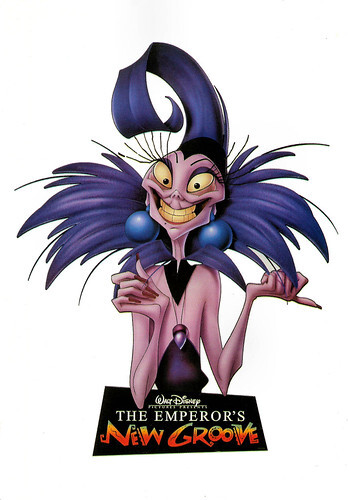
Vintage postcard in the Cinemascope Collection, no. 500. Image: Walt Disney Pictures. Image of Yzma for The Emperor's New Groove (Mark Dindal, 2000).
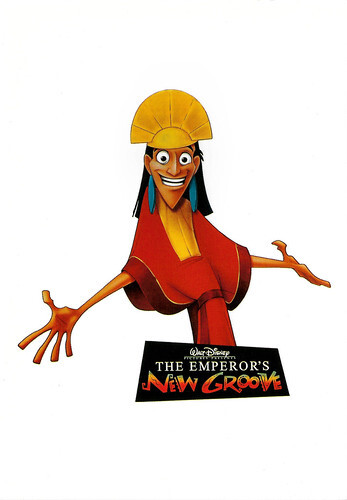
Vintage postcard in the Cinemascope Collection, no. 501. Image: Walt Disney Pictures. Image of Kuzco for The Emperor's New Groove (Mark Dindal, 2000).
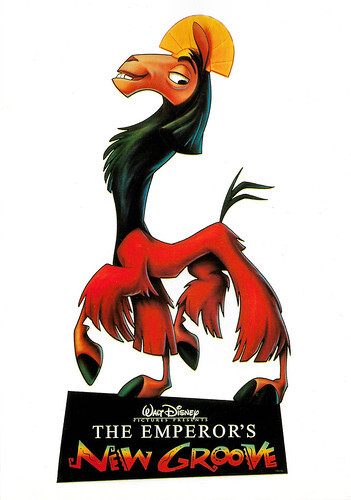
Vintage postcard in the Cinemascope Collection, no. 502. Image: Walt Disney Pictures. Image of Kuzco for The Emperor's New Groove (Mark Dindal, 2000).
A llama mourning in the pouring rain
The beginning of The Emperor's New Groove (Mark Dindal, 2000) shows a llama mourning in the jungle at night in the pouring rain. The llama reveals itself as the Kuzco, the 18-year-old arrogant and self-absorbed king of the Inca kingdom, who has been transformed into a llama.
Kuzco tells the viewer his backstory in a flashback. As an emperor, he was a very busy man who routinely punished anyone who disappointed him or "ruined his groove".
When he receives Patcha, a friendly farmer and village chief, he tells him that he plans to demolish his village to build himself a lavish summer holiday resort called "Kuzcotopia" just for himself for his birthday. This news leaves Patcha angry and desperate.
When Kuzco later fires his conniving advisor Yzma, she and the bumbling Kronk plot to take over the throne. The duo attempt to poison the king over dinner, but due to a mix-up with the labelling on Yzma's flask, they accidentally give him a potion that turns him into a llama. When the two beat Kuzco unconscious and put him in a sack, Yzma orders Kronk to kill him.
However, Kronk feels remorse and saves him, but loses the sack containing Kuzco, which lands on Patcha's wagon. Upon discovering the llama's true self, Pacha offers to help resolve the Emperor's problem and regain his throne, only if he promises to move his water park.
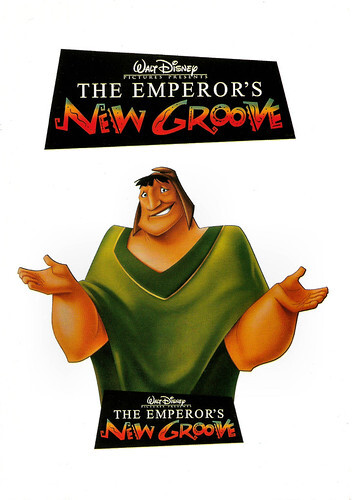
Vintage postcard in the Cinemascope Collection, no. 503. Image: Walt Disney Pictures. Image of Patcha for The Emperor's New Groove (Mark Dindal, 2000).
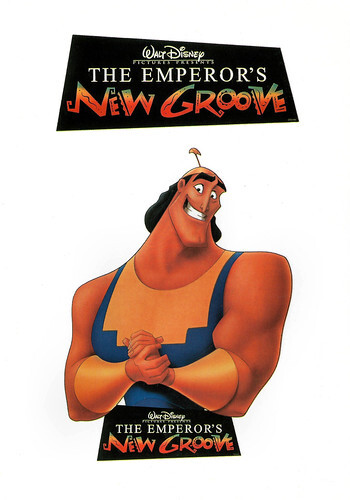
Vintage postcard in the Cinemascope Collection, no. 504. Image: Walt Disney Pictures. Image of Kronk for The Emperor's New Groove (Mark Dindal, 2000).
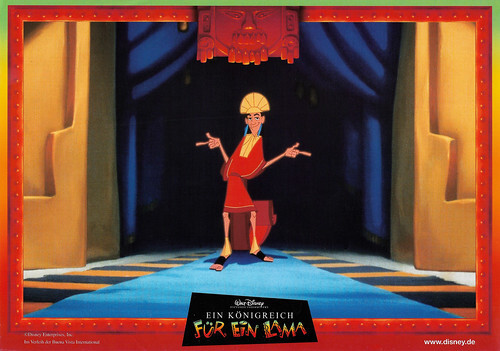
German lobby card by Buena Vista International. Image: Disney Enterprises Inc. Publicity still for The Emperor's New Groove (Mark Dindal, 2000). The German title was Ein Königreich für ein Lama.
A dramatic, sweeping Disney musical
The Emperor's New Groove (Mark Dindal, 2000) was originally planned to be a dramatic, sweeping Disney musical named 'Kingdom of the Sun', to be directed by Roger Allers, director of The Lion King (1994). Sting had written six original songs.
The film was essentially an Incan re-telling of Mark Twain's 'The Prince and the Pauper'. As Roger Allers's take on the movie was starting to take shape, Disney management was becoming increasingly uncomfortable with the movie, feeling it was too similar to the story of 'The Prince and the Pauper'. Test screenings generated poor feedback.
The production was suspended, even though the film was fifty per cent complete. Also because of the underwhelming box-office performances of Pocahontas (1995) and The Hunchback of Notre Dame (1996), Mark Dindal, director of Turner's Cats Don't Dance (1997), was brought in as co-director to add more comedic elements to the film.
Supervising animator Andreas Deja left the project and moved to Orlando, Florida to work on Lilo & Stitch (2002). Dindal and Allers did not get along and essentially both began making their separate versions of the film.
The Disney executives, although unhappy with Roger Allers's direction on the film held off from interfering with him, given that he had provided them with their biggest hit, The Lion King (1994), which too had had a troubled production. Also, most of Allers' crew were very loyal to their director.
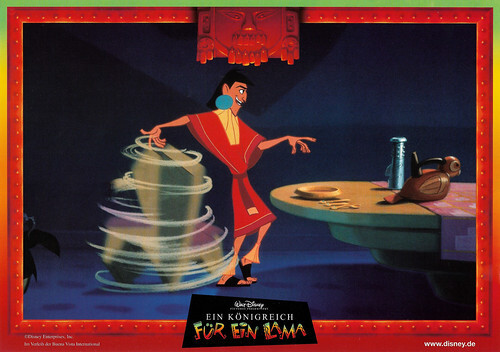
German lobby card by Buena Vista International. Image: Disney Enterprises Inc. Publicity still for The Emperor's New Groove (Mark Dindal, 2000). The German title was Ein Königreich für ein Lama.
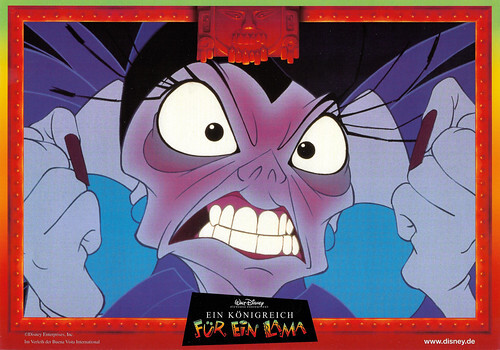
German lobby card by Buena Vista International. Image: Disney Enterprises Inc. Publicity still for The Emperor's New Groove (Mark Dindal, 2000). The German title was Ein Königreich für ein Lama.
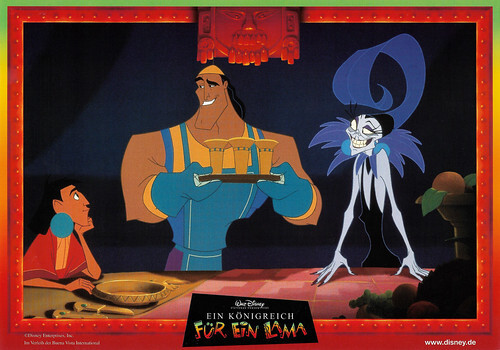
German lobby card by Buena Vista International. Image: Disney Enterprises Inc. Publicity still for The Emperor's New Groove (Mark Dindal, 2000). The German title was Ein Königreich für ein Lama.
A new, wackier film
By the summer of 1998, it was increasingly clear that Kingdom of the Sun was not going to make its summer 2000 release date. Merchandising tie-ins with McDonald's and Coca-Cola amongst others meant that the release date could not be moved. Director Roger Allers asked for a six-month extension to the release which was denied. Allers then quit the project.
With the film on the brink of total shutdown, co-director Mark Dindal worked on a retooling of the film. While he did this, most of his animators were reassigned to work on the Rhapsody in Blue segment of Fantasia 2000 (1999).
During the production hiatus, Dindal, producer Randy Fullmer, storyman Chris Williams, and screenwriter David Reynolds completely overhauled the film, eventually throwing out the 'Prince and the Pauper' angle, the completed footage, and all but one of Sting 's songs. The story was rebuilt from the ground up and Dindal created a new, wackier film that centred around the (talking) llama, Yzma, and two new characters: Pacha, and Kronk.
A documentary, The Sweatbox (2002), details the production troubles that The Emperor's New Groove endured during its six years of development. In 2000, The Emperor's New Groove received generally positive reactions but performed disappointingly at the box office compared to Disney films released in the 1990s, grossing $169.5 million on a $100-million budget.
However, the film found larger success when it was released for home media, and became the best-selling DVD of 2001. In the years since its release, The Emperor's New Groove garnered a cult following among fans. In 2005, there was a sequel or spin-off, the direct-to-video animated musical Kronk's New Groove (Elliot M. Bour, Saul Andrew Blinkoff, 2005).
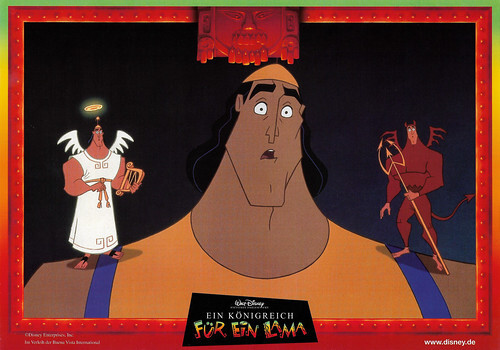
German lobby card by Buena Vista International. Image: Disney Enterprises Inc. Publicity still for The Emperor's New Groove (Mark Dindal, 2000). The German title was Ein Königreich für ein Lama.
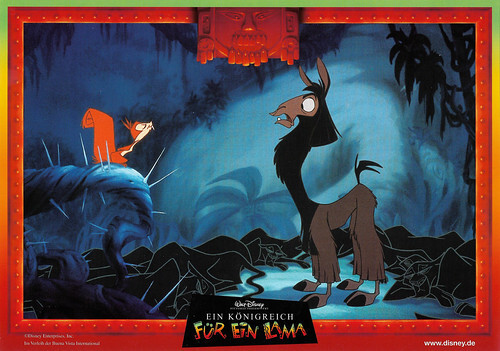
German lobby card by Buena Vista International. Image: Disney Enterprises Inc. Publicity still for The Emperor's New Groove (Mark Dindal, 2000). The German title was Ein Königreich für ein Lama.
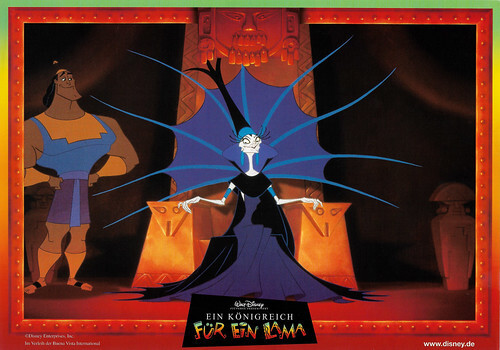
German lobby card by Buena Vista International. Image: Disney Enterprises Inc. Publicity still for The Emperor's New Groove (Mark Dindal, 2000). The German title was Ein Königreich für ein Lama.
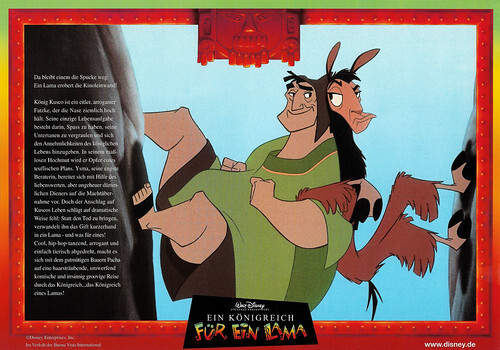
German lobby card by Buena Vista International. Image: Disney Enterprises Inc. Publicity still for The Emperor's New Groove (Mark Dindal, 2000). The German title was Ein Königreich für ein Lama.
Sources: Wikipedia (English, Dutch and German) and IMDb.

Vintage postcard in the Cinemascope Collection, no. 500. Image: Walt Disney Pictures. Image of Yzma for The Emperor's New Groove (Mark Dindal, 2000).

Vintage postcard in the Cinemascope Collection, no. 501. Image: Walt Disney Pictures. Image of Kuzco for The Emperor's New Groove (Mark Dindal, 2000).

Vintage postcard in the Cinemascope Collection, no. 502. Image: Walt Disney Pictures. Image of Kuzco for The Emperor's New Groove (Mark Dindal, 2000).
A llama mourning in the pouring rain
The beginning of The Emperor's New Groove (Mark Dindal, 2000) shows a llama mourning in the jungle at night in the pouring rain. The llama reveals itself as the Kuzco, the 18-year-old arrogant and self-absorbed king of the Inca kingdom, who has been transformed into a llama.
Kuzco tells the viewer his backstory in a flashback. As an emperor, he was a very busy man who routinely punished anyone who disappointed him or "ruined his groove".
When he receives Patcha, a friendly farmer and village chief, he tells him that he plans to demolish his village to build himself a lavish summer holiday resort called "Kuzcotopia" just for himself for his birthday. This news leaves Patcha angry and desperate.
When Kuzco later fires his conniving advisor Yzma, she and the bumbling Kronk plot to take over the throne. The duo attempt to poison the king over dinner, but due to a mix-up with the labelling on Yzma's flask, they accidentally give him a potion that turns him into a llama. When the two beat Kuzco unconscious and put him in a sack, Yzma orders Kronk to kill him.
However, Kronk feels remorse and saves him, but loses the sack containing Kuzco, which lands on Patcha's wagon. Upon discovering the llama's true self, Pacha offers to help resolve the Emperor's problem and regain his throne, only if he promises to move his water park.

Vintage postcard in the Cinemascope Collection, no. 503. Image: Walt Disney Pictures. Image of Patcha for The Emperor's New Groove (Mark Dindal, 2000).

Vintage postcard in the Cinemascope Collection, no. 504. Image: Walt Disney Pictures. Image of Kronk for The Emperor's New Groove (Mark Dindal, 2000).

German lobby card by Buena Vista International. Image: Disney Enterprises Inc. Publicity still for The Emperor's New Groove (Mark Dindal, 2000). The German title was Ein Königreich für ein Lama.
A dramatic, sweeping Disney musical
The Emperor's New Groove (Mark Dindal, 2000) was originally planned to be a dramatic, sweeping Disney musical named 'Kingdom of the Sun', to be directed by Roger Allers, director of The Lion King (1994). Sting had written six original songs.
The film was essentially an Incan re-telling of Mark Twain's 'The Prince and the Pauper'. As Roger Allers's take on the movie was starting to take shape, Disney management was becoming increasingly uncomfortable with the movie, feeling it was too similar to the story of 'The Prince and the Pauper'. Test screenings generated poor feedback.
The production was suspended, even though the film was fifty per cent complete. Also because of the underwhelming box-office performances of Pocahontas (1995) and The Hunchback of Notre Dame (1996), Mark Dindal, director of Turner's Cats Don't Dance (1997), was brought in as co-director to add more comedic elements to the film.
Supervising animator Andreas Deja left the project and moved to Orlando, Florida to work on Lilo & Stitch (2002). Dindal and Allers did not get along and essentially both began making their separate versions of the film.
The Disney executives, although unhappy with Roger Allers's direction on the film held off from interfering with him, given that he had provided them with their biggest hit, The Lion King (1994), which too had had a troubled production. Also, most of Allers' crew were very loyal to their director.

German lobby card by Buena Vista International. Image: Disney Enterprises Inc. Publicity still for The Emperor's New Groove (Mark Dindal, 2000). The German title was Ein Königreich für ein Lama.

German lobby card by Buena Vista International. Image: Disney Enterprises Inc. Publicity still for The Emperor's New Groove (Mark Dindal, 2000). The German title was Ein Königreich für ein Lama.

German lobby card by Buena Vista International. Image: Disney Enterprises Inc. Publicity still for The Emperor's New Groove (Mark Dindal, 2000). The German title was Ein Königreich für ein Lama.
A new, wackier film
By the summer of 1998, it was increasingly clear that Kingdom of the Sun was not going to make its summer 2000 release date. Merchandising tie-ins with McDonald's and Coca-Cola amongst others meant that the release date could not be moved. Director Roger Allers asked for a six-month extension to the release which was denied. Allers then quit the project.
With the film on the brink of total shutdown, co-director Mark Dindal worked on a retooling of the film. While he did this, most of his animators were reassigned to work on the Rhapsody in Blue segment of Fantasia 2000 (1999).
During the production hiatus, Dindal, producer Randy Fullmer, storyman Chris Williams, and screenwriter David Reynolds completely overhauled the film, eventually throwing out the 'Prince and the Pauper' angle, the completed footage, and all but one of Sting 's songs. The story was rebuilt from the ground up and Dindal created a new, wackier film that centred around the (talking) llama, Yzma, and two new characters: Pacha, and Kronk.
A documentary, The Sweatbox (2002), details the production troubles that The Emperor's New Groove endured during its six years of development. In 2000, The Emperor's New Groove received generally positive reactions but performed disappointingly at the box office compared to Disney films released in the 1990s, grossing $169.5 million on a $100-million budget.
However, the film found larger success when it was released for home media, and became the best-selling DVD of 2001. In the years since its release, The Emperor's New Groove garnered a cult following among fans. In 2005, there was a sequel or spin-off, the direct-to-video animated musical Kronk's New Groove (Elliot M. Bour, Saul Andrew Blinkoff, 2005).

German lobby card by Buena Vista International. Image: Disney Enterprises Inc. Publicity still for The Emperor's New Groove (Mark Dindal, 2000). The German title was Ein Königreich für ein Lama.

German lobby card by Buena Vista International. Image: Disney Enterprises Inc. Publicity still for The Emperor's New Groove (Mark Dindal, 2000). The German title was Ein Königreich für ein Lama.

German lobby card by Buena Vista International. Image: Disney Enterprises Inc. Publicity still for The Emperor's New Groove (Mark Dindal, 2000). The German title was Ein Königreich für ein Lama.

German lobby card by Buena Vista International. Image: Disney Enterprises Inc. Publicity still for The Emperor's New Groove (Mark Dindal, 2000). The German title was Ein Königreich für ein Lama.
Sources: Wikipedia (English, Dutch and German) and IMDb.
Published on January 09, 2024 22:00
January 7, 2024
Noëlle Adam
Beautiful Noëlle Adam (1933) was a French ballet dancer and actress. She frequently co-starred with comic genius Louis De Funès, and later with her husband, Serge Reggiani.
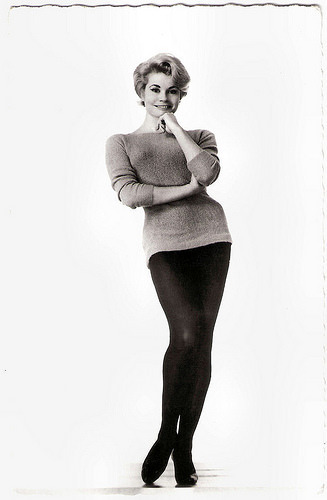
French postcard by Editions du Globe, Paris, no. 732. Photo: Sam Lévin .

French postcard by Editions P.I., Paris, offered by Les Carbones Korès "Carboplane", no. 921. Photo: Sam Lévin.
Beat Girl
Huguette Noëlle Adam was born in La Rochelle, France in 1933. She started out as a ballerina, and has been dancing since age 8.
In 1957, she made her film debut in the Louis de Funès comedy Comme un cheveu sur la soupe/Crazy in the Noodle (Maurice Régamey, 1957).
The following year, she played the female lead in another Louis de Funès farce, Ni vu, ni connu/Neither Seen Nor Recognized (Yves Robert, 1958).
In 1960, she married Sydney Chaplin. That year, she played a lead role in the British cult film Beat Girl (Edmond T. Gréville, 1960) opposite David Farrar and Christopher Lee . In Italy she appeared with Donald O’Connor in the fantasy Le meraviglie di Aladino/The Wonders of Aladdin (Mario Bava, Henry Levin, 1961).
In 1962, Noëlle was cast as Jeannette, a photographer's assistant, in the musical 'No Strings'. Richard Rodgers actually had the part largely rewritten once he had seen Noëlle. She had never sung before so he had her take singing lessons. While she was appearing in 'No Strings', her husband was at the same time appearing just down the street in 'Subways are for Sleeping'.
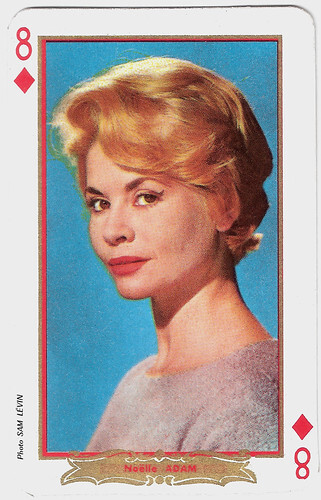
French playing card. Photo: Sam Lévin.
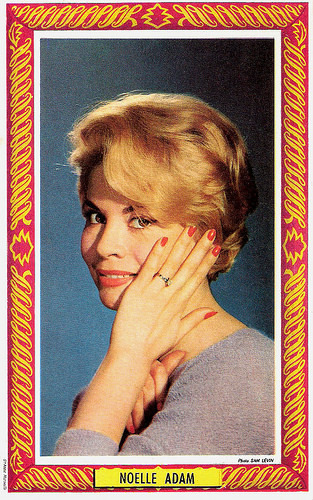
French postcard by St. Anne, Marseille. Photo: Sam Lévin .
Reggiani
In 1968, Noëlle Adam was back in France and played the mother of Josée ( Elisabeth Wiener ) in La prisonnière (Henri-Georges Clouzot, 1968) with Laurent Terzieff .
She co-starred again with Louis de Funès in L’homme d’Orchestre/The One Man Band (Serge Korber, 1970).
She played a supporting part in L'imprécateur/The Accuser (Jean Louis Bertucelli, 1977).
For more than thirty years she was the companion of Serge Reggiani. With him, she appeared in Reggiani’s son Simon’s film De force avec d'autres/Forced to Be with Others (Simon Reggiani, 1993).
Her last film role was in the short mystery Plus fort que tout/Stronger than any (Hugues Deniset, 1999), in which she again co-starred with Serge Reggiani . Reggiani and Adam eventually married in 2003, a year before his death.
Scene from L’homme d’Orchestre/The One Man Band (Serge Korber, 1970). Source: Succubian (YouTube).
Sources: Wikipedia (French), and .

French postcard by Editions du Globe, Paris, no. 732. Photo: Sam Lévin .

French postcard by Editions P.I., Paris, offered by Les Carbones Korès "Carboplane", no. 921. Photo: Sam Lévin.
Beat Girl
Huguette Noëlle Adam was born in La Rochelle, France in 1933. She started out as a ballerina, and has been dancing since age 8.
In 1957, she made her film debut in the Louis de Funès comedy Comme un cheveu sur la soupe/Crazy in the Noodle (Maurice Régamey, 1957).
The following year, she played the female lead in another Louis de Funès farce, Ni vu, ni connu/Neither Seen Nor Recognized (Yves Robert, 1958).
In 1960, she married Sydney Chaplin. That year, she played a lead role in the British cult film Beat Girl (Edmond T. Gréville, 1960) opposite David Farrar and Christopher Lee . In Italy she appeared with Donald O’Connor in the fantasy Le meraviglie di Aladino/The Wonders of Aladdin (Mario Bava, Henry Levin, 1961).
In 1962, Noëlle was cast as Jeannette, a photographer's assistant, in the musical 'No Strings'. Richard Rodgers actually had the part largely rewritten once he had seen Noëlle. She had never sung before so he had her take singing lessons. While she was appearing in 'No Strings', her husband was at the same time appearing just down the street in 'Subways are for Sleeping'.

French playing card. Photo: Sam Lévin.

French postcard by St. Anne, Marseille. Photo: Sam Lévin .
Reggiani
In 1968, Noëlle Adam was back in France and played the mother of Josée ( Elisabeth Wiener ) in La prisonnière (Henri-Georges Clouzot, 1968) with Laurent Terzieff .
She co-starred again with Louis de Funès in L’homme d’Orchestre/The One Man Band (Serge Korber, 1970).
She played a supporting part in L'imprécateur/The Accuser (Jean Louis Bertucelli, 1977).
For more than thirty years she was the companion of Serge Reggiani. With him, she appeared in Reggiani’s son Simon’s film De force avec d'autres/Forced to Be with Others (Simon Reggiani, 1993).
Her last film role was in the short mystery Plus fort que tout/Stronger than any (Hugues Deniset, 1999), in which she again co-starred with Serge Reggiani . Reggiani and Adam eventually married in 2003, a year before his death.
Scene from L’homme d’Orchestre/The One Man Band (Serge Korber, 1970). Source: Succubian (YouTube).
Sources: Wikipedia (French), and .
Published on January 07, 2024 22:00
January 6, 2024
Photo by Sahm
Atelier (Anton) Sahm, located in München (Munich) in Germany, produced portrait, fashion, theatre and nude photography. From the late 1910s till the 1960s many of Sahm's artists' portraits including pictures of many film stars were used for postcards.

German postcard by Verlag Ross, Berlin, no. 959/2, 1925-1926. Photo: Sahm, München (Munich) / Emelka.
Ellen Kürty a.k.a. Ellen Kürti (1903-1930) was a Hungarian-born actress who had a short career in the Hungarian and German silent cinema. Between 1920 and 1928, she appeared in both leading and supporting roles in over 20 silent films. In 1930, she probably committed suicide.
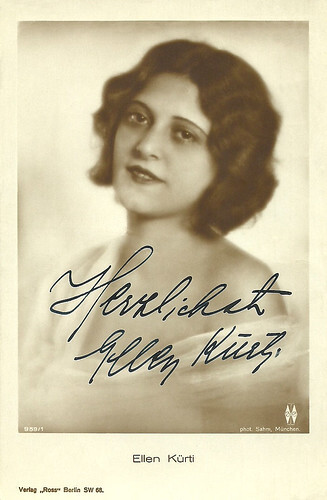
German postcard by Ross Verlag, Berlin, no. 959/1, 1925-1926. Photo: Sahm, München. Collection: Didier Hanson.
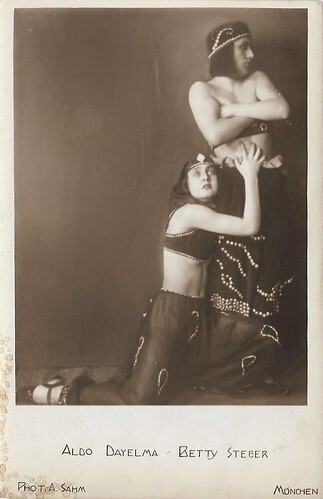
German postcard. Photo: A. Sahm, München (Munich). Dancers Aldo Dayelma and Betty Steger.
We couldn't find information on Betty Steger or Aldo Dayelma, but in the late 1920s and early 1930s, there was a famous Dayelma Ballet group, that performed e.g. at the Berlin Wintergarten. The later film actress Marianne Winkelstern was discovered among them by Erik Charell.

German postcard by Ross Verlag, Berlin, no. 1189/1, 1927-1928. Photo: Atelier Sahm, München (Munich) / Emelka. Bayern Films.
Himansu Rai (1895-1940) was one of the stars of early Indian cinema when India was still a part of the United Kingdom. He often worked with German director-producer Franz Osten. Later Rai became a producer.
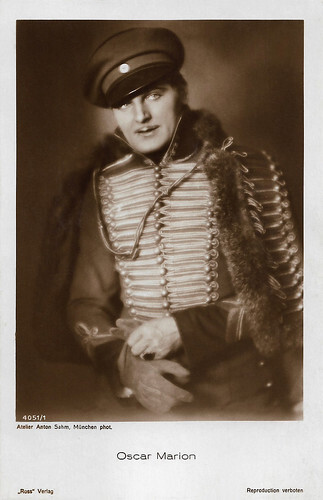
German postcard by Ross Verlag, no. 4051/1, 1929-1930. Photo: Atelier Anton Sahm, München (Munich). Oscar Marion in Waterloo (Karl Grune, 1929).
Oscar Marion (1894-1986) was an Austrian actor and production leader of the silent era and 1930s.
Who was Anton Sahm?
Anton Sahm (1891-1968) was a German-Austrian photographer who lived in Munich from 1919.
He was trained and had worked in Vienna, Budapest, Paris and Munich. Sahm was an apprentice of the well-known Viennese photographers Dora Kallmus (Madame D'Ora) and Carl Pietzner in the 1910s. From 1913 on, he was self-employed. In 1915, Sahm married the 19-year-old Charlotte Bénesi in the Kaisermühlen parish church in Vienna. They had two children.
From 1 February 1917, Sahm took part in the First World War as a pioneer in the Air Force and he received training as a "picture assistant" in the aerial photography department ("Lubia"). In 1919 he settled with his family in Munich and opened an 'Atelier' for portrait, fashion, theatre and nude photography in Türkenstraße 6. This studio became very well-known over the years, particularly in the 1920s.
He initially operated there under the name 'Wiener Kunst-Salon, Photo- und farbige Bildnisse'. Among the personalities he photographed, some of whose portraits Sahm also published as postcards by his own publishing house, were the opera singers Felicie Hüni-Mihacsek, Fritzi Jokl, Anny van Kruyswyk and Nelly Merz, the singers Peter Anders and Alfred Jerger, the conductors Karl Böhm and Paul Schmitz, the comedian Karl Valentin, the writers Hans Carossa and Max Brod, the poster artist Ludwig Hohlwein and Adolf Hitler's lover and later wife Eva Braun.
In 1961, the reasons for the special quality of Sahm's work were outlined in the trade magazine International Photo Technik. One photo shows Sahm during a meeting with the Spanish philosopher José Ortega y Gasset and also the portrait that was created. The simple surroundings and hardly any props in the studio allowed both the sitter and the photographer to concentrate fully on the jointly created portrait. After the death of Anton Sahm in 1968, his son Walter Sahm took over the studio in 1969, and after him Toni Sahm.
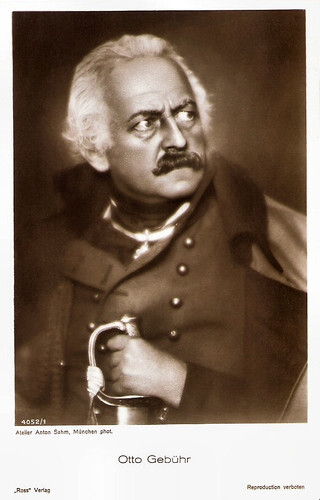
German postcard by Ross Verlag, no. 4052/1, 1929-1930. Photo: Anton Sahm, München.
German actor Otto Gebühr (1877-1954) appeared in 102 films between 1917 and 1962 (!). He is best known for his interpretation of Friedrich II (Frederick the Great), a role he played in 16 films and countless stage performances. He was one the most famous actors of the Weimar period, and thanks to his authoritative roles the Nazis gave him the title Actor of the State.
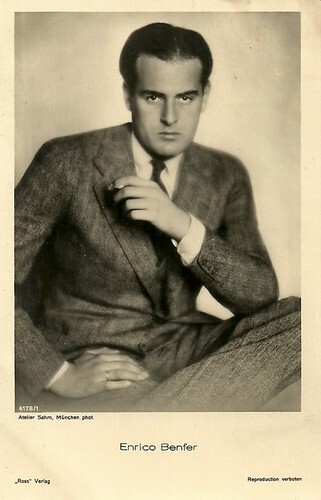
German postcard. by Ross Verlag, no. 6178/1, 1931-1932. Photo: Atelier Sahm, München.
Handsome Italian-German actor Enrico Benfer / Friedrich Benfer / Federico Benfer (1905-1996) worked in Germany as well as in Italy and other European countries. He often co-starred with his later wife, Jenny Jugo.
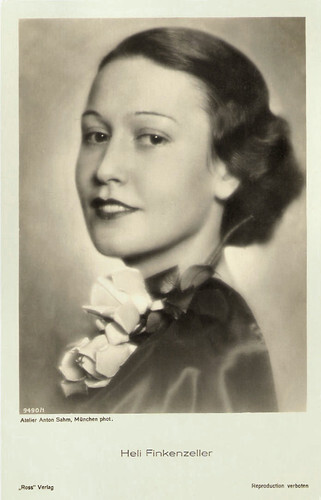
German postcard by Ross Verlag, no. 9490/1, 1935-1936. Photo: Atelier Anton Sahm, München.
German stage and film actress Heli Finkenzeller (1914-1991) had her greatest successes in popular Ufa comedies of the 1930s and 1940s. After the war, she often played mother roles.
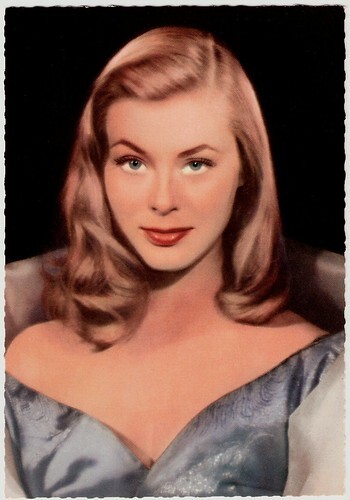
German postcard by ISV, no. H 1. Photo: Sahm.
In the 1950s and 1960s, attractive actress Marianne Hold (1933-1994) became the queen of the Heimatfilm - the romantic German film genre set in rural, especially Alpine, areas.
Source: Wikipedia (German).

German postcard by Verlag Ross, Berlin, no. 959/2, 1925-1926. Photo: Sahm, München (Munich) / Emelka.
Ellen Kürty a.k.a. Ellen Kürti (1903-1930) was a Hungarian-born actress who had a short career in the Hungarian and German silent cinema. Between 1920 and 1928, she appeared in both leading and supporting roles in over 20 silent films. In 1930, she probably committed suicide.

German postcard by Ross Verlag, Berlin, no. 959/1, 1925-1926. Photo: Sahm, München. Collection: Didier Hanson.

German postcard. Photo: A. Sahm, München (Munich). Dancers Aldo Dayelma and Betty Steger.
We couldn't find information on Betty Steger or Aldo Dayelma, but in the late 1920s and early 1930s, there was a famous Dayelma Ballet group, that performed e.g. at the Berlin Wintergarten. The later film actress Marianne Winkelstern was discovered among them by Erik Charell.

German postcard by Ross Verlag, Berlin, no. 1189/1, 1927-1928. Photo: Atelier Sahm, München (Munich) / Emelka. Bayern Films.
Himansu Rai (1895-1940) was one of the stars of early Indian cinema when India was still a part of the United Kingdom. He often worked with German director-producer Franz Osten. Later Rai became a producer.

German postcard by Ross Verlag, no. 4051/1, 1929-1930. Photo: Atelier Anton Sahm, München (Munich). Oscar Marion in Waterloo (Karl Grune, 1929).
Oscar Marion (1894-1986) was an Austrian actor and production leader of the silent era and 1930s.
Who was Anton Sahm?
Anton Sahm (1891-1968) was a German-Austrian photographer who lived in Munich from 1919.
He was trained and had worked in Vienna, Budapest, Paris and Munich. Sahm was an apprentice of the well-known Viennese photographers Dora Kallmus (Madame D'Ora) and Carl Pietzner in the 1910s. From 1913 on, he was self-employed. In 1915, Sahm married the 19-year-old Charlotte Bénesi in the Kaisermühlen parish church in Vienna. They had two children.
From 1 February 1917, Sahm took part in the First World War as a pioneer in the Air Force and he received training as a "picture assistant" in the aerial photography department ("Lubia"). In 1919 he settled with his family in Munich and opened an 'Atelier' for portrait, fashion, theatre and nude photography in Türkenstraße 6. This studio became very well-known over the years, particularly in the 1920s.
He initially operated there under the name 'Wiener Kunst-Salon, Photo- und farbige Bildnisse'. Among the personalities he photographed, some of whose portraits Sahm also published as postcards by his own publishing house, were the opera singers Felicie Hüni-Mihacsek, Fritzi Jokl, Anny van Kruyswyk and Nelly Merz, the singers Peter Anders and Alfred Jerger, the conductors Karl Böhm and Paul Schmitz, the comedian Karl Valentin, the writers Hans Carossa and Max Brod, the poster artist Ludwig Hohlwein and Adolf Hitler's lover and later wife Eva Braun.
In 1961, the reasons for the special quality of Sahm's work were outlined in the trade magazine International Photo Technik. One photo shows Sahm during a meeting with the Spanish philosopher José Ortega y Gasset and also the portrait that was created. The simple surroundings and hardly any props in the studio allowed both the sitter and the photographer to concentrate fully on the jointly created portrait. After the death of Anton Sahm in 1968, his son Walter Sahm took over the studio in 1969, and after him Toni Sahm.

German postcard by Ross Verlag, no. 4052/1, 1929-1930. Photo: Anton Sahm, München.
German actor Otto Gebühr (1877-1954) appeared in 102 films between 1917 and 1962 (!). He is best known for his interpretation of Friedrich II (Frederick the Great), a role he played in 16 films and countless stage performances. He was one the most famous actors of the Weimar period, and thanks to his authoritative roles the Nazis gave him the title Actor of the State.

German postcard. by Ross Verlag, no. 6178/1, 1931-1932. Photo: Atelier Sahm, München.
Handsome Italian-German actor Enrico Benfer / Friedrich Benfer / Federico Benfer (1905-1996) worked in Germany as well as in Italy and other European countries. He often co-starred with his later wife, Jenny Jugo.

German postcard by Ross Verlag, no. 9490/1, 1935-1936. Photo: Atelier Anton Sahm, München.
German stage and film actress Heli Finkenzeller (1914-1991) had her greatest successes in popular Ufa comedies of the 1930s and 1940s. After the war, she often played mother roles.

German postcard by ISV, no. H 1. Photo: Sahm.
In the 1950s and 1960s, attractive actress Marianne Hold (1933-1994) became the queen of the Heimatfilm - the romantic German film genre set in rural, especially Alpine, areas.
Source: Wikipedia (German).
Published on January 06, 2024 22:00
Paul van Yperen's Blog
- Paul van Yperen's profile
- 13 followers
Paul van Yperen isn't a Goodreads Author
(yet),
but they
do have a blog,
so here are some recent posts imported from
their feed.



